FROM JOHN O’ GROAT’S TO LAND’S END (OR 1372 MILES ON FOOT) My Great Great Grandfather, John Naylor and his brother Robert where the first people to walk from From John O Groat’s to Lands End in 1871. Read the book in full for free here on http://www.nearlyuphill.co.uk in chapters or download their 660 page book here – FROM JOHN O’ GROAT’S TO LAND’S END (OR 1372 MILES ON FOOT) All words are written by them and all pictures are taken from the original book which was written in 1916 by John Naylor.
SEVENTH WEEK’S JOURNEY — Oct. 30 to Nov. 5.
Castleton — Tideswell — Miller’s Dale — Flagg Moor — Newhaven — Tissington — Ashbourne ¶ River Dove — Mayfield — Ellastone — Alton Towers — Uttoxeter — Bagot’s Wood — Needwood Forest — Abbots Bromley — Handsacre ¶ Lichfield — Tamworth — Atherstone — Watling Street — Nuneaton ¶ Watling Street — High Cross — Lutterworth — River Swift — Fosse Way — Brinklow — Coventry ¶ Kenilworth — Leamington — Stoneleigh Abbey — Warwick — Stratford-on-Avon — Charlecote Park — Kineton — Edge Hill ¶ Banbury — Woodstock — Oxford ¶¶
SEVENTH WEEK’S JOURNEY
Monday, October 30th.
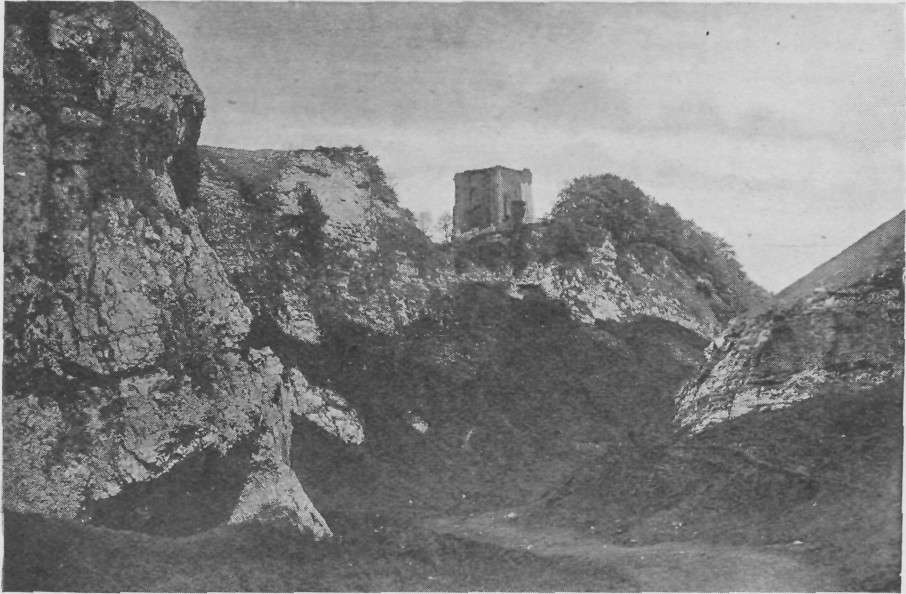
The Scots as a nation are proverbial for their travelling propensities; they are to be found not only in every part of the British Isles, but in almost every known and unknown part of the wide world. It was a jocular saying then in vogue that if ever the North Pole were discovered, a Scotsman would be found there sitting on the top! Sir Walter Scott was by no means behind his fellow countrymen in his love of travel, and like his famous Moss-troopers, whose raids carried them far beyond the Borders, even into foreign countries, he had not confined himself “to his own—his Native Land.” We were not surprised, therefore, wrhen we heard of him in the lonely neighbourhood of the Peak of Derbyshire, or that, although he had never been known to have visited the castle or its immediate surroundings, he had written a novel entitled Peveril of the Peak. This fact was looked upon as a good joke by his personal friends, who gave him the title of the book as a nickname, and Sir Walter, when writing to some of his most intimate friends, had been known to subscribe himself in humorous vein as “Peveril of the Peak.”
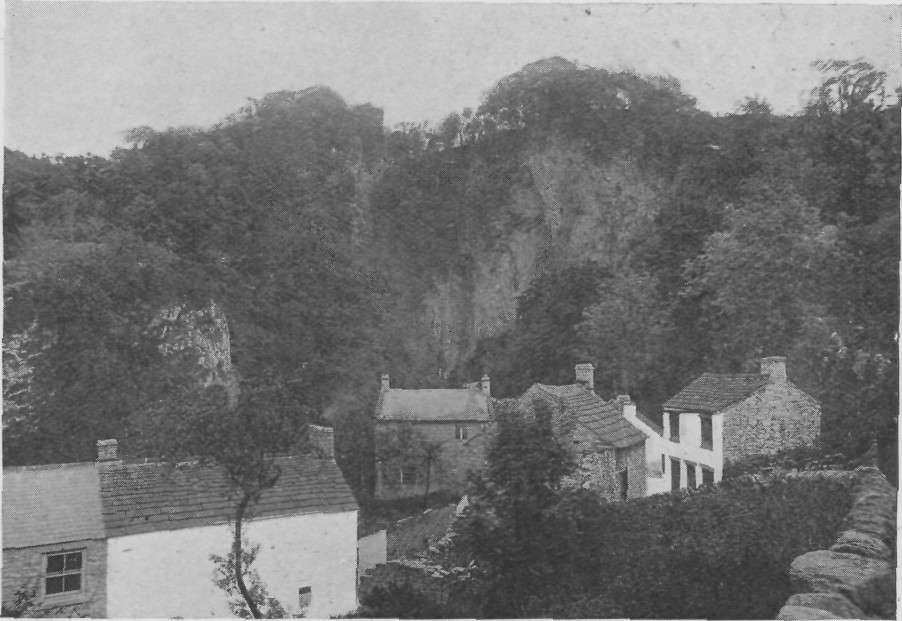
There were several objects of interest well worth seeing at Castleton besides the great cavern; there was the famous Blue John Mine, that took its name from the peculiar blue stone found therein, a kind of fibrous fluor-spar usually blue to purple, though with occasional black and yellow veins, of which ornaments were made and sold to visitors, and from which the large blue stone was obtained that formed the magnificent vase in Chatsworth House, the residence of the Duke of Devonshire, and in other noble mansions which possess examples of the craft. In the mine there were two caverns, one of them 100 feet and the other 150 feet high, “which glittered with sparkling stalactites.” Then there was the Speedwell Mine, one of the curiosities of the Peak, discovered by miners searching for ore, which they failed to find, although they laboured for years at an enormous cost. In boring through the rock, however, they came to a large natural cavern, now reached by descending about a hundred steps to a canal below, on which was a boat for conveying passengers to the other end of the canal, with only a small light or torch at the bow to relieve the stygian darkness. Visitors were landed on a platform to listen to a tremendous sound of rushing water being precipitated somewhere in the fearful and impenetrable darkness, whose obscurity and overpowering gloom could almost be felt. On the slope of the Eldon Hill there was also a fearful chasm called the Eldon Hole, where a falling stone was never heard to strike the bottom. This had been visited in the time of Queen Elizabeth by the Earl of Leicester, who caused an unfortunate native to be lowered into it to the full length of a long rope; when the poor fellow was drawn up again he was “stark mad,” and died eight days afterwards.
We had to leave all these attractions to a later visit, since we had come to Castleton to see the largest cavern of all, locally named the “Devil’s Hole,” but by polite visitors the “Peak Cavern.” The approach to the cavern was very imposing and impressive, perpendicular rocks rising on both sides to a great height, while Peveril Castle stood on the top of the precipice before us like a sentinel guarding entrance to the cavern, which was in the form of an immense Gothic arch 120 feet high, 42 feet wide, and said to be large enough to contain the Parish Church and all its belongings. This entrance, however, was being used as a rope-walk, where, early as it was, the workers were already making hempen ropes alongside the stream which flowed from the cavern, and the strong smell of hemp which prevailed as we stood for a few minutes watching the rope-makers was not at all unpleasant.
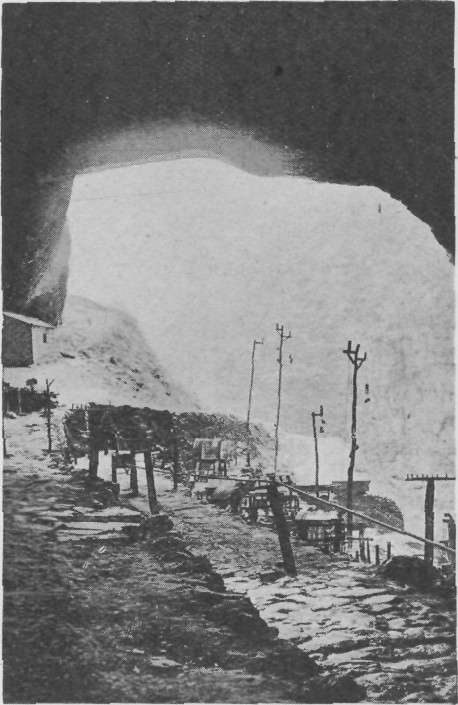
ROPE-WALK AT ENTRANCE INSIDE CAVE, CASTLETON, IN 1871.
If it had been the entrance to Hades, to which it had been likened by a learned visitor, we might have been confronted by Cerberus instead of our guide, whom our friends had warned overnight that his attendance would be required early this morning by distinguished visitors, who would expect the cave to be lit up with coloured lights in honour of their visit. The guide as he handed a light to each of us explained apologetically that his stock of red lights had been exhausted during the season, but he had brought a sufficient number of blue lights to suit the occasion. We followed him into the largest division of the cavern, which was 270 feet long and 150 feet high, the total length being about half a mile. It contained many other rooms or caves, into which he conducted us, the first being known as the Bell House, and here the path we had been following suddenly came to an end at an arch about five yards wide, where there was a stream called the River Styx, over which he ferried us in a boat, landing us in a cave called the Hall of Pluto, the Being who ruled over the Greek Hades, or Home of Departed Spirits, guarded by a savage three-headed dog named Cerberus. The only way of reaching the “Home,” our guide told us, was by means of the ferry on the River Styx, of which Charon had charge, and to ensure the spirit having a safe passage to the Elysian Fields it was necessary that his toll should be paid with a coin placed beforehand in the mouth or hand of the departed. We did not, however, take the hint about the payment of the toll until after our return journey, when we found ourselves again at the mouth of the Great Cavern, a privilege perhaps not extended to Pluto’s ghostly visitors, nor did we see any of those mysterious or mythological beings; perhaps the nearest approach to them was the figure of our guide himself, as he held aloft the blue torch he had in his hand when in the Hall of Pluto, for he presented the appearance of a man afflicted with delirium tremens or one of those “blue devils” often seen by victims of that dreadful disease. We also saw Roger Rain’s House, where it always rained, summer and winter, all the year round, and the Robbers’ Cave, with its five natural arches. But the strangest cave we visited was that called the “Devil’s Wine Cellar,” an awful abyss where the water rushed down a great hole and there disappeared. Her Most Gracious Majesty, Queen Victoria, visited the cavern in 1832, and one of the caves was named Victoria in memory of that event; we had the honour of standing on the exact spot where she stood on that occasion.
Our visit to the cavern was quite a success, enhanced as it was by the blue lights, so, having paid the guide for his services, we returned to our lodgings to “pack up” preparatory to resuming our walk. The white stones so kindly presented to my brother—of which he was very proud, for they certainly were very fine specimens—seemed likely to prove a white elephant to him. The difficulty now was how to carry them in addition to all the other luggage. Hurrying into the town, he returned in a few minutes with an enormous and strongly made red handkerchief like those worn by the miners, and in this he tied the stones, which were quite heavy and a burden in themselves. With these and all the other luggage as well he presented a very strange appearance as he toiled up the steep track through Cave Dale leading from the rear of the town to the moors above. It was no small feat of endurance and strength, for he carried his burdens until we arrived at Tamworth railway station in Staffordshire, to which our next box of clothes had been ordered, a distance of sixty-eight and a half miles by the way we walked. It was with a feeling of real thankfulness for not having been killed with kindness in the bestowal of these gifts that he deposited the stones in that box. When they reached home they were looked upon as too valuable to be placed on the rockeries and retained the sole possession of a mantelshelf for many years. My ankle was still very weak, and it was as much as I could do to carry the solitary walking-stick to assist me forwards; but we were obliged to move on, as we were now quite fifty miles behind our projected routine, and we knew there was some hard work before us. When we reached the moors, which were about a thousand feet above sea-level, the going was comparatively easy on the soft rich grass which makes the cow’s milk so rich, and we had some good views of the hills. That named Mam Tor was one of the “Seven wonders of the Peak,” and its neighbour, known as the Shivering Mountain, was quite a curiosity, as the shale, of which it was composed, was constantly breaking away and sliding down the mountain slope with a sound like that of falling water. Bagshawe Cavern was near at hand, but we did not visit it. It was so named because it had been found on land belonging to Sir William Bagshawe, whose lady christened its chambers and grottos with some very queer names. Across the moors we could see the town of Tideswell, our next objective, standing like an oasis in the desert, for there were no trees on the moors. We had planned that after leaving there we would continue our way across the moors to Newhaven, and then walk through Dove Dale to Ashbourne in the reverse direction to that taken the year before on our walk from London to Lancashire. Before reaching Tideswell we came to a point known as Lane Head, where six lane-ends met, and which we supposed must have been an important meeting-place when the moors, which surrounded it for miles, formed a portion of the ancient Peak Forest. We passed other objects of interest, including some ancient remains of lead mining in the form of curious long tunnels like sewers on the ground level which radiated to a point where on the furnaces heaps of timber were piled up and the lead ore was smelted by the heat which was intensified by these draught-producing tunnels.

When Peak Forest was in its primeval glory, and the Kings of England with their lords, earls, and nobles came to hunt there, many of the leading families had dwellings in the forest, and we passed a relic of these, a curious old mansion called Hazelbadge Hall, the ancient home of the Vernons, who still claim by right as Forester to name the coroner for West Derbyshire when the position falls vacant.
Tideswell was supposed to have taken its name from an ebbing and flowing well whose water rose and fell like the tides in the sea, but which had been choked up towards the end of the eighteenth century, and reopened in the grounds of a mansion, so that the cup-shaped hollow could be seen filling and emptying.
A market had existed at Tideswell since the year 1250, and one was being held as we entered the town, and the “George Inn,” where we called for refreshments, was fairly well filled with visitors of one kind or another.
We left our luggage to the care of the ostler, and went to visit the fine old church adjacent, where many ancient families lie buried; the principal object of interest was the magnificent chancel, which has been described as “one Gallery of Light and Beauty,” the whole structure being known as the Cathedral of the Peak. There was a fine monumental brass, with features engraved on it which throw light on the Church ritual of the day, to the memory of Bishop Pursglove, who was a native of Tideswell and founder of the local Grammar School, who surrendered his Priory of Gisburn to Henry VIII in 1540, but refused, in 1559, to take the Oath of Supremacy. Sampson Meverill, Knight Constable of England, also lies buried in the chancel, and by his epitaph on a marble tomb, brought curiously enough from Sussex, he asks the reader “devoutly of your charity” to say “a Pater Noster with an Ave for all Xtian soules, and especially for the soule of him whose bones resten under this stone.” Meverill, with John Montagu, Earl of Shrewsbury, fought as “a Captain of diverse worshipful places in France,” serving under John, Duke of Bedford, in the “Hundred Years’ War,” and after fighting in eleven battles within the space of two years he won knighthood at the duke’s hands at St. Luce. In the churchyard was buried William Newton, the Minstrel of the Peak, and Samuel Slack, who in the last quarter of the eighteenth century was the most popular bass singer in England. When quite young Slack competed with others for a position in a college choir at Cambridge, and sang Purcell’s famous air, “They that go down to the sea in ships.” When he had finished, the Precentor rose immediately and said to the other candidates, “Gentlemen, I now leave it to you whether any one will sing after what you have just heard!” No one rose, and so Slack gained the position.
Soon afterwards Georgiana, Duchess of Sutherland, interested herself in him, and had him placed under Spofforth, the chief singing master of the day, under whose tuition he greatly improved, taking London by storm. He was for many years the principal bass at all the great musical festivals. So powerful was his voice, it is said, that on one occasion when he was pursued by a bull he uttered a bellow which so terrified the animal that it ran away, so young ladies who were afraid of these animals always felt safe when accompanied by Mr. Slack. When singing before King George III at Windsor Castle, he was told that His Majesty had been pleased with his singing. Slack remarked in his Derbyshire dialect, which he always remembered, “Oh, he was pleased, were he? I thow’t I could do’t.” Slack it was said made no effort to improve himself either in speech or in manners, and therefore it was thought that he preferred low society.
When he retired and returned to his native village he was delighted to join the local “Catch and Glee Club,” of which he soon became the ruling spirit. It held its meetings at the “George Inn” where we had called for refreshments, and we were shown an old print of the club representing six singers in Hogarthian attitudes with glasses, jugs, and pipes, with Slack and his friend Chadwick of Hayfield apparently singing heartily from the same book Slack’s favourite song, “Life’s a Bumper fill’d by Fate.” Tideswell had always been a musical town; as far back as the year 1826 there was a “Tideswell Music Band,” which consisted of six clarionets, two flutes, three bassoons, one serpent, two trumpets, two trombones, two French horns, one bugle, and one double drum—twenty performers in all.
They had three practices weekly, and there were the usual fines for those who came late, or missed a practice, for inattention to the leader, or for a dirty instrument, the heaviest fine of all being for intoxication. But long after this there was a Tideswell Brass Band which became famous throughout the country, for the leader not only wrote the score copies for his own band, but lithographed and sold them to other bands all over the country.
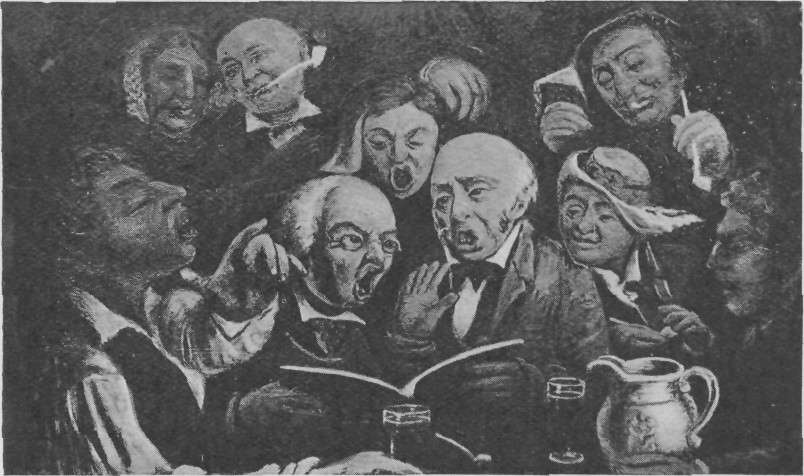
We were particularly interested in all this, for my brother had for the past eight years indulged in the luxury of a brass band himself. The band consisted of about twenty members when in full strength, and as instruments were dear in those days it was a most expensive luxury, and what it had cost him in instruments, music, and uniforms no one ever knew. He had often purchased “scores” from Metcalf, the leader of the Tideswell Band, a fact that was rather a source of anxiety to me, as I knew if he called to see Metcalf our expedition for that day would be at an end, as they might have conversed with each other for hours. I could not prevent him from relating at the “George” one of his early reminiscences, which fairly “brought down the house,” as there were some musicians in the company.
His band had been formed in 1863, and consisted of about a dozen performers. Christmas time was coming on, when the bandsmen resolved to show off a little and at the same time collect some money from their friends to spend in the New Year. They therefore decided that the band should go out “busking” each evening during Christmas week. They had only learned to play five tunes—two of them belonging to well-known hymns, a third “God Save the Queen,” while the remaining two were quicksteps, one of which was not quite perfectly learned.
They were well received in the village, and almost every house had been visited with the exception of the Hall, which was some distance away, and had been left till the last probably owing to the fact that the squire was not particularly noted for his liberality. If, however, he had been at home that week, and had any sense of music, he would have learned all their tunes off by heart, as the band must have been heard clearly enough when playing at the farms surrounding the mansion.
To avoid a possibility of giving offence, however, it was decided to pay him a visit; so the band assembled one evening in front of the mansion, and the conductor led off with a Psalm tune, during which the Hall door was opened by a servant. At this unexpected compliment expectations rose high amongst the members of the band, and a second Psalm tune was played, the full number of verses in the hymn being repeated. Then followed a pause to give the squire a chance of distinguishing himself, but as he failed to rise to the occasion it was decided to play a quickstep. This was followed by a rather awkward pause, as there were some high notes in the remaining quickstep which the soprano player said he was sure he could not reach as he was getting “ramp’d” already. At this moment, however, the situation was relieved by the appearance of a female servant at the door.
The member of the band who had been deputed to collect all donations at once went to the door, and all eyes were turned upon him when he came back towards the lawn, every member on tip-toe of expectation. But he had only returned to say that the squire’s lady wished the band to play a polka. This spread consternation throughout the band, and one of the younger members went to the conductor saying, “A polka! A polka! I say, Jim, what’s that?” “Oh,” replied the conductor, “number three played quick!” Now number three was a quickstep named after Havelock the famous English General in India, so “Havelock’s March played quick” had to do duty for a polka; but the only man who could play it quickly was the conductor himself, who after the words, “Ready, chaps!” and the usual signal “One-two-three,” dashed off at an unusual speed, the performers following as rapidly as they could, the Bombardon and the Double B, the biggest instruments, finishing last with a most awful groan, after which the conductor, who couldn’t stop laughing when once he started, was found rolling on the lawn in a kind of convulsion. It took them some time to recover their equilibrium, during which the Hall door remained open, and a portion of the band had already begun to move away in despair, when they were called back by the old butler appearing at the Hall door with a silver tray in his hand. The collector’s services were again requisitioned, and he returned with the magnificent sum of one shilling! As most of the farmers had given five shillings and the remainder half a crown, the squire’s reputation for generosity had been fully maintained. One verse of “God save the Queen,” instead of the usual three, was played by the way of acknowledgment, and so ended the band’s busking season in the year 1863.
We quite enjoyed our visit to Tideswell, and were rather loath to leave the friendly company at the “George Inn,” who were greatly interested in our walk, several musical members watching our departure as the ostler loaded my brother with the luggage.
Tideswell possessed a poet named Beebe Eyre, who in 1854 was awarded £50 out of the Queen’s Royal Bounty, which probably inspired him to write:
Tideswell! thou art my natal spot,
And hence I love thee well;
May prosperous days now be the lot
Of all that in thee dwell!
The sentiments expressed by the poet coincided with our own. As we departed from the town we observed a curiosity in the shape of a very old and extremely dilapidated building, which we were informed could neither be repaired, pulled down, nor sold because it belonged to some charity.
On the moors outside the town there were some more curious remains of the Romans and others skilled in mining, which we thought would greatly interest antiquarians, as they displayed more methods of mining than at other places we had visited. A stream had evidently disappointed them by filtering through its bed of limestone, but this they had prevented by forming a course of pebbles and cement, which ran right through Tideswell, and served the double purpose of a water supply and a sewer.
We crossed the old “Rakes,” or lines, where the Romans simply dug out the ore and threw up the rubbish, which still remained in long lines. Clever though they were, they only knew lead when it occurred in the form known as galena, which looked like lead itself, and so they threw out a more valuable ore, cerusite, or lead carbonate, and the heaps of this valuable material were mined over a second time in comparatively recent times. The miner of the Middle Ages made many soughs to drain away the water from the mines, and we saw more of the tunnels that had been made to draw air to the furnaces when wood was used for smelting the lead.
The forest, like many others, had disappeared, and Anna Seward had exactly described the country we were passing through when she wrote:
The long lone tracks of Tideswell’s native moor,
Stretched on vast hills that far and near prevail.
Bleak, stony, bare, monotonous, and pale.
The poet Newton had provided the town with a water supply by having pipes laid at his own expense from the Well Head at the source of the stream which flowed out of an old lead-mine. Lead in drinking-water has an evil name for causing poisoning, but the Tideswell folk flourish on it, since no one seems to think of dying before seventy, and a goodly number live to over ninety.
They have some small industries, cotton manufacture having spread from Lancashire into these remote districts. It is an old-fashioned place, with houses mostly stuccoed with broken crystals and limestone from the “Rakes” and containing curiously carved cupboard doors and posts torn from churches ornamented in Jacobean style by the sacrilegious Cromwellians, many of them having been erected just after the Great Rebellion.

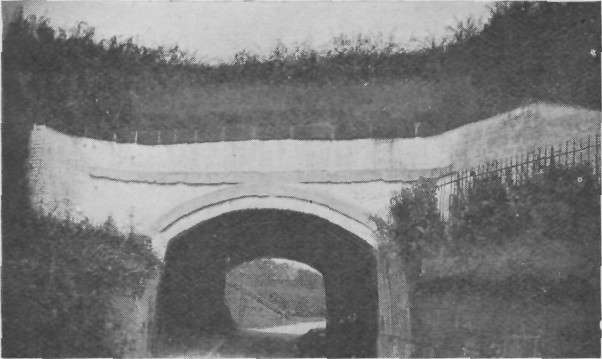
BRIDGE CARRYING THE CANAL OVERHEAD.
We now journeyed along the mountain track until it descended sharply into Miller’s Dale; but before reaching this place we were interested in the village of Formhill, where Brindley, the famous canal engineer, was born in 1716. Brindley was employed by the great Duke of Bridgewater, the pioneer of canal-making in England, to construct a canal from his collieries at Worsley, in Lancashire, to Manchester, in order to cheapen the cost of coal at that important manufacturing centre. It was an extraordinary achievement, considering that Brindley was quite uneducated and knew no mathematics, and up to the last remained illiterate. Most of his problems were solved without writings or drawings, and when anything difficult had to be considered, he would go to bed and think it out there. At the Worsley end it involved tunnelling to the seams of coal where the colliers were at work so that they could load the coal directly into the boats. He constructed from ten to thirteen miles of underground canals on two different levels, with an ingeniously constructed connection between the two. After this he made the great Bridgewater Canal, forty miles in length, from Manchester to Runcorn, which obtained a fall of one foot per mile by following a circuitous route without a lock or a tunnel in the whole of its course until it reached its terminus at the River Mersey. In places where a brook or a small valley had to be crossed the canal was carried on artificially raised banks, and to provide against a burst in any of these, which would have caused the water to run out of the canal, it was narrowed at each end of the embankment so that only one boat could pass through at a time, this narrow passage being known as a “stop place.” At the entrance to this a door was so placed at the bottom of the canal that if any undue current should appear, such as would occur if the embankment gave way, one end of it would rise into a socket prepared for it in the stop-place, and so prevent any water leaving the canal except that in the broken section, a remedy simple but ingenious. On arriving at Runcorn the boats were lowered by a series of locks into the River Mersey, a double service of locks being provided so that boats could pass up and down at the same time and so avoid delay.
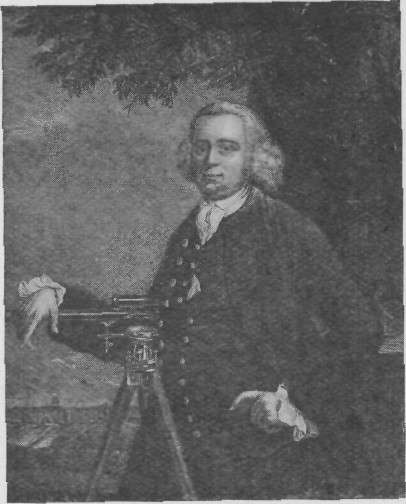
When the water was first turned into the canal, Brindley mysteriously disappeared, and was nowhere to be found; but as the canal when full did not burst its embankments, as he had feared, he soon reappeared and was afterwards employed to construct even more difficult canals. He died in 1772, and was buried in Harriseahead Churchyard on the Cheshire border of Staffordshire. It is computed that he engineered as many miles of canals as there are days in the year.
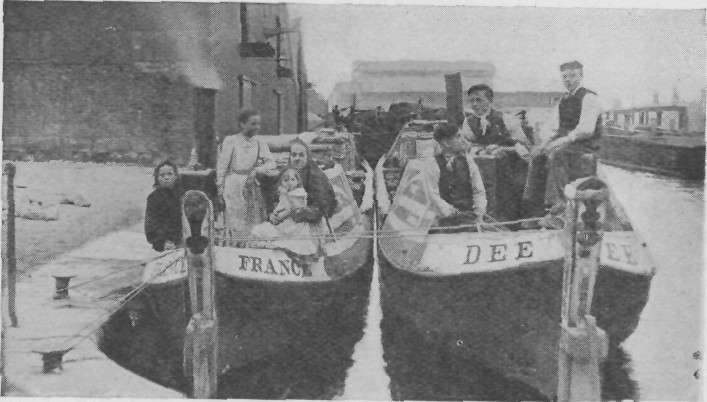
It must have been a regular custom for the parsons in Derbyshire to keep diaries in the eighteenth century, for the Vicar of Wormhill kept one, like the Vicar of Castleton, both chancing to be members of the Bagshawe family, a common name in that neighbourhood. He was a hard-working and conscientious man, and made the following entry in it on February 3rd, 1798
Sunday.—Preached at Wormhill on the vanity of human pursuits and human pleasures, to a polite audience, an affecting sermon. Rode in the evening to Castleton, where I read three discourses by Secker. In the forest I was sorry to observe a party of boys playing at Football. I spoke to them but was laughed at, and on my departure one of the boys gave the football a wonderful kick—a proof this of the degeneracy of human nature!
On reaching Miller’s Dale, a romantic deep hollow in the limestone, at the bottom of which winds the fast-flowing Wye, my brother declared that he felt more at home, as it happened to be the only place he had seen since leaving John o’ Groat’s that he had previously visited, and it reminded him of a rather amusing incident.

THE BRIDGEWATER CANAL—WHERE IT ENTERS THE MINES AT WORSLEY.
Our uncle, a civil engineer in London, had been over on a visit, and was wearing a white top-hat, then becoming fashionable, and as my brother thought that a similar hat would just suit the dark blue velveteen coat he wore on Sundays, he soon appeared in the prevailing fashion. He was walking from Ambergate to Buxton, and had reached Miller’s Dale about noon, just as the millers were leaving the flour mills for dinner. One would have thought that the sight of a white hat would have delighted the millers, but as these hats were rather dear, and beyond the financial reach of the man in the street, they had become an object of derision to those who could not afford to wear them, the music-hall answer to the question “Who stole the donkey?” being at that time “The man with the white hat!”
He had met one group of the millers coming up the hill and another lot was following, when a man in the first group suddenly turned round and shouted to a man in the second group, “I say, Jack, who stole the donkey?” But Jack had not yet passed my brother, and, as he had still to face him, he dared not give the customary answer, so, instead of replying “The man with the white hat,” he called out in the Derbyshire dialect, with a broad grin on his face, “Th’ feyther.” A roar of laughter both behind and in front, in which my brother heartily joined, followed this repartee.
Probably some of the opprobrium attached to the white hat was because of its having been an emblem of the Radicals. We had seen that worn by Sir Walter Scott in his declining days, but we could not think of including him in that extreme political party, though its origin dated back to the time when he was still alive. Probably the emblem was only local, for it originated at Preston in Lancashire, a place we knew well, commonly called Proud Preston, no doubt by reason of its connection with the noble family of Stanley, who had a mansion in the town. Preston was often represented in Parliament by a Stanley, and was looked upon as a Pocket Borough. In the turbulent times preceding the Abolition of the Corn Laws a powerful opponent, in the person of Mr. Henry Hunt, a demagogue politician, who had suffered imprisonment for advocating Chartism, appeared at the Preston election of 1830 to oppose the Honourable E.G. Stanley, afterwards Earl of Derby. He always appeared wearing a white hat, and was an eloquent speaker, and for these reasons earned the sobriquet of “Orator” Hunt and “Man with the White Hat.” The election contest was one of the most exciting events that ever occurred in Preston, and as usual the children took their share in the proceedings, those on Mr. Stanley’s side parading the streets singing in a popular air:
Hey! Ho! Stanley for Ever! Stanley for Ever!
Hey! Ho! Stanley for Ever Ho!
Stanley, Stanley, Stanley, Ho!
Stanley is my honey Ho!
When he weds he will be rich,
He will have a coach and six.
Then followed the chorus to the accompaniment of drums and triangles:
Hey! Ho! Stanley for Ever, Ho!
In spite of this, however, and similar ditties, “Orator Hunt,” by a total vote of 3,730, became M.P. for Preston, and it was said that it was through this incident that the Radicals adopted the White Hat as their emblem.
Lord Derby was so annoyed at the result of the election that he closed his house, which stood across the end of a quiet street, and placed a line of posts across it, between which strong chains were hung, and on which my brother could remember swinging when a boy.
One of our uncles was known as the “Preston Poet” at that time, and he wrote a poem entitled “The Poor, God Bless ‘Em!” the first verse reading:
Let sycophants bend their base knees in the court
And servilely cringe round the gate,
And barter their honour to earn the support
Of the wealthy, the titled, the great;
Their guilt piled possessions I loathe, while I scorn
The knaves, the vile knaves who possess ’em;
I love not to pamper oppression, but mourn
For the poor, the robb’d poor—God bless ’em!
A striking contrast to the volubility of Mr. Hunt was Mr. Samuel Horrocks, also M.P. for Preston, whose connection with the “Big Factory” in Preston probably gained him the seat. He was said to have been the “quiet Member,” never known to make a speech in the House of Commons, unless it was to ask some official to close a window. The main thoroughfare in Preston was Fishergate, a wide street, where on one Saturday night two men appeared walking up the middle of the street, carrying large papers suspended over their arms and shouting at the top of their voices.
“The Speech of Samuel Horrocks, Esquire, M.P., in the British House of Commons! one penny,” which they continued to repeat.
“Eh! owd Sammy’s bin makkin’ a speech,” and a rush was made for the papers. The streets were poorly lighted in those days, and the men did a roaring business in the dark. One man, however, was so anxious to read the speech that he could not wait until he got home, but went to a shop window, where there was a light, but the paper was blank. Thinking they had given him the wrong paper, he ran after the men and shouted, pointing to the paper, “Hey, there’s nowt on it.” “Well,” growled one of the men, “he said nowt.”

We now climbed up the opposite side of the dale, and continued on the moorland road for a few miles, calling at the “Flagg Moor Inn” for tea. By the time we had finished it was quite dark, and the landlady of the inn did her best to persuade us to stay there for the night, telling us that the road from there to Ashbourne was so lonely that it was possible on a dark night to walk the whole distance of fourteen miles without seeing a single person, and as it had been the Great Fair at Newhaven that day, there might be some dangerous characters on the roads. When she saw we were determined to proceed farther, she warned us that the road did not pass through any village, and that there was only a solitary house here and there, some of them being a little way from the road. The road was quite straight, and had a stone wall on each side all the way, so all we had got to do was to keep straight on, and to mind we did not turn to the right or the left along any of the by-roads lest we should get lost on the moors. It was not without some feeling of regret that we bade the landlady “Good night” and started out from the comfortable inn on a pitch-dark night. Fortunately the road was dry, and, as there were no trees, the limestone of which it was composed showed a white track easily discernible in the inky darkness which surrounded it. As we got farther on our way we could see right in front a great illumination in the mist or clouds above marking the glare from the country fair at Newhaven, which was only four miles from the inn we had just left. We met quite a number of people returning from the fair, both on foot and in vehicles, and as they all appeared to be in good spirits we received a friendly greeting from all who spoke to us. Presently arriving at Newhaven itself, which consisted solely of one large inn, we found the surrounding open space packed with a noisy and jovial crowd of people, the number of whom absolutely astonished us, as the country around appeared so desolate, and we wondered where they all could have come from. Newhaven, which had been a very important place in the coaching-days, was a big three-storeyed house with twenty-five bedrooms and stabling for a hundred horses. It stood at a junction of roads about 1,100 feet above sea-level in a most lonely place, and in the zenith of its popularity there was seldom a bedroom empty, the house being quite as gay as if it had been in London itself. It had been specially built for the coach traffic by the then Duke of Devonshire, whose mansion, Chatsworth House, was only a few miles distant. King George IV stayed at Newhaven on one occasion, and was so pleased with his entertainment that he granted to the inn a free and perpetual licence of his own sovereign pleasure, so that no application for renewal of licence at Brewster Sessions was ever afterwards required; a fact which accounted in some measure for the noisy company congregated therein, in defiance of the superintendent of police, who, with five or six of his officers, was standing in front of the fair. Booths had been erected by other publicans, but the police had ordered these to be removed earlier in the day to prevent further disturbances.
We noticed they had quite a number of persons in custody, and when I saw a policeman looking very critically at the miscellaneous assortment of luggage my brother was carrying, I thought he was about to be added to the number; but he was soon satisfied as to the honesty of his intentions. The “New Haven” must have meant a new haven for passengers, horses, and coaches when the old haven had been removed, as the word seemed only to apply to the hotel, which, as it was ten miles both from Buxton and Ashbourne, and also on the Roman road known as Via Gellia, must have been built exactly to accommodate the ten-mile run of the coaches either way. It quite enlivened us to see the old-fashioned shows, the shooting-boxes, the exhibitions of monstrosities, with stalls displaying all sorts of nuts, sweets, gingerbreads, and all the paraphernalia that in those days comprised a country fair, and we should have liked to stay at the inn and visit some of the shows which were ranged in front of it and along the green patches of grass which lined the Ashbourne road; but in the first place the inn was not available, and in the second our twenty-five-mile average daily walk was too much in arrears to admit of any further delay.
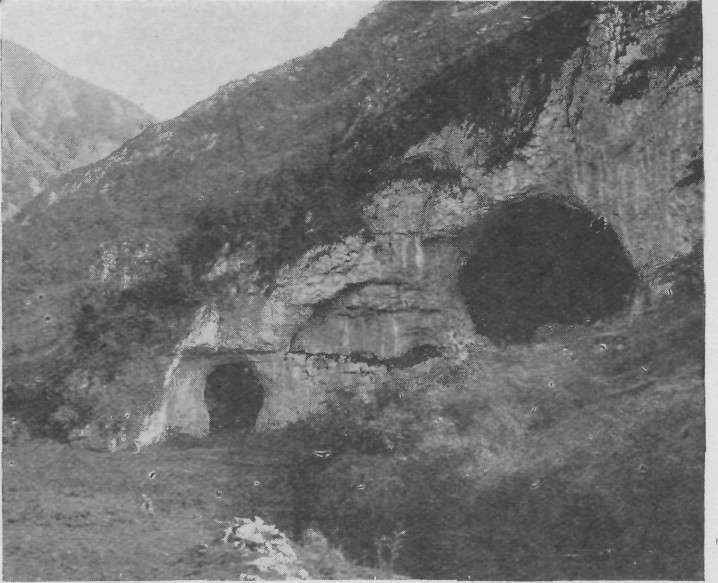
All the shows and stalls were doing a roaring trade, and the naphtha lamps with which they were lighted flared weirdly into the inky darkness above. Had we been so minded, we might have turned aside and found quarters at an inn bearing the odd sign of “The Silent Woman” (a woman with her head cut off and tucked under her arm, similar to one nearer home called the “Headless Woman”—in the latter case, however, the tall figure of the woman was shown standing upright, without any visible support, while her head was calmly resting on the ground—the idea seeming to be that a woman could not be silent so long as her head was on her body), but we felt that Ashbourne must be reached that night, which now seemed blacker than ever after leaving the glaring lights in the Fair. Nor did we feel inclined to turn along any by-road on a dark night like that, seeing that we had been partly lost on our way from London the previous year, nearly at the same place, and on quite as dark a night. On that memorable occasion we had entered Dovedale near Thorpe, and visited the Lovers’ Leap, Reynard’s Cave, Tissington Spires, and Dove Holes, but darkness came on, compelling us to leave the dale to resume our walk the following morning. Eventually we saw a light in the distance, where we found a cottage, the inmates of which kindly conducted us with a lantern across a lonely place to the village of Parwich, which in the Derbyshire dialect they pronounced “Porritch,” reminding us of our supper.

It was nearly closing-time when we were ushered into the taproom of the village inn among some strange companions, and when the hour of closing arrived we saw the head of the village policeman appear at the shutter through which outside customers were served with beer. The landlord asked him, “Will you have a pint?” Looking significantly at ourselves, he replied, “No, thank you,” but we noticed the “pint” was placed in the aperture, and soon afterwards disappeared!

At Newhaven we ascertained that we were now quite near Hartington and Dovedale. Hartington was a famous resort of fishermen and well known to Isaak Walton, the “Father of Fishermen,” and author of that famous book The Compleat Angler or the Contemplative Man’s Recreation, so full of such cheerful piety and contentment, such sweet freshness and simplicity, as to give the book a perennial charm. He was a great friend of Charles Cotton of Beresford Hall, who built a fine fishing-house near the famous Pike Pool on the River Dove, over the arched doorway of which he placed a cipher stone formed with the combined initials of Walton and himself, and inscribed with the words “Piscatoribus Sacrum.” It was said that when they came to fish in the fish pool early in the morning, Cotton smoked tobacco for his breakfast!
What spot more honoured than this beautiful place?
Twice honoured truly. Here Charles Cotton sang,
Hilarious, his whole-hearted songs, that rang
With a true note, through town and country ways,
While the Dove trout—in chorus—splashed their praise.
Here Walton sate with Cotton in the shade
And watched him dubb his flies, and doubtless made
The time seem short, with gossip of old days.
Their cyphers are enlaced above the door,
And in each angler’s heart, firm-set and sure.
While rivers run, shall those two names endure,
Walton and Cotton linked for evermore—-
And Piscatoribus Sacrum where more fit
A motto for their wisdom worth and wit?
Say, where shall the toiler find rest from his labours,
And seek sweet repose from the overstrung will?
Away from the worry and jar of his neighbours
Where moor-tinted streamlets flow down from the hill.
Then hurrah! jolly anglers, for burn and for river.
The songs of the birds and the lowing of kine:
The voice of the river shall soothe us for ever,
Then here’s to the toast, boys—”The rod and the line!”

We walked in the darkness for about six miles thinking all the time of Dovedale, which we knew was running parallel with our road at about two miles’ distance. When we reached Tissington, about three miles from Ashbourne, the night had become lighter, and there ought to have been a considerable section of the moon visible if the sky had been clear. Here we came to quite a considerable number of trees, but the village must have been somewhere in the rear of them. Well-dressing was a custom common in Derbyshire, and also on a much smaller scale in some of the neighbouring counties; but this village of Tissington was specially noted in this respect, for it contained five wells, all of which had to be dressed. As the dressers of the different wells vied with each other which should have the best show, the children and young people had a busy time in collecting the flowers, plants, buds, and ferns necessary to form the display. The festival was held on Holy Thursday, and was preceded with a service in the church followed by one at each of the wells, and if the weather was fine, hundreds of visitors assembled to criticise the work at the different wells. The origin of well-dressing is unknown, but it is certainly of remote antiquity, probably dating back to pagan times. That at Tissington was supposed to have developed at the time of the Black Plague in the fourteenth century, when, although it decimated many villages in the neighbourhood, it missed Tissington altogether—because, it was supposed, of the purity of the waters. But the origin of well-dressing must have been of much greater antiquity: the custom no doubt had its beginnings as an expression of praise to God from whom all blessings flow. The old proverb, “We never know the value of water till the well runs dry,” is singularly appropriate in the hilly districts of Derbyshire, where not only the wells, but the rivers also have been known to dry up, and when the spring comes and brings the flowers, what could be more natural than to thank the Almighty who sends the rain and the water, without which they could not grow.
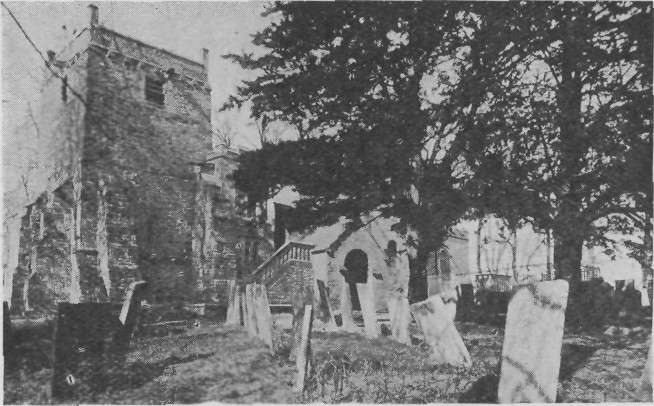
We were sorry to have missed our walk down Dove Dale, but it was all for the best, as we should again have been caught in the dark there, and perhaps I should have injured my foot again, as the path along the Dale was difficult to negotiate even in the daylight. In any case we were pleased when we reached Ashbourne, where we had no difficulty in finding our hotel, for the signboard of the “Green Man” reached over our heads from one side of the main street to the other.
(Distance walked twenty-six and a half miles.)
Tuesday, October 31st.
The inn we stayed at was a famous one in the days of the stagecoaches, and bore the double name “The Green Man and the Black’s Head Royal Hotel” on a sign which was probably unique, for it reached across the full width of the street. A former landlord having bought another coaching-house in the town known as the “Black’s Head,” transferred the business to the “Green Man,” when he incorporated the two signs. We were now on the verge of Dr. Johnson’s country, the learned compiler of the great dictionary, who visited the “Green Man” in company with his companion, James Boswell, whose Life of Dr. Johnson is said to be the finest biography ever written in the English language. They had a friend at Ashbourne, a Dr. Taylor, whom they often visited, and on one occasion when they were all sitting in his garden their conversation turned on the subject of the future state of man. Johnson gave expression to his views in the following words, “Sir, I do not imagine that all things will be made clear to us immediately after death, but that the ways of Providence will be explained to us very gradually.”
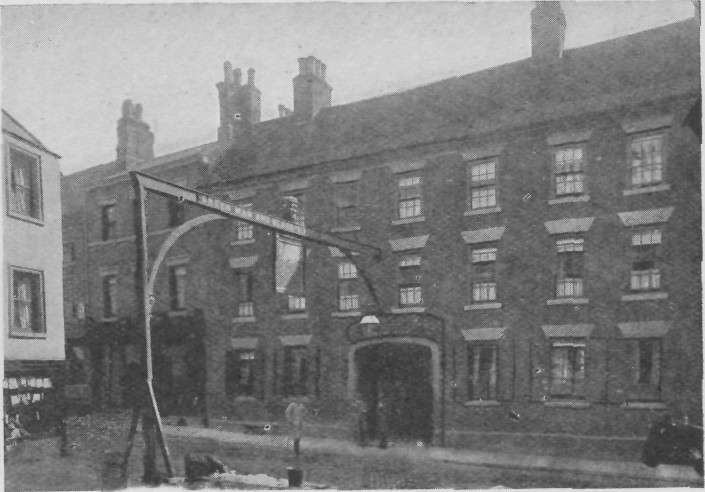
“THE GREEN MAN AND BLACK’S HEAD.”
Boswell stayed at the “Green Man” just before journeying with Dr. Johnson to Scotland, and was greatly pleased by the manners of the landlady, for he described her as a “mighty civil gentlewoman” who curtseyed very low as she gave him an engraving of the sign of the house, under which she had written a polite note asking for a recommendation of the inn to his “extensive acquaintance, and her most grateful thanks for his patronage and her sincerest prayers for his happiness in time and in blessed eternity.” The present landlady of the hotel appeared to be a worthy successor to the lady who presided there in the time of Boswell, for we found her equally civil and obliging, and, needless to say, we did justice to a very good breakfast served up in her best style.
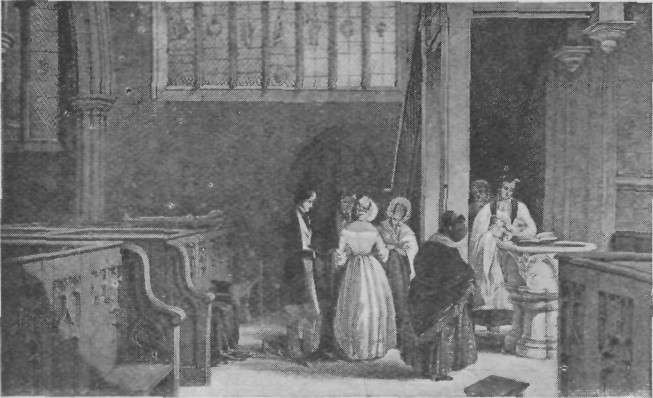
IN ASHBOURNE CHURCH IN YE OLDEN TIME.
The Old Hall of Ashbourne, situated at the higher end of the town, was a fine old mansion, with a long history, dating from the Cockayne family, who were in possession of lands here as early as the year 1372, and who were followed by the Boothby family.
The young Pretender, “Bonnie Prince Charlie,” who had many friends in England, stayed a night at the Hall in 1745, and the oak door of the room in which he slept was still preserved. He and his Highlanders never got farther than Derby, when he had to beat a hurried retreat, pursued by the Duke of Cumberland. Prince Charlie, to avoid the opposing army at Stafford and Lichfield, turned aside along the Churnet valley, through Leek, and so to Ashbourne. At Derby he called a Council of War, and learned how the Royal forces were closing in upon him, so that reluctantly a retreat was ordered. Then began a period of plundering and rapine. The Highlanders spread over the country, but on their return never crossed into Staffordshire, for, as the story goes, the old women of the Woodlands of Needwood Forest undertook to find how things were going, and crept down to the bridges of Sudbury and Scropton. As it began to rain, they used their red flannel petticoats as cloaks, which the Highlanders, spying, took to be the red uniforms of soldiers, and a panic seized them—so much so, that some who had seized some pig-puddings and were fastening them hot on a pole, according to a local ditty, ran out through a back door, and, jumping from a heap of manure, fell up to the neck in a cesspool. The pillage near Ashbourne was very great, but they could not stay, for the Duke was already at Uttoxoter with a small force.
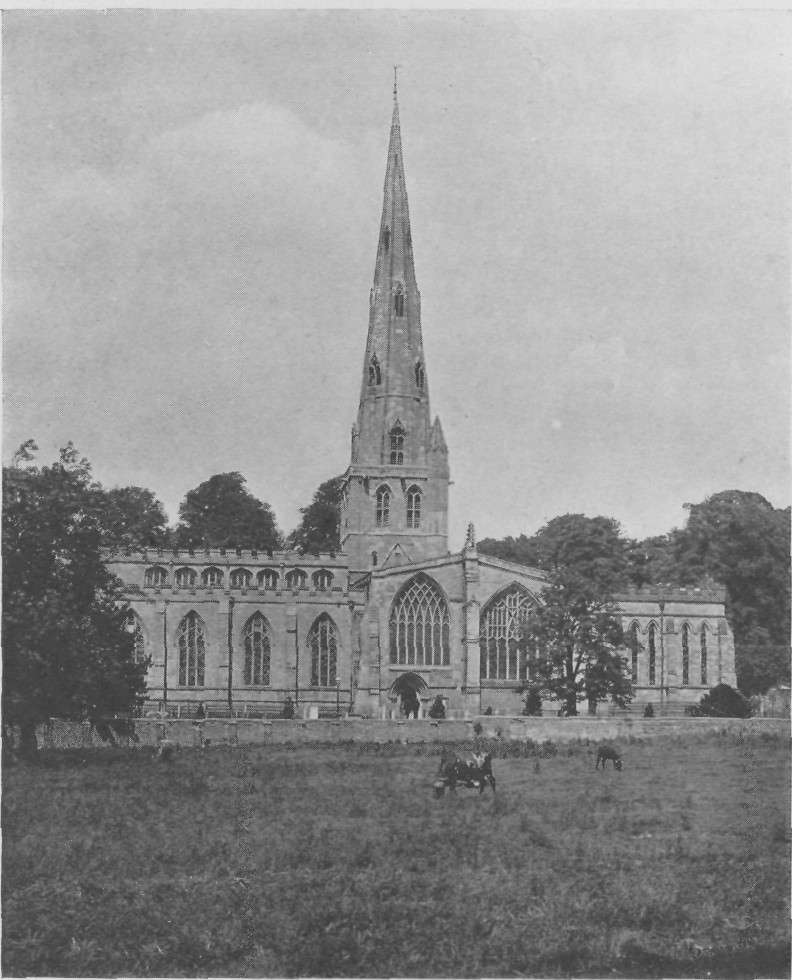
George Canning, the great orator who was born in 1770 and died when he was Prime Minister of England in 1827, often visited Ashbourne Old Hall. In his time the town of Ashbourne was a flourishing one; it was said to be the only town in England that benefited by the French prisoners of war, as there were 200 officers, including three generals, quartered there in 1804, and it was estimated that they spent nearly £30,000 in Ashbourne. An omnibus was then running between Ashbourne and Derby, which out of courtesy to the French was named a “diligence,” the French equivalent for stage-coach; but the Derby diligence was soon abbreviated to the Derby “Dilly.” The roads at that time were very rough, macadamised surfaces being unknown, and a very steep hill leading into the Ashbourne and Derby Road was called bête noire by the French, about which Canning, who was an occasional passenger, wrote the following lines:
So down the hill, romantic Ashbourne, glides
The Derby Dilly, carrying three insides;
One in each corner sits and lolls at ease,
With folded arms, propt back and outstretched knees;
While the pressed bodkin, pinched and squeezed to death,
Sweats in the midmost place and scolds and pants for breath.
We were now at the end of the last spur of the Pennine Range of hills and in the last town in Derbyshire. As if to own allegiance to its own county, the spire of the parish church, which was 212 feet high, claimed to be the “Pride of the Peak.” In the thirteenth-century church beneath it, dedicated to St. Oswald, there were many fine tombs of the former owners of the Old Hall at Ashbourne, those belonging to the Cockayne family being splendid examples of the sculptor’s art. We noted that one member of the family was killed at the Battle of Shrewsbury in 1404, while another had been knighted by King Henry VII at the siege of Tournay. The finest object in the church was the marble figure of a little child as she appeared—
Before Decay’s effacing fingers
Have swept the lines where beauty lingers,
which for simplicity, elegance, and childlike innocence of face was said to be the most interesting and pathetic monument in England. It is reputed to be the masterpiece of the English sculptor Thomas Banks, whose work was almost entirely executed abroad, where he was better known than in England. The inscriptions on it were in four different languages, English, Italian, French, and Latin, that in English being:
I was not in safety, neither had I rest, and the trouble came.
The dedication was inscribed:
TO PENELOPE
ONLY CHILD OF SIR BROOKE BOOTHBY AND DAME SUSANNAH BOOTHBY.
Born April 11th 1785, died March 13th 1791.
She was in form and intellect most exquisite
The unfortunate parents ventured their all in this Frail bark,
And the wreck was Total.
The melancholy reference to their having ventured their all bore upon the separation between the father and mother, which immediately followed the child’s death.
The description of the monument reads as follows:
The figure of the child reclines on a pillowed mattress, her hands resting one upon the other near her head. She is simply attired in a frock, below which her naked feet are carelessly placed one over the other, the whole position suggesting that in the restlessness of pain she had just turned to find a cooler and easier place of rest.
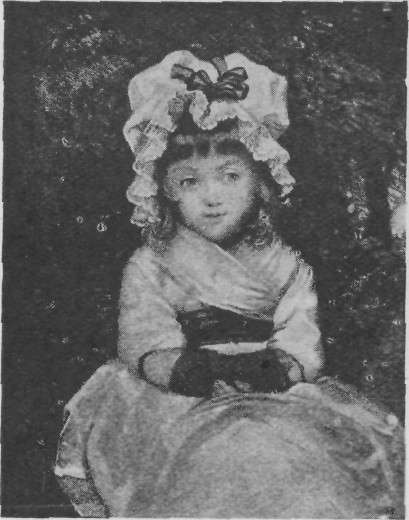
Her portrait was painted by Sir Joshua Reynolds, her name appearing in his “Book of Sitters” in July 1788, when she was just over three years of age, and is one of the most famous child-pictures by that great master. The picture shows Little Penelope in a white dress and a dark belt, sitting on a stone sill, with trees in the background. Her mittened hands are folded in her lap, and her eyes are demurely cast down. She is wearing a high mob-cap, said to have belonged to Sir Joshua’s grandmother.
This picture was sold in 1859 to the Earl of Dudley for 1,100 guineas, and afterwards exhibited at Burlington House, when it was bought by Mr. David Thwaites for £20,060.
The model for the famous picture “Cherry Ripe,” painted by Sir John Everett-Millais, was Miss Talmage, who had appeared as Little Penelope at a fancy-dress ball, and it was said in later years that if there had been no Penelope Boothby by Sir Joshua Reynolds, there would have been no “Cherry Ripe” by Sir John Everett-Millais.
Sir Francis Chantrey, the great sculptor, also visited Ashbourne Church. His patron, Mrs. Robinson, when she gave him the order to execute that exquisite work, the Sleeping Children, in Lichfield Cathedral, expressly stipulated that he must see the figure of Penelope Boothby in Ashbourne Church before he began her work. Accordingly Chantrey came down to the church and completed his sketch afterwards at the “Green Man Inn,” working at it until one o’clock the next morning, when he departed by the London coach.
Ashbourne is one of the few places which kept up the football match on Shrove Tuesday, a relic probably of the past, when the ball was a creature or a human being, and life or death the object of the game. But now the game was to play a stuffed case or the biggest part of it up and down the stream, the Ecclesbourne, until the mill at either limit of the town was reached.
The River Dove, of which it has been written the “Dove’s flood is worth a king’s good,” formed the boundary between Derbyshire and Staffordshire, which we crossed by a bridge about two miles after leaving Ashbourne. This bridge, we were told, was known as the Hanging Bridge, because at one time people were hanged on the tree which stood on the border between the two counties, and we might have fared badly if our journey had been made in the good old times, when “tramps” were severely treated. Across the river lay the village of Mayneld, where the landlord of the inn was killed in a quarrel with Prince Charlie’s men in their retreat from Derby for resisting their demands, and higher up the country a farmer had been killed because he declined to give up his horse. They were not nearly so orderly as they retreated towards the north, for they cleared both provisions and valuables from the country on both sides of the roads. A cottage at Mayneld was pointed out to us as having once upon a time been inhabited by Thomas, or Tom Moore, Ireland’s great poet, whose popularity was as great in England as in his native country, and who died in 1852 at the age of seventy-three years. The cottage was at that time surrounded by woods and fields, and no doubt the sound of Ashbourne Church bells, as it floated in the air, suggested to him one of his sweetest and saddest songs:
Those evening bells! those evening bells,
How many a tale their music tells
Of youth and home and that sweet time
When last I heard their soothing chime.
Those joyous hours are passed away,
And many a heart that then was gay
Within the tomb now darkly dwells,
And hears no more those evening bells.
And so ’twill be when I am gone:
The tuneful peal will still ring on:
While other bards shall walk these dells
And sing your praise, sweet evening bells.
We passed Calwick Abbey, once a religious house, but centuries ago converted into a private mansion, which in the time of Handel (1685-1759) was inhabited by the Granville family. Handel, although a German, spent most of his time in England, and was often the guest of the nobility. It was said that it was at Calwick Abbey that his greatest oratorios were conceived, and that the organ on which he played was still preserved. We ourselves had seen an organ in an Old Hall in Cheshire on which he had played when a visitor there, and where was also shown a score copy in his own handwriting. All that was mortal of Handel was buried in Westminster Abbey, but his magnificent oratorios will endure to the end of time.
On arrival at Ellastone we left our luggage at the substantially built inn there while we went to visit Norbury Church, which was well worth seeing, and as my foot had now greatly improved we were able to get over the ground rather more quickly. Norbury was granted to the Fitzherberts in 1125, and, strange as it may appear, the original deed was still in the possession of that ancient family, whose chief residence was now at Swynnerton at the opposite side of Staffordshire, where they succeeded the Swynnerton family as owners of the estate. The black image of that grim crusader Swynnerton of Swynnerton still remained in the old chapel there, and as usual in ancient times, where the churches were built of sandstone, they sharpened their arrows on the walls or porches of the church, the holes made in sharpening them being plainly visible. Church restorations have caused these holes to be filled with cement in many places, like the bullet holes of the more recent period of the Civil War, but holes in the exact shape of arrow heads were still to be seen in the walls at Swynnerton, the different heights showing some of the archers to have been very tall men. In spite of severe persecution at the time of the Reformation this branch of the family of the Fitzherberts adhered to the Roman Catholic Faith, Sir Thomas Fitzherbert being one of the most prominent victims of the Elizabethan persecutions, having passed no less than thirty years of his life in various prisons in England.
Norbury church was not a large one, but the chancel was nearly as large as the nave. It dated back to the middle of the fourteenth century, when Henry of Kniveton was rector, who made the church famous by placing a number of fine stained-glass windows in the chancel. The glass in these windows was very chaste and beautiful, owing to the finely tinted soft browns and greens, now probably mellowed by age, and said to rank amongst the finest of their kind in England. The grand monuments to the Fitzherberts were magnificently fine examples of the art and clothing of the past ages, the two most gorgeous tombs being those of the tenth and eleventh lords, in all the grandeur of plate armour, collars, decorations, spurs, and swords; one had an angel and the other a monk to hold his foot as he crossed into the unknown. The figures of their families as sculptured below them were also very fine. Considering that one of the lords had seventeen children and the other fifteen it was scarcely to be wondered at that descendants of the great family still existed.
Sir Nicholas, who died in 1473, occupied the first tomb, his son the second, and his children were represented dressed in the different costumes of their chosen professions, the first being in armour with a cross, and the next as a lawyer with a scroll, while another was represented as a monk with a book, but as the next had his head knocked off it was impossible to decipher him; others seemed to have gone into businesses of one kind or another.
The oldest monument in the church was a stone cross-legged effigy of a warrior in armour, dating from about the year 1300; while the plainest was the image of a female corpse in a shroud, on a gravestone, who was named … Elysebeth …
The which decessed the yeare that is goone,
A thousand four hundred neynty and oone.
The church was dedicated to St. Barloke, probably one of the ancient British Divines.
On returning to Ellastone we learned that the inn was associated with “George Eliot,” whose works we had heard of but had not read. We were under the impression that the author was a man, and were therefore surprised to find that “George Eliot” was only the nom de plume of a lady whose name was Marian Evans. Her grandfather was the village wheelwright and blacksmith at Ellastone, and the prototype of “Adam Bede” in her famous novel of that name.
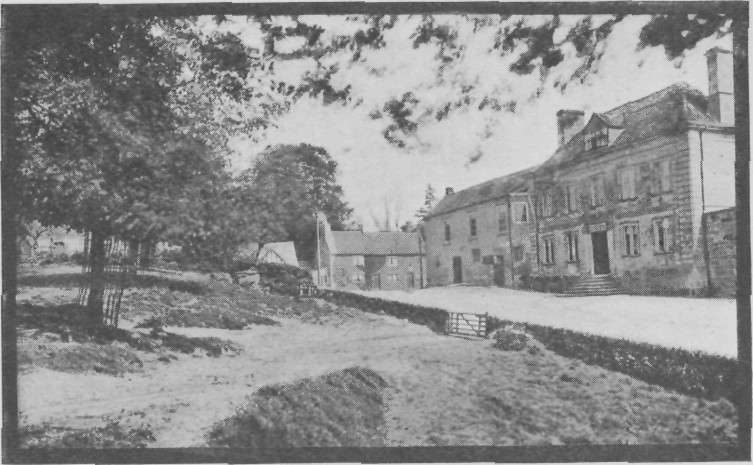
GEORGE ELLIOT’S “DONNITHORPE ARMS,” ELLASTONE.
It has been said that no one has ever drawn a landscape more graphically than Marian Evans, and the names of places are so thinly veiled that if we had read the book we could easily have traced the country covered by “Adam Bede.” Thus Staffordshire is described as Loamshire, Derbyshire as Stoneyshire, and the Mountains of the Peak as the barren hills, while Oakbourne stands for Ashbourne, Norbourne for Norbury, and Hayslope, described so clearly in the second chapter of Adam Bede, is Ellastone, the “Donnithorpe Arms” being the “Bromley Arms Hotel,” where we stayed for refreshments. It was there that a traveller is described in the novel as riding up to the hotel, and the landlord telling him that there was to be a “Methodis’ Preaching” that evening on the village green, and the traveller stayed to listen to the address of “Dinah Morris,” who was Elizabeth Evans, the mother of the authoress.
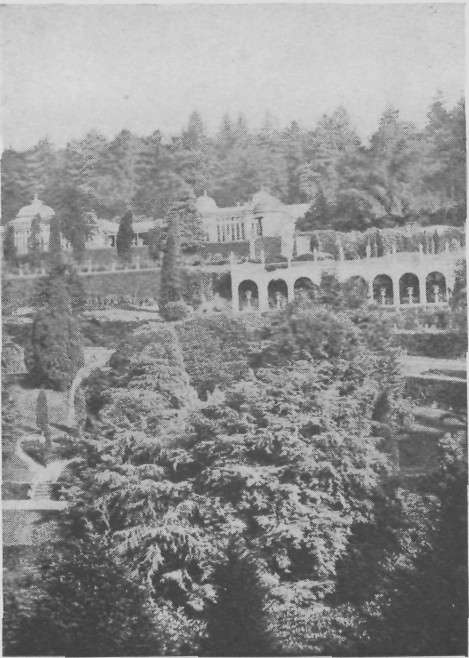
Wootton Hall, which stands immediately behind the village of Ellastone, was at one time inhabited by Jean Jacques Rousseau, the great French writer, who, when he was expelled from France, took the Hall for twelve months in 1776, beginning to write there his Confessions, as well as his Letters on Botany, at a spot known as the “Twenty oaks.” It was very bad weather for a part of the time, and snowed incessantly, with a bitterly cold wind, but he wrote, “In spite of all, I would rather live in the hole of one of the rabbits of this warren, than in the finest rooms in London.”
We now hurried across the country, along old country lanes and over fields, to visit Alton Towers; but, as it was unfortunately closed on that day, it was only by trespassing that we were able to see a part of the grounds. We could see the fine conservatories, with their richly gilded domes, and some portion of the ground and gardens, which were in a deep dell. These were begun by Richard, Earl of Shrewsbury, in the year 1814, who, after years of labour, and at enormous expense, converted them from a wilderness into one of the most extraordinary gardens in Europe, almost baffling description. There was a monument either to himself or the gardener, on which were the words:
He made the desert smile.
From the Uttoxeter Road we could see a Gothic bridge, with an embankment leading up to it, and a huge imitation of Stonehenge, in which we were much interested, that being one of the great objects of interest we intended visiting when we reached Salisbury Plain. We were able to obtain a small guide-book, but it only gave us the information that the gardens consisted of a “labyrinth of terraces, walls, trellis-work, arbours, vases, stairs, pavements, temples, pagodas, gates, parterres, gravel and grass walks, ornamental buildings, bridges, porticos, seats, caves, flower-baskets, waterfalls, rocks, cottages, trees, shrubs and beds of flowers, ivied walls, moss houses, rock, shell, and root work, old trunks of trees, etc., etc.,” so, as it would occupy half a day to see the gardens thoroughly, we decided to come again on some future occasion. A Gothic temple stood on the summit of a natural rock, and among other curiosities were a corkscrew fountain of very peculiar character, and vases and statues almost without end.
We now followed the main road to the Staffordshire town of Uttoxeter, passing the ruins of Croxden Abbey in the distance, where the heart of King John had been buried, and where plenty of traces of the extreme skill in agriculture possessed by the monks can be seen. One side of the chapel still served as a cowshed, but perhaps the most interesting features were the stone coffins in the orchard as originally placed, with openings so small, that a boy of ten can hardly lie in one.
But we missed a sight which as good churchmen we were afterwards told we ought to have remembered. October 31st was All-Hallows Eve, “when ghosts do walk,” and here we were in a place they revelled in—so much so that they gave their name to it, Duninius’ Dale. Here the curious sights known as “Will-o’-the-Wisp” could be seen magnificently by those who would venture a midnight visit. But we had forgotten the day.

We stopped for tea at Uttoxeter, and formed the opinion that it was a clean but rather sleepy town. There was little to be seen in the church, as it was used in the seventeenth century as a prison for Scottish troops, “who did great damage.” It must, however, have been a very healthy town, if we might judge from the longevity of the notables who were born there: Sir Thomas Degge, judge of Western Wales and a famous antiquary, was born here in 1612, and died aged ninety-two; Thomas Allen, a distinguished mathematician and philosopher, the founder of the college at Dulwich and the local Grammar School as well, born 1542, died aged ninety; Samuel Bentley, poet, born 1720, died aged eighty-three; Admiral Alan Gardner, born at the Manor House in 1742, and who, for distinguished services against the French, was raised to the Irish Peerage as Baron Gardner of Uttoxeter, and was M.P. for Plymouth, died aged sixty-seven; Mary Howitt, the well-known authoress, born 1799, also lived to the age of eighty-nine. A fair record for a small country town! John Wesley preached in the marketplace, in the centre of which was a fountain erected to the memory of Dr. Samuel Johnson, the distinguished lexicographer. His father, whose home was at Lichfield, was a bookseller and had a bookstall in Uttoxeter Market, which he attended on market days. The story is told that on one occasion, not feeling very well, he asked his son, Samuel, to take his place, who from motives of pride flatly refused to do so. From this illness the old man never recovered, and many years afterwards, on the anniversary of that sorrowful day, Dr. Samuel Johnson, then in the height of his fame, came to the very spot in the market-place where this unpleasant incident occurred and did penance, standing bareheaded for a full hour in a pitiless storm of wind and rain, much to the surprise of the people who saw him.

We now bade good-bye to the River Dove, leaving it to carry its share of the Pennine Range waters to the Trent, and walked up the hill leading out of the town towards Abbots Bromley. We soon reached a lonely and densely wooded country with Bagot’s Wood to the left, containing trees of enormous age and size, remnants of the original forest of Needwood, while to the right was Chartley Park, embracing about a thousand acres of land enclosed from the same forest by the Earl of Derby, about the year 1248. In this park was still to be seen the famous herd of wild cattle, whose ancestors were known to have been driven into the park when it was enclosed. These animals resisted being handled by men, and arranged themselves in a semi-circle on the approach of an intruder. The cattle were perfectly white, excepting their extremities, their ears, muzzles, and hoofs being black, and their long spreading horns were also tipped with black. Chartley was granted by William Rufus to Hugh Lupus, first Earl of Chester, whose descendant, Ranulph, a Crusader, on his return from the Holy War, built Beeston Castle in Cheshire, with protecting walls and towers, after the model of those at Constantinople. He also built the Castle at Chartley about the same period, A.D. 1220, remarkable as having been the last place of imprisonment for the unfortunate Mary Queen of Scots, as she was taken from there in 1586 to be executed at Fotheringhay.
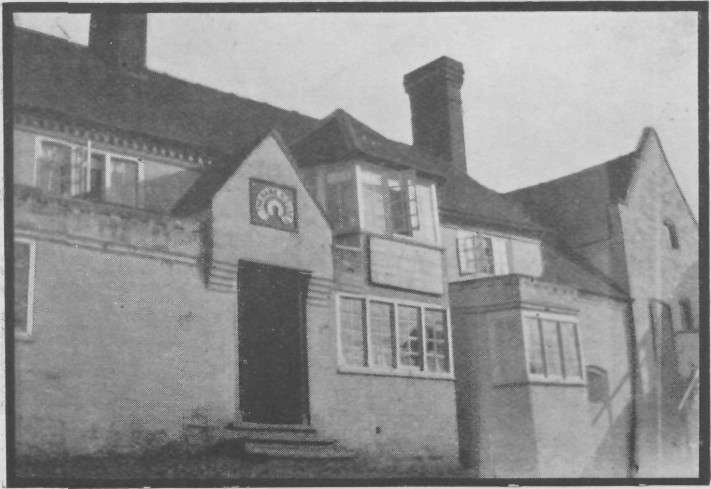
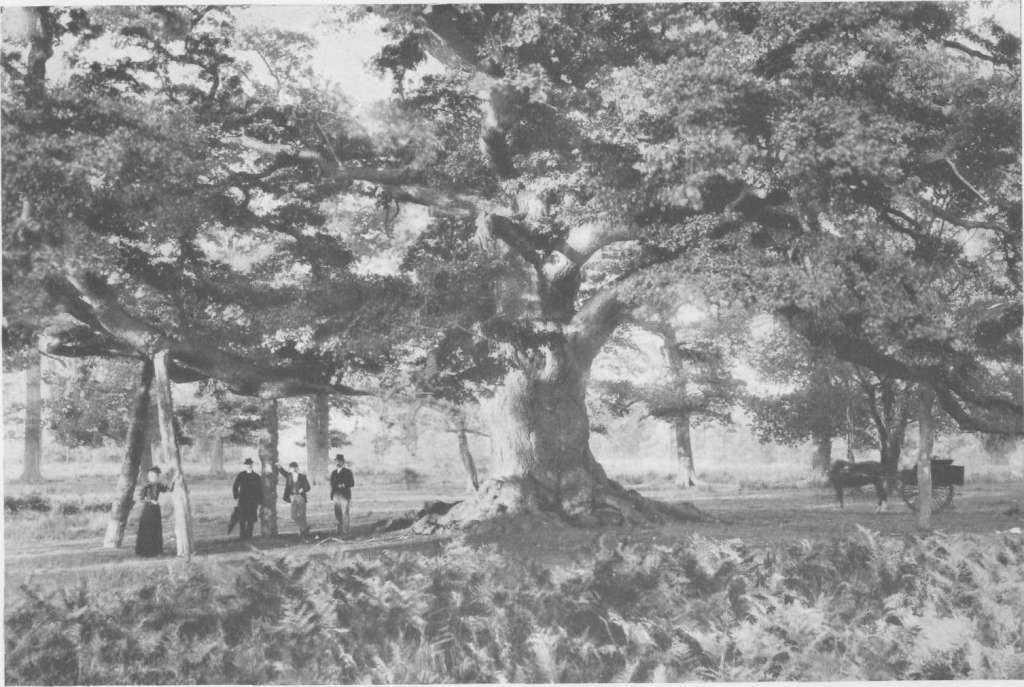
We were interested in these stories of Chartley Castle, for in our own county cattle with almost the same characteristics were preserved in the Parks of Lyme and Somerford, and probably possessed a similar history. That Ranulph was well known can be assumed from the fact that Langland in his Piers Plowman in the fourteenth century says:
I cannot perfitly my paternoster as the Priest it singeth.
But I can rhymes of Robin Hood and Randall Erie of Chester.
Queer company, and yet it was an old story that Robin did find an asylum at Chartley Castle.

THE HORN DANCERS, ABBOTS BROMLEY.
We overtook an elderly man on the road returning home from his day’s toil on the Bagot estate, and he told us of an old oak tree of tremendous size called the “Beggar’s Oak”; but it was now too dark for us to see it. The steward of the estate had marked it, together with others, to be felled and sold; but though his lordship was very poor, he would not have the big oak cut down. He said that both Dick Turpin and Robin Hood had haunted these woods, and when he was a lad a good many horses were stolen and hidden in lonely places amongst the thick bushes to be sold afterwards in other parts of the country.
The “Beggar’s Oak” was mentioned in the History of Staffordshire in 1830, when its branches were measured by Dr. Darwen as spreading 48 feet in every direction. There was also a larger oak mentioned with a trunk 21 feet 4-1/2 inches in circumference, but in a decayed condition. This was named the Swilcar Lawn Oak, and stood on the Crown lands at Marchington Woodlands, and in Bagot’s wood were also the Squitch, King, and Lord Bagot’s Walking stick, all fine trees. There were also two famous oaks at Mavesyn Ridware called “Gog and Magog,” but only their huge decayed trunks remained. Abbots Bromley had some curious privileges, and some of the great games were kept up. Thus the heads of the horses and reindeers for the “hobby horse” games were to be seen at the church.
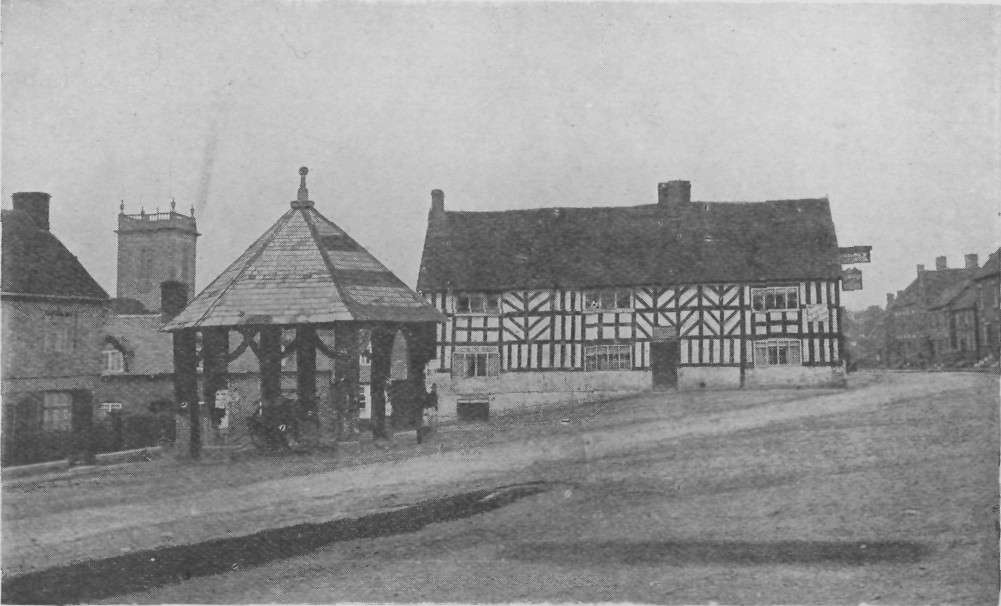
The owner of this region, Lord Bagot, could trace his ancestry back to before the Conquest, for the Normans found one Bagod in possession. In course of time, when the estate had become comparatively poor, we heard that the noble owner had married the daughter of Mr. Bass, the rich brewer of Burton, the first of the Peerage marriages with the families of the new but rich.
We passed the Butter Cross and the old inn, reminiscent of stage-coach days, as the church bell was tolling, probably the curfew, and long after darkness had set in, for we were trying to reach Lichfield, we came to the village of Handsacre, where at the “Crown Inn” we stayed the night.
(Distance walked twenty-five miles.)
Wednesday, November 1st.
Although the “Crown” at Handsacre was only a small inn, we were very comfortable, and the company assembled on the premises the previous evening took a great interest in our travels. We had no difficulty in getting an early breakfast, and a good one too, before leaving the inn this morning, but we found we had missed seeing one or two interesting places which we passed the previous night in the dark, and we had also crossed the River Trent as it flowed towards the great brewery town of Burton, only a few miles distant.

WHERE OFFA’S DYKE CROSSES THE MAIS ROAD.
Daylight found us at the foot of the famous Cannock Chase. The Chase covered about 30,000 acres of land, which had been purposely kept out of cultivation in olden times in order to form a happy hunting-ground for the Mercian Kings, who for 300 years ruled over that part of the country. The best known of these kings was Offa, who in the year 757 had either made or repaired the dyke that separated England from Wales, beginning at Chepstow in Monmouthshire, and continuing across the country into Flintshire. It was not a dyke filled with water, as for the most part it passed over a very hilly country where water was not available, but a deep trench sunk on the Welsh side, the soil being thrown up on the English side, forming a bank about four yards high, of which considerable portions were still visible, and known as “Offa’s Dyke.” Cannock Chase, which covered the elevations to our right, was still an ideal hunting-country, as its surface was hilly and diversified, and a combination of moorland and forest, while the mansions of the noblemen who patronised the “Hunt” surrounded it on all sides, that named “Beau-Desert,” the hall or hunting-box of the Marquis of Anglesey, being quite near to our road.

We soon arrived at Lichfield, and on entering the town the three lofty and ornamental spires of the cathedral, which from their smart appearance were known as “The Three Ladies,” immediately attracted our attention. But for these, travellers entering Lichfield by this road might easily have passed the cathedral without noticing it, as it stands on low and rather swampy ground, where its fine proportions do not show to advantage.
The Close of the cathedral, which partially surrounded it, was heavily fortified in the time of the Civil War, causing the cathedral to be very badly damaged, for it suffered no less than three different sieges by the armies of the Parliament.

The cathedral was dedicated to St. Chad, but whether he was the same St. Chad whose cave was in the rocky bank of the River Don, and about whom we had heard farther north, or not, we could not ascertain. He must have been a water-loving saint, as a well in the town formed by a spring of pure water was known as St. Chad’s Well, in which the saint stood naked while he prayed, upon a stone which had been preserved by building it into the wall of the well. There was also in the cathedral at one time the “Chapel of St. Chad’s Head,” but this had been almost destroyed during the first siege of 1643. The ancient writings of the patron saint in the early Welsh language had fortunately been preserved. Written on parchment and ornamented with rude drawings of the Apostles and others, they were known as St. Chad’s Gospels, forming one of the most treasured relics belonging to the cathedral, but, sad to relate, had been removed by stealth, it was said, from the Cathedral of Llandaff.
The first siege began on March 2nd, 1643, which happened to be St. Chad’s Day, and it was recorded that during that siege “Lord Brooke who was standing in the street was killed, being shot through the eye by Dumb Dyott from the cathedral steeple.” The cathedral was afterwards used by Cromwell’s men as a stable, and every ornament inside and outside that they could reach was greatly damaged; but they appeared to have tried to finish the cathedral off altogether, when in 1651 they stripped the lead from the roof and then set the woodwork on fire. It was afterwards repaired and rebuilt, but nearly all the ornaments on the west front, which had been profusely decorated with the figures of martyrs, apostles, priests, and kings, had been damaged or destroyed. At the Restoration an effort was made to replace these in cement, but this proved a failure, and the only perfect figure that remained then on the west front was a rather clumsy one of Charles II, who had given a hundred timber trees out of Needwood Forest to repair the buildings. Many of the damaged figures were taken down in 1744, and some others were removed later by the Dean, who was afraid they might fall on his head as he went in and out of the cathedral.
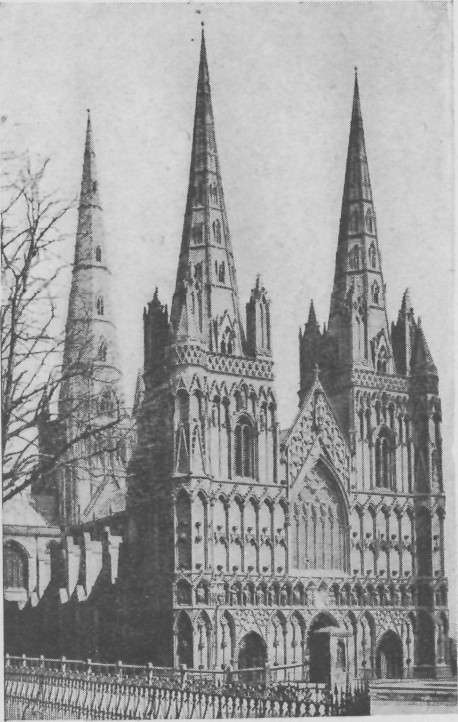
In those days chimney sweepers employed a boy to climb up the inside of the chimneys and sweep the parts that could not be reached with their brush from below, the method of screwing one stale to the end of another and reaching the top in that way being then unknown. These boys were often cruelly treated, and had even been known to be suffocated in the chimney. The nature of their occupation rendered them very daring, and for this reason the Dean employed one of them to remove the rest of the damaged figures, a service which he satisfactorily performed at no small risk both to himself and others.
There is a very fine view in the interior of the cathedral looking from west to east, which extends to a distance of 370 feet, and of which Sir Gilbert Scott, the great ecclesiastical architect, who was born in 1811, has written, “I always hold this work to be almost absolute perfection in design and detail”; another great authority said that when he saw it his impressions were like those described by John Milton in his “Il Penseroso”:
Let my due feet never fail
To walk the studious cloisters pale,
And love the high embossed roof,
With antique pillars massy proof,
And storied windows richly dight,
Casting a dim, religious light:
There let the pealing organ blow,
To the full-voiced quire below.
In service high, and anthems clear,
As may with sweetness, through mine ear,
Dissolve me into ecstacies.
And bring all heaven before mine eyes.
We had not much time to explore the interior, but were obliged to visit the white marble effigy by the famous Chantrey of the “Sleeping Children” of Prebendary Robinson. It was beautifully executed, but for some reason we preferred that of little Penelope we had seen the day before, possibly because these children appeared so much older and more like young ladies compared with Penelope, who was really a child. Another monument by Chantrey which impressed us more strongly than that of the children was that of Bishop Ryder in a kneeling posture, which we thought a very fine production. There was also a slab to the memory of Admiral Parker, the last survivor of Nelson’s captains, and some fine stained-glass windows of the sixteenth century formerly belonging to the Abbey of Herckrode, near Liège, which Sir Brooke Boothby, the father of little Penelope, had bought in Belgium in 1803 and presented to the cathedral.
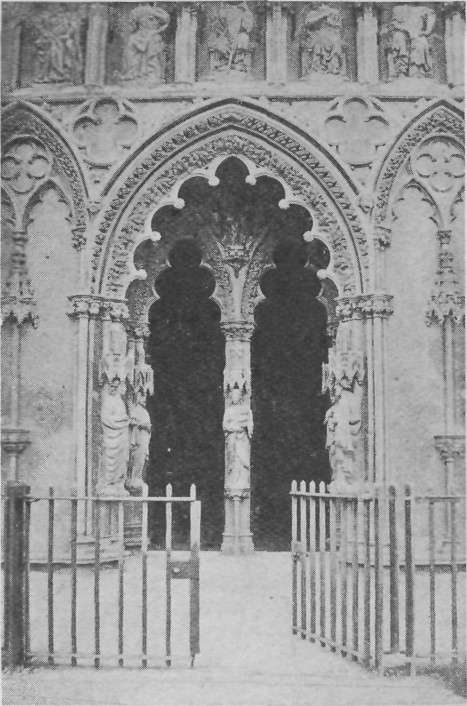
The present bishop, Bishop Selwyn, seemed to be very much loved, as everybody had a good word for him. One gentleman told us he was the first bishop to reside at the palace, all former bishops having resided at Eccleshall, a town twenty-six miles away. Before coming to Lichfield he had been twenty-two years in New Zealand, being the first bishop of that colony. He died seven years after our visit, and had a great funeral, at which Mr. W.E. Gladstone, who described Selwyn as “a noble man,” was one of the pall-bearers. The poet Browning’s words were often applied to Bishop Selwyn:
We that have loved him so, followed and honour’d him,
Lived in his mild and magnificent eye,
Caught his clear accents, learnt his great language,
Made him our pattern to live and to die.
There were several old houses in Lichfield of more than local interest, one of which, called the Priest’s House, was the birthplace in 1617 of Elias Ashmole, Windsor Herald to King Charles II, and founder of the Ashmolean Museum at Oxford. When we got into the town, or city, we found that, although St. Chad was the patron saint of the cathedral, there was also a patron saint of Lichfield itself, for it was Johnson here, Johnson there, and Johnson everywhere, so we must needs go and see the house where the great Doctor was born in 1709. We found it adjoining the market-place, and in front of a monument on which were depicted three scenes connected with his childhood: the first showing him mounted on his father’s back listening to Dr. Sacheverell, who was shown in the act of preaching; the second showed him being carried to school between the shoulders of two boys, another boy following closely behind, as if to catch him in the event of a fall; while the third panel represents him standing in the market-place at Uttoxeter, doing penance to propitiate Heaven for the act of disobedience to his father that had happened fifty years ago. When very young he was afflicted with scrofula, or king’s evil; so his mother took him in 1712, when he was only two and a half years old, to London, where he was touched by Queen Anne, being the last person so touched in England. The belief had prevailed from the time of Edward the Confessor that scrofula could be cured by the royal touch, and although the office remained in our Prayer Book till 1719, the Jacobites considered that the power did not descend to King William and Queen Anne because “Divine” hereditary right was not fully possessed by them; which doubtless would be taken to account for the fact that Johnson was not healed, for he was troubled with the disease as long as he lived. When he was three years old he was carried by his father to the cathedral to hear Dr. Sacheverell preach. This gentleman, who was a Church of England minister and a great political preacher, was born in 1672. He was so extremely bitter against the dissenters and their Whig supporters that he was impeached before the House of Lords, and suspended for three years, while his sermon on “Perils of False Brethren,” which had had an enormous sale, was burnt by the common hangman! It was said that young Johnson’s conduct while listening to the doctor’s preaching on that occasion was quite exemplary.
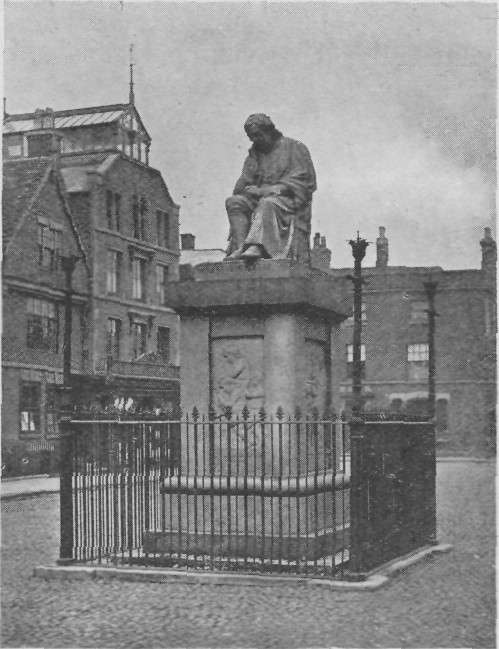
MONUMENT TO SAMUEL JOHNSON, LICHFIELD.
Johnson was educated at the Lichfield Grammar School under Dr. Hunter, who was a very severe schoolmaster, and must have been one of those who “drove it in behind,” for Johnson afterwards wrote: “My Master whipt me very well. Without that I should have done nothing.” Dr. Hunter boasted that he never taught a boy anything; he whipped and they learned. It was said, too, that when he flogged them he always said: “Boys, I do this to save you from the gallows!” Johnson went to Oxford, and afterwards, in 1736, opened a school near Lichfield, advertising in the Gentleman’s Magazine for young gentleman “to be boarded and taught the Latin and Greek languages, by Samuel Johnson.” He only got eight pupils, amongst whom was David Garrick, who afterwards became the leading tragic actor of his time. Johnson had for some time been at work on a tragedy called The Tragedy of Irene, though whether this decided Garrick to become a tragedy actor is not known; the play, however, did not succeed with the play-going public in London, and had to be withdrawn. Neither did the school succeed, and it had to be given up, Johnson, accompanied by David Garrick, setting off to London, where it was said that he lived in a garret on fourpence-halfpenny per day. Many years afterwards, when Johnson was dining with a fashionable company, a remark was made referring to an incident that occurred in a certain year, and Johnson exclaimed: “That was the year when I came to London with twopence-halfpenny in my pocket.”
Garrick overheard the remark, and exclaimed: “Eh, what do you say? with twopence-halfpenny in your pocket?”
“Why, yes; when I came with twopence-halfpenny in my pocket, and thou, Davy, with three-halfpence in thine.”
Poverty haunted Johnson all through life until 1762, when he was granted a pension of £300 a year by King George III, on the recommendation of Lord Bute, the Prime Minister, who, in making the offer, said: “It is not given you for anything you are to do, but for what you have done.” In the meantime Johnson had brought out his great Dictionary, at which he had worked for years in extreme poverty, and in the progress of which he had asked Lord Chesterfield to become his patron, in the hope that he would render him some financial assistance. When he went to see him, however, he was kept waiting for over an hour, while his lordship amused himself by conversing with some second-rate mortal named “Colley Cibber,” and when this man came out, and Johnson saw who it was for whom he had been kept waiting, he hurriedly and indignantly took his departure. When his Dictionary was nearly ready for publication and likely to become a great success, his lordship wrote to Johnson offering to become his patron; but it was now too late, and Johnson’s reply was characteristic of the man, as the following passages from his letter show:
Seven years, my Lord, have now passed since I waited in your outward rooms, or was repulsed from your door; during which time I have been pushing on with my work through Difficulties, of which it is useless to complain, and have brought it, at last, to the verge of publication, without one act of assistance, one word of encouragement, or one-smile of favour. Such treatment I did not expect, for I never had a Patron before. The notice you have been pleased to take of my labours, had it been early, had been kind; but it has been delayed till I am indifferent, and cannot enjoy it; till I am solitary, and cannot impart it; till I am known, and do not want it. I hope it is no cynical asperity not to confess obligations where no benefit has been received, or to be unwilling that the public should consider me as owing that to a patron which Providence has enabled me to do for myself!

LICHFIELD CATHEDRAL, WEST FRONT.
Johnson’s name is often associated with London taverns, but it would be wrong to assume on that account that he had bibulous tendencies, for although he described Boswell, who wrote his splendid biography, as a “clubable” man, and the tavern chair as the throne of human felicity, it should be remembered that there were no gentlemen’s clubs in London in those days, hence groups of famous men met at the taverns. Johnson had quite a host of friends, including Garrick, Burke, Goldsmith, Savage (whose biography he wrote), Sheridan, and Sir Joshua Reynolds. When Sir Joshua Reynolds and Johnson were dining at Mrs. Garrick’s house in London they were regaled with Uttoxeter ale, which had a “peculiar appropriate value,” but Johnson’s beverage at the London taverns was lemonade, or the juice of oranges, or tea, and it was his boast that “with tea he amused the evenings, with tea solaced the midnight hour, and with tea welcomed the morning.” He was credited with drinking enormous quantities of that beverage, the highest number of cups recorded being twenty-five at one time, but the size of the cups were very much smaller in those days.
Johnson, who died in 1784 at the age of seventy-five, was buried in Westminster Abbey, and, mainly through the exertions of his friend Sir Joshua Reynolds, a statue of him was erected in St. Paul’s Cathedral.
Other eminent men besides Dr. Johnson received their education at Lichfield Grammar School: Elias Ashmole, founder of the Ashmolean Museum at Oxford, Joseph Addison the great essayist, whose father was Dean of Lichfield, and David Garrick the actor, were all educated at the Grammar School. There were five boys who had at one period attended the school who afterwards became judges of the High Court: Lord Chief Justice Willes, Lord Chief Justice Wilmot, Lord Chief Baron Parker, Mr. Justice Noel, and Sir Richard Lloyd, Baron of the Exchequer.
Leaving Lichfield, we passed along the racecourse and walked as quickly as we could to Tamworth, where at the railway station we found our box awaiting us with a fresh change of clothing. In a few minutes we were comfortably rigged out for our farther journey; the box, in which my brother packed up the stones, was then reconsigned to our home address. I was now strong enough to carry my own luggage, which seemed to fit very awkwardly in its former position, but I soon got over that. There was at Tamworth a fine old church dedicated to St. Editha which we did not visit. We saw the bronze statue erected in 1852 to the memory of the great Sir Robert Peel, Bart., who represented Tamworth in Parliament, and was twice Prime Minister, and who brought in the famous Bill for the Abolition of the Corn Laws. These Laws had been in operation from the year 1436. But times had changed: the population had rapidly grown with the development of industries, so that being limited to home production, corn reached such a high price that people came to see that the laws pressed hardly upon the poorer classes, hence they were ultimately abolished altogether. The Bill was passed in 1846, Cobden, Bright, and Villiers leading the agitation against them, and after the Corn Laws were abolished a period of great prosperity prevailed in England.

SIR ROBERT PEEL.
From the portrait by Sir Thomas Lawrence.
Sir Robert Peel died from the effect of an accident sustained when riding on horseback in Hyde Park, on June 25th, 1850; he fell from his horse, dying three days afterwards, and was buried in his mausoleum, in the Parish Church of Drayton Bassett, a village about two miles from Tamworth.
It was the day of the Municipal Elections as we passed through Tamworth, but, as only one ward was being contested, there was an almost total absence of the excitement usual on such occasions.
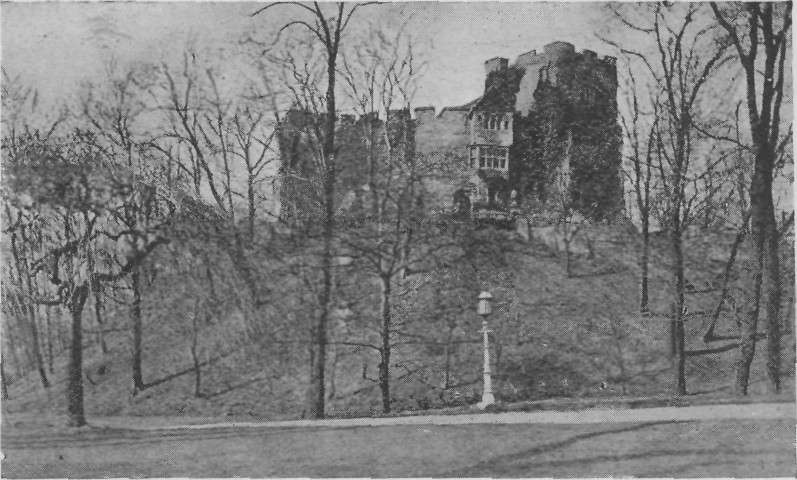
Tamworth Castle contains some walls that were built by the Saxons in a herringbone pattern. There was a palace on the site of the castle in the time of Ofta, which was the chief residence of the Kings of Mercia; but William the Conqueror gave the castle and town of Tamworth and the Manor of Scrivelsby in Lincolnshire to his dispensor, or royal steward, Robert of Fontenaye-le-Marmion in Normandy, whose family were the hereditary champions of the Dukes of Normandy:
These Lincoln lands the Conqueror gave,
That England’s glove they might convey
To Knight renowned amongst the brave—
The Baron bold of Fontenaye.
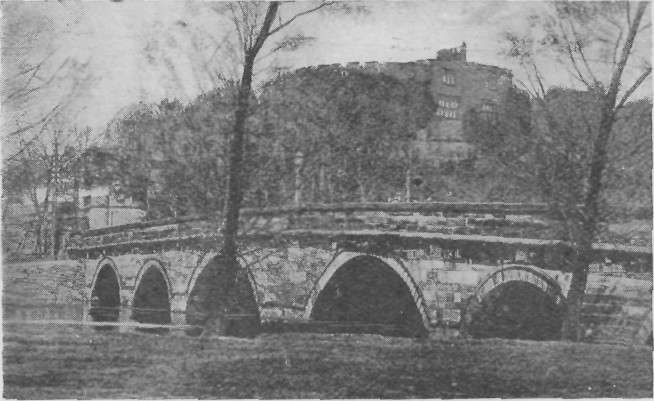
Robert Marmion, therefore, was the first “King’s Champion of England,” an honour which remained in his family until the death of the eighth Lord, Philip Marmion, in 1291. This man was one of the leading nobles at the Court of Henry III, and the stubborn defender of Kenilworth Castle, acting as King’s Champion at the Coronation of Edward I on August 19th, 1274. The duty of the King’s Champion on the day of Coronation was to ride completely armed on a barbed horse into Westminster Hall, and there to challenge to combat any who should gainsay the king’s title. On the death of Philip de Marmion the Castle of Tamworth passed by marriage to the Trevilles, Sir Alexander Treville, as owner of the castle, officiating; as Royal Champion at the Coronation of Edward III in 1327; but at the Coronation of Richard II, in 1377, the right of the Treville family to act as champion was disputed by Sir John Dymoke, to whom the Manor of Scrivelsby had descended by marriage from another relative of Phillip Marmion. It was decided that the office went with the Manor of Scrivelsby, and the Dymokes had acted as King’s Champion ever since, their coat of arms bearing in Latin the motto, “I fight for the king.”
As we passed over what is known as the Lady Bridge spanning the River Tame, just where it joins the River Anker at the foot of the castle, we saw a stone built in the bridge called the Marmion Stone, and remembered Sir Walter Scott’s “Tale of Flodden Field” and his famous lines:
“Charge, Chester, charge! On, Stanley, on!”
Were the last words of Marmion.
But we found other references in Sir Walter’s “Marmion”:
Two pursuivants, whom tabards deck,
With silver scutcheon round their neck
And there, with herald pomp and state,
They hail’d Lord Marmion:
They hail’d him Lord of Fontenaye,
Of Lutterward, and Scrivelsbaye,
Of Tamworth tower and town.
and in the Fifth Canto in “Marmion,” King James of Scotland is made to say:
“Southward I march by break of day;
And if within Tantallon strong.
The good Lord Marmion tarries long,
Perchance our meeting next may fall
At Tamworth, in his castle-hall.”—
The haughty Marmion felt the taunt,
And answer’d, grave, the royal vaunt:
“Much honour’d were my humble home,
If in its halls King James should come.
And many a banner will be torn,
And many a knight to earth be borne,
And many a sheaf of arrows spent.
Ere Scotland’s King shall cross the Trent.”
Sir Walter described Marmion as having been killed in the battle together with one of his peasants, and that as both bodies had been stripped and were covered with wounds, they could not distinguish one from the other, with the result that the peasant was brought and buried at Lichfield instead of his lord.
Short is my tale:—Fitz-Eustace’ care
A pierced and mangled body bare
To moated Lichfield’s lofty pile;
And there, beneath the southern aisle,
A tomb, with Gothic sculpture fair,
Did long Lord Marmion’s image bear,
(Now vainly for its sight you look;
‘Twas levell’d when fanatic Brook
The fair cathedral storm’d and took;
But, thanks to Heaven, and good Saint Chad,
A guerdon meet the spoiler had!)
There erst was martial Marmion found,
His feet upon a couchant hound,
His hands to heaven upraised:
And all around, on scutcheon rich,
And tablet carved, and fretted niche,
His arms and feats were blazed.
And yet, though all was carved so fair,
And priest for Marmion breathed the prayer,
The last Lord Marmion lay not there.
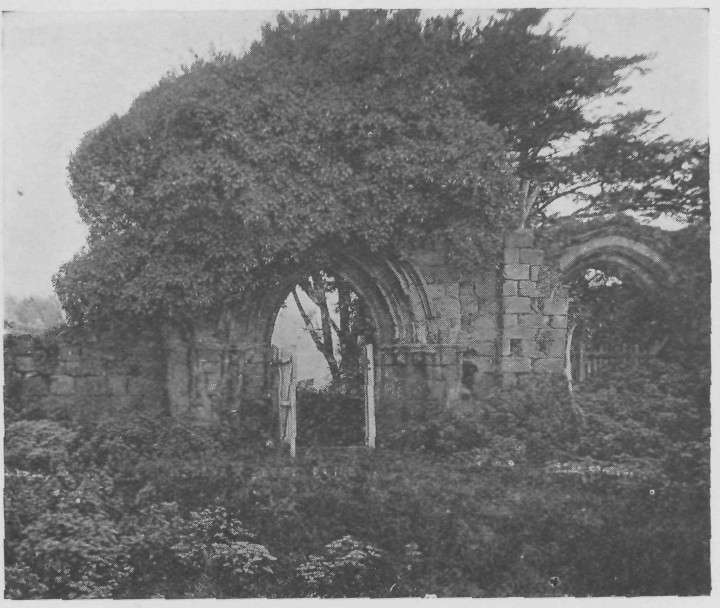
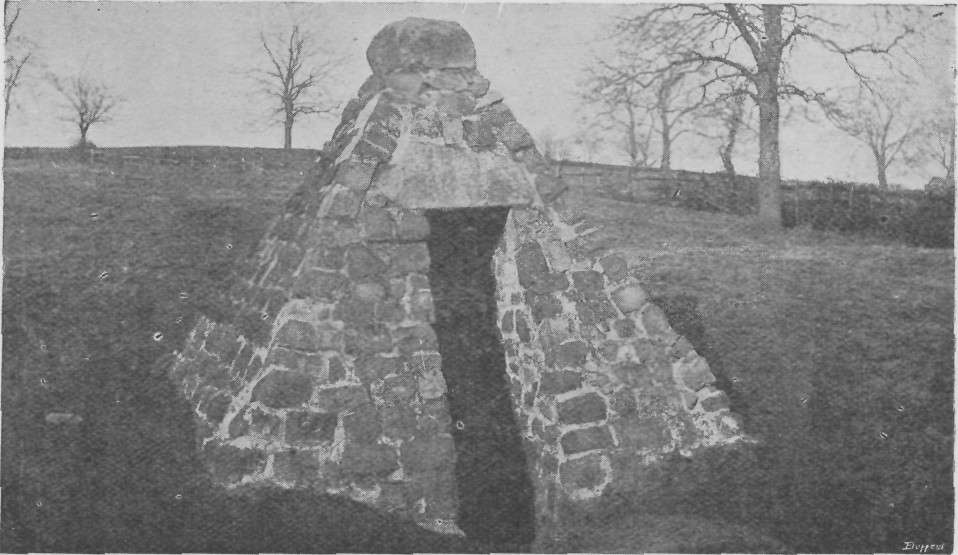
The Marmion stone on the bridge has five unequal sides, and at one time formed the base for a figure of the Virgin and the Child, which stood on the bridge. The ancient family of Basset of Drayton, a village close by, were in some way connected with this stone, for on one side appeared the arms of the family, on another the monogram M.R. surmounted by a crown, and on the two others the letters I.H.C. About two miles farther on we entered the village of Fazeley, purposely to see a house where a relative of ours had once resided, being curious to know what kind of a place it was. Here we were only a short distance away from Drayton Manor, at one time the residence of the great Sir Robert Peel. Having gratified our curiosity, we recrossed the River Tame, passing along the great Watling Street, the Roman Road which King Alfred used as a boundary in dividing England with the Danes, towards Atherstone in search of “fields and pastures new,” and in a few miles reached the grounds of Merevale Abbey, now in ruins, where Robert, Earl Ferrers, was buried, long before coffins were used for burial purposes, in “a good ox hide.” Here we reached the town of Atherstone, where the staple industry was the manufacture of hats, the Atherstone Company of Hat-makers being incorporated by charters from James I and Charles II. Many of the chiefs on the West Coast of Africa have been decorated with gorgeous hats that have been made at Atherstone. When the Romans were making their famous street and reached the spot where Atherstone now stands, they came, according to local tradition, to a large stone that was in their way, and in moving it they disturbed a nest of adders, which flew at them. The stone was named Adders’ Stone, which gradually became corrupted to Athers’ Stone, and hence the name of the town. The Corporation of the Governors embodied this incident in their coat of arms and on the Grammar School, which was endowed in 1573: a stone showed the adders as springing upwards, and displaying the words, “Adderstonien Sigil Scholæ.” We called at the “Old Red Lion Inn,” and, going to explore the town while our refreshments were being prepared, found our way to a church, once part of a monastery, where the old fourteenth-century bell was still tolled. It was in the chancel of this church that Henry, Earl of Richmond, partook of Holy Communion on the eve of his great victory over Richard III at the Battle of Bosworth Field, by which he became King Henry VII. He had also spent a night at the “Three Tuns Inn” preparing his plans for the fight, which occurred two days later, August 22nd, 1485. There was on the site of the battle a well named “King Dick’s Well,” which was covered with masonry in the form of a pyramid, with an entrance on one of its four sides, and which covered the spring where Richard, weary of fighting, had a refreshing drink before the final charge that ended in his death. He, however, lost the battle, and Henry of Richmond, who won it, was crowned King of England at Stoke Golding Church, which was practically on the battlefield, and is one of the finest specimens of decorated architecture in England. But what an anxious and weary time these kings must have had! not only they, but all others. When we considered how many of them had been overthrown, assassinated, taken prisoners in war, executed, slain in battle, forced to abdicate, tortured to death, committed suicide, and gone mad, we came to the conclusion that Shakespeare was right when he wrote, “Uneasy lies the head that wears a crown.” In his King Richard II he makes the King say:
“And nothing can we call our own but death,
And that small model of the barren earth
Which serves as paste and cover to our bones.
For God’s sake, let us sit upon the ground
And tell sad stories of the death of Kings:
How some have been deposed, some slain in war,
Some haunted by the ghosts they have deposed,
Some poison’d by their wives, some sleeping kill’d;
All murder’d.”
One good result of the Battle of Bosworth Field was that it ended the “Wars of the Roses,” which had been a curse to England for thirty years.
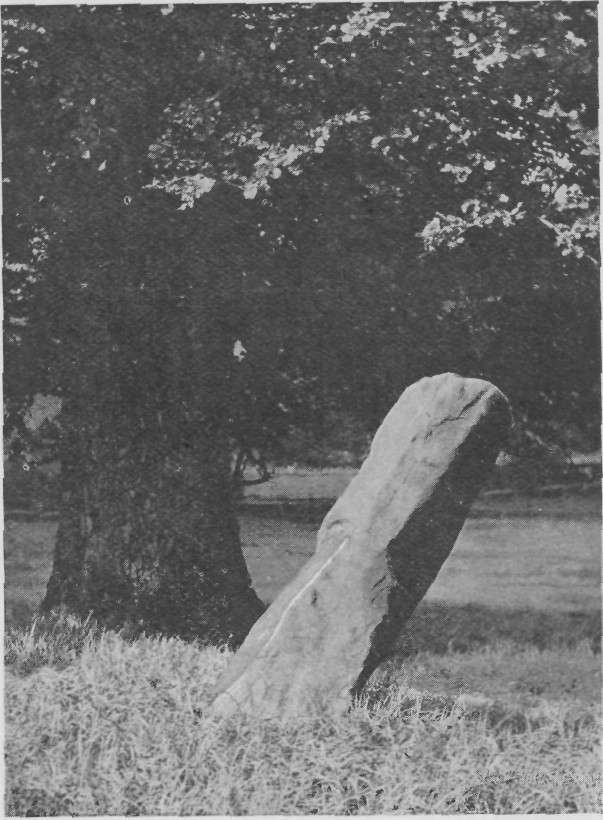
BULL BAITING STONE, ATHERSTONE.
Bull-baiting was one of the favourite sports of our forefathers, the bull being usually fastened to an iron ring in the centre of a piece of ground, while dogs were urged on to attack it, many of them being killed in the fight. This space of land was known as the Bull-ring, a name often found in the centre of large towns at the present day. We knew a village in Shropshire where the original ring was still to be seen embedded in the cobbled pavement between the church and the village inn. But at Atherstone the bull had been fastened to a large stone, still to be seen, but away from the road, which had now been diverted from its original track.
The ancient whipping-post, along with the stocks, which had accommodation for three persons, had found their last resting-place inside the old market-hall. They must have been almost constantly occupied and used in the good old times, as Atherstone was not only on the great Watling Street, but it had a unique position on the other roads of the country, as an old milestone near our hotel, where we found our refreshments waiting our arrival, informed us that we were a hundred miles from London, a hundred miles from Liverpool, and a hundred miles from Lincoln, so that Atherstone could fairly claim to be one of the central towns in England, though the distance to Lincoln had been overstated.

STOCKS IN ATHERSTONE MARKET-HALL.
We continued walking along the Watling Street for a short distance, until we reached the end of the town, and then we forked on to the right towards Nuncaton; but in a very short distance we came to the village of Mancetter, where there was a fine old church, apparently the Parish Church of Atherstone. When the Romans were here they protected their “Street” by means of forts, and one in a small chain of these was at Mancetter, the Manduesdum of the Romans, their camp appearing in the form of a square mound, with the “Street” passing through the centre. Inside the church were quite a number of very old books, in one of which we were shown a wood-cut representing the burning of Robert Glover and Cornelius Bongley at Coventry in 1555. Glover was a gentleman who lived at the Manor House here, and was one of the Mancetter Martyrs, the other being Mrs. Lewis, a tenant of his who lived at the Manor House Farm. She was burnt in 1557, two years later. A large tablet was placed in the church to their memories, both of them having suffered for their adherence to the Protestant Faith. The east-end window was a curiosity, for it contained a large quantity of thirteenth-century stained glass which had been brought here from Merevale Abbey. It was probably damaged both there and in transit, as it seemed to have a somewhat rough appearance; the verger informed us, when pointing out several defects in the figures, that a local glazier had been employed to erect it who did not understand such work, and though he had no doubt done his best, he had made some awkward mistakes. Why David’s sword appeared behind his back the verger could not explain, so my brother suggested that either the head or the body had been turned the wrong way about.
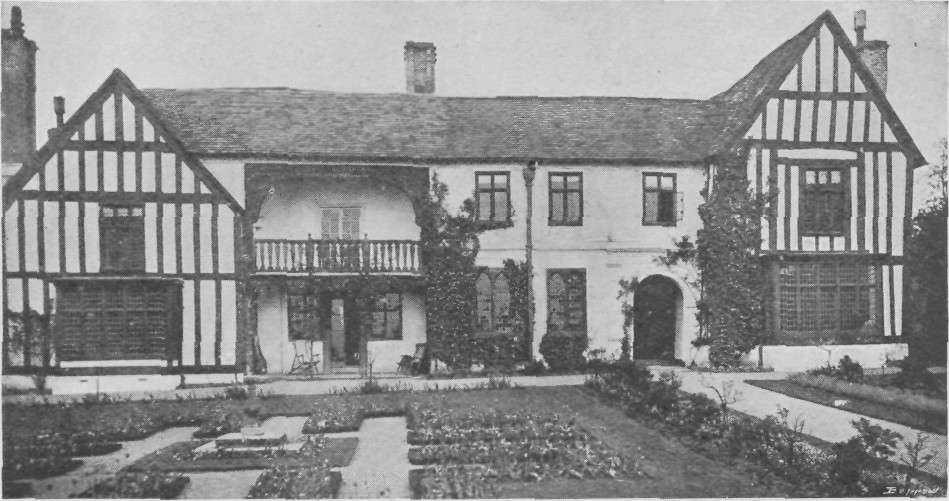
There were five bells in the church tower, the largest of which was, of course, the tenor bell, weighing thirty-three hundredweight, and the words that had been cast on it set us a-thinking:
My soaring sound does warning give
That a man on earth not only lives.
There were usually some strange records in these country churchyards, and we generally found them in the older portions of the burial-grounds; but we had very little time to look for them as the night was coming on, so we secured the services of the verger, who pointed out in the new part of the churchyard a stone recording the history of Charles Richard Potter in the following words:
Born—May 11, 1788.
Married—May 11, 1812.
Died—May 11, 1858.
So the eleventh day of May was a lucky or an unlucky day for Mr. Potter—probably both; but one strange feature which we only thought of afterwards was that he had lived exactly the allotted span of three score years and ten. In the old part of the yard were the following epitaphs:
The Earth’s a City
Full of crooked streets
Death is ye market-place
Where all must meet
If life was merchandise
That man could buy
The rich would always live
Ye poor must die.
In bygone times it was no unusual thing to find dead bodies on the road, or oftener a short distance from it, where the owners had laid themselves down to die; we ourselves remembered, in a lonely place, only a field’s breadth from the coach road to London, a pit at the side of which years ago the corpse of a soldier had been found in the bushes. Here, apparently, there had been a similar case, with the exception that the man had been found by the side of the Watling Street instead of the fields adjoining. No one in the district knew who the stranger was, but as sufficient money had been found on him to pay the cost of the burial, his corpse was placed in Mancetter Churchyard, and as his name was unknown, some mysterious initials, of which no one now living knew the meaning, appeared on the headstone.
Here lieth interr’d the Body of
I.
H. I. M.
What Ere we was or am
it matters not
to whom related,
or by whom begot,
We was, but am not.
Ask no more of me
‘Tis all we are
And all that you must be.
We now hurried on, but as every finger-post had been painted white to receive the new letters, the old words beneath the paint were quite illegible, and, the road being lonely, of course we got lost, so, instead of arriving at Nuneaton, we found ourselves again at the Watling Street, at a higher point than that where we had left it when leaving Atherstone. Nearly opposite the lane end from which we now emerged there was a public-house, set back from the road, where a sign, suspended from a pole, swung alongside the Watling Street to attract the attention of travellers to the inn, and here we called to inquire our way to Nuneaton. The name of the house was the “Royal Red Gate Inn,” the pole we had seen on the Watling Street holding a wooden gate painted red. We asked why the red gate was a royal one, and the landlady said it was because Queen Adelaide once called there, but who Queen Adelaide was, and when she called there, she did not know. When asked what she called for, she replied, “I don’t know, unless it was for a drink!” As we did not know who Queen Adelaide was ourselves, we had to wait until we reached Nuneaton, where we were informed that she was the wife of William IV, and that in her retirement she lived at Sudbury Hall in Derbyshire, so this would be on her coach road to and from London. The lane at one end of the Red Gate went to Fenney Drayton, where George Fox the Quaker was born, about whom we had heard farther north; but we had to push on, and finally did reach Nuneaton for the night.
(Distance walked twenty-seven miles.)
Thursday, November 2nd.
In our early days we used to be told there was only one man in Manchester, which fact was true if we looked at the name; in the same way we were told there was but one nun in Nuneaton, but the ruins of the nunnery suggested that there must have been quite a number there in the past ages. We had seen many monasteries in our travels, but only one nunnery, and that was at York; so convent life did not seem to have been very popular in the North country, the chorus of a young lady’s song of the period perhaps furnishing the reason why:
Then I won’t be a Nun,
And I shan’t be a Nun;
I’m so fond of pleasure
That I cannot be a Nun.
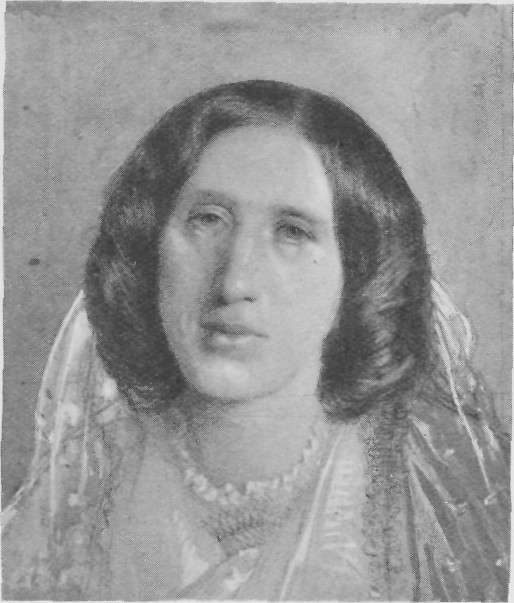
The nuns had of course disappeared and long since been forgotten, but other women had risen to take their places in the minds and memories of the people of Nuneaton, foremost amongst whom was Mary Ann Evans, who was born about the year 1820 at the South Farm, Arbury, whither her father, belonging to the Newdegate family, had removed from Derbyshire to take charge of some property in Warwickshire. “George Eliot” has been described as “the greatest woman writer in English literature,” and as many of her novels related mainly to persons and places between Nuneaton and Coventry, that district had been named by the Nuneaton people “The Country of George Eliot.” Scenes of Clerical Life was published in 1858, and The Mill on the Floss in 1860, and although the characters and places are more difficult to locate than those in Adam Bede, the “Bull Hotel” at Nuneaton has been identified as the “Red Lion” in her novel, where Mr. Dempster, over his third glass of brandy and water, would overwhelm a disputant who had beaten him in argument, with some such tirade as: “I don’t care a straw, sir, either for you or your encyclopædia; a farrago of false information picked up in a cargo of waste paper. Will you tell me, sir, that I don’t know the origin of Presbyterianism? I, sir, a man known through the county; while you, sir, are ignored by the very fleas that infest the miserable alley in which you were bred!”
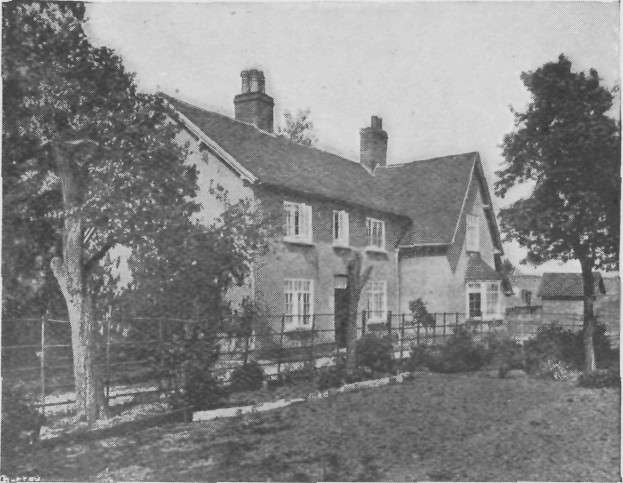
SOUTH FARM, ARBURY, THE BIRTHPLACE OF “GEORGE ELIOT”
We left the “Newdegate Arms” at Nuneaton early in the morning, on our way to Lutterworth, our next object of interest, and passed by the village of Hartshill, where Michael Drayton was born in 1563. He was a lyric poet of considerable fame and a friend of Shakespeare. His greatest work, Polyolbion, a poetic description of different parts of England, was published in 1613. He became Poet Laureate, and at his death, in 1631, was buried in Westminster Abbey.
We again went astray owing to the finger-posts being without names, but at length reached the Watling Street at cross-roads, where there was a very old public-house called “The Three Pots,” and here we turned to the right along the Street. The road was very lonely, for there were very few houses on the Street itself, the villages being a mile or two away on either side, but we had not gone very far before we met a Church of England clergyman, who told us he had just returned from India, and that he would much have liked to form one of our company in the journey we were taking. He was sorry he had not met us lower down the road so that he could have detained us a short time to listen to some of our tales of adventures, and he would have given us a glass of beer and some bread and cheese; which he altered to milk and eggs when we told him we did not drink beer. We explained to him that we should never be able to complete our journey if we joined the company of the beer-drinkers at the many taverns we passed, and lingered at, on our way. Our experience was that we were expected to tell tales, and the farther we travelled the more we should have had to tell. He quite saw the force of our argument, and then he said: “I presume you are not married,” and when we told him we were not, he said, “I thought not, as you would never have been allowed to engage in so long a journey,” and added, “I am just about to be married myself.” We told him we were sorry he was about to lose his liberty, and, wishing him much happiness, and again thanking him for his proffered hospitality, we resumed our march.
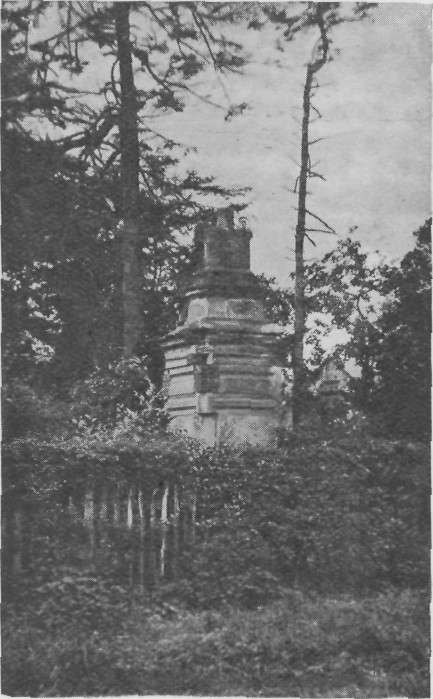
HIGH CROSS, THE CENTRE OF ENGLAND.
In passing through country villages we often met the local clergyman or doctor, of whom we invariably inquired concerning any objects of interest to be seen. It was marvellous how many of them expressed a wish to imitate our example. This, however, was only on fine days, for we seldom met those gentlemen when the weather was bad, and we wondered whether, if we had, they would still have expressed a wish to form one of our company! Fine weather prevailed that day, and we soon arrived at the High Cross which marked the Roman centre of England. It was at this point that their most celebrated roads, the Fosse Way and the Watling Street, crossed each other, running, we supposed, from north-east to south-west and from north-west to south-east, to the extreme ends of the kingdom in each direction. The Cross in the time of the Romans was made of wood, being replaced or renewed in successive generations, until in the middle of the seventeenth century it was utilised as a finger-post, consisting of a long pole with four arms, to direct the way from “London to West Chester,” and from “York to Bristol.” In 1712 an ornamental stone cross was erected on the same spot by a number of gentlemen headed by Basil, the fourth Earl of Denbigh, who had large estates in that neighbourhood. The tableland on which it stood was 440 feet above the sea-level, rivers running from it in every direction, and such was the extent of the country visible from the Cross that with the aid of a telescope fifty-six churches could be seen. This elevated position might account for the Cross being struck by lightning in 1791 and partially destroyed, but the inscriptions on the base, which had been left standing, were still visible, although partially obscured by the numerous names and initials of vandals, who have succeeded in closing many interesting places to more civilised and sensible people. We could perhaps go further and describe them as fools, for what will it matter to posterity what their initials or names are; they only rouse the ire of those who follow them and a feeling of disappointment that they had not caught the offenders in their act of wanton mischief and been able to administer some corporal punishment or other.
Years ago the benevolent owner of a fine estate situated near a town decided to open his beautiful grounds to his poorer neighbours, but before doing so he erected at the entrance gate two large wooden tablets resembling the two tablets of the Ten Commandments formerly fixed in churches but now rapidly disappearing, and on these he caused his conditions and desires to be painted in poetry, four verses on each tablet. They represent what most landowners desire but few obtain:
I
No chief to enter at this gate
To wander through this fine estate;
The owner of this ancient Hall
A kindly welcome bids to all:
Yet hopes that no one will neglect
The following wishes to respect.
II
When in the meadows grown for hay.
Keep to the Drive or right of way.
Fright not the cattle on the lea
Nor damage flower nor shrub nor tree;
And let no vestiges be found
Of paper, scattered o’er the ground.
III
One more request will sure suffice:
From carving any rude device
Refrain! and oh let no one see
Your name on post, or bridge or tree.
Such were the act of fool, whose name
We fear can ne’er descend to fame.
IV
Your olive-branches with you take,
And let them here their pastime make.
These scenes will ever seem more fair
When children’s voices fill the air:
Or bring, as comrade in your stroll,
Your Dog, if under due control.
V
If, to the gentle art inclined,
To throw a fly you have a mind.
Send in your card and state your wish
To be allowed to catch a fish:
Or if the woodland to explore,
Pray seek permission at the door.
VI
These boons are granted not quite free,
Y’et for a very moderate fee;
Nor fear but what it is ordained
That all the money thus obtained
Shall to the fund be handed down
For aid to sick in yonder Town.
VII
The owner of this blest domain
Himself to sojourn here is fain;
And if by land or sea he roam
Yet loveth best his native home,
Which, for two centuries or near,
His ancestors have held so dear.
VIII
Admire well the graceful art
Of Nature’s hand in every part:
Full well he knoweth how to prize
This fair Terrestrial Paradise;
And ’tis his wish sincere and true
That others should enjoy it too.
But to return to the High Cross and the Watling Street. The description on the Cross was in Latin, of which the following is a translation:
The noblemen and gentry, ornaments of the counties of Warwickshire and Leicestershire at the instance of the Right Honourable Basil Earl of Denbigh, have caused this pillar to be erected in grateful as well as perpetual remembrance of peace at last restored by her Majesty Queen Anne. If, Traveller, you search for the footsteps of the ancient Romans you may here behold them. For here their most celebrated ways crossing one another extend to the utmost boundaries of Britain. Here the Bennones kept their quarters and at the distance of one mile from here Claudius, a certain commander of a Cohort, seems to have had a camp towards the Street, and towards the Fosse a tomb.
We were pleased to see that the remains of the Cross had been enclosed in the garden of a house belonging to the Earl of Denbigh, a descendant of the Earl who had been instrumental in building it, and it was now comparatively safe from further defacement.
The Romans built stations along their roads, and near the High Cross stood their military station Bennones, on the side of which many Roman remains, including a Roman urn, had been discovered. It was of great importance to them that any hostile movement amongst the turbulent Britons should be reported immediately, so young men who were quick runners were employed to convey intelligence from one station to another; but this system was improved upon later by building on the side of the road, in as prominent a position as possible, at intervals of five or six miles, a house where forty horses were stabled so that news or soldiers could, if required, be carried by relays of horses a distance of a hundred miles along the road in the course of a single day. We were now only about twelve miles from Leicester, and we had to walk about six miles in that county in order to reach Lutterworth, famous throughout England as the parish where the great Reformer John Wiclif spent the last nineteen years of his life as rector. We passed through a fine grazing and fox-hunting country on our way, and found Lutterworth a rather pleasantly situated little town. Our first visit was naturally to the church, and as we walked along the quiet street leading up to it we saw a woman standing at her cottage door, to whom we spoke concerning the great divine, asking incidentally how long it was since he was rector there. She said she did not know exactly, but as far as she could remember she thought it was about 146 years since he died. On arriving at the church we found that it was about 487 years since Wiclif departed, and we thought it strange that a lady who lived almost under the shadow of the church steeple could have been so ill-informed. The church had recently been restored, and a painting of the Day of Doom, or Judgment, had been discovered over the arch of the chancel under the whitewash or plaster, which we were told Oliver Cromwell had ordered to be put on. At the top of this picture our Saviour was represented as sitting on a rainbow with two angels on each side, two of whom were blowing trumpets, and on the earth, which appeared far down below, the graves were opening, and all sorts of strange people, from the king down to the humblest peasant, were coming out of their tombs, while the fire and smoke from others proclaimed the doom of their occupants, and skulls and bones lay scattered about in all directions.
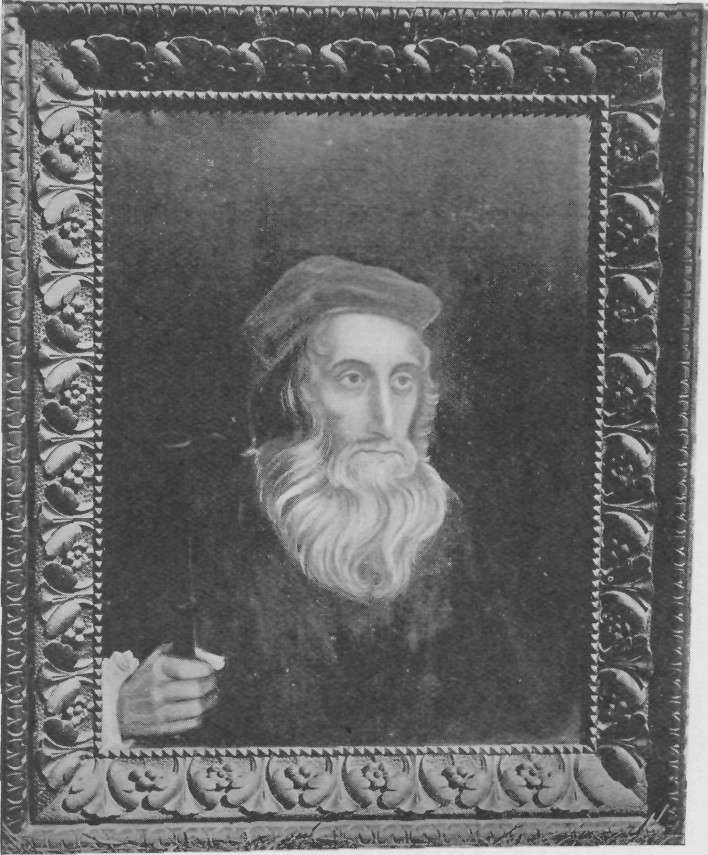
JOHN WICLIF.
From the portrait in Lutterworth Church
It was not a very pleasant picture to look upon, so we adjourned to the vestry, where we were shown a vestment worn by Wiclif in which some holes had been cut either with knives or scissors. On inquiry we were informed that the pieces cut out had been “taken away by visitors,” which made us wonder why the vestment had not been taken better care of. We were shown an old pulpit, and the chair in which Wiclif fell when he was attacked by paralysis, and in which he was carried out of church to die three days afterwards. We could not describe his life and work better than by the inscription on the mural monument subscribed for in 1837:
Sacred to the Memory of John Wiclif the earliest Champion of Ecclesiastical Reformation in England. He was born in Yorkshire in the year 1324, and in the year 1375 he was presented to the Rectory of Lutterworth. At Oxford he acquired not only the renown of a consummate Schoolman, but the far more glorious title of the Evangelical Doctor. His whole life was one perpetual struggle against the corruptions and encroachments of the Papal Court and the impostures of its devoted auxiliaries, the Mendicant Fraternities. His labours in the cause of Scriptural truths were crowned by one immortal achievement, his Translation of the Bible into the English tongue. This mighty work drew on him, indeed, the bitter hatred of all who were making merchandise of the popular credulity and ignorance, but he found abundant reward in the blessing of his countrymen of every rank and age, to whom he unfolded the words of Eternal Light. His mortal remains were interred near this spot, but they were not allowed to rest in peace. After a lapse of many years his bones were dragged from the grave and consigned to the flames; and his ashes were cast in the waters of the adjoining stream.
That he was a man of distinction may be taken for granted, as he was master of that famous college at Oxford, Balliol College, where his picture hangs in the dining-hall to-day.
When in Lichfield Cathedral, where we saw Chantrey’s monument of Bishop Ryder, we had omitted to ask for particulars about him, but here we were told that he was appointed Rector of Lutterworth in 1801, and had been a benefactor to the town. He was made Canon of Windsor in 1808, Dean of Wells 1812, Bishop of Gloucester 1815, and finally became Bishop of Lichfield and Coventry. He died at Hastings in 1836, and as Chantrey himself died in 1841, his monument of Bishop Ryder, that had impressed us so deeply, must have been one of his latest and best productions.
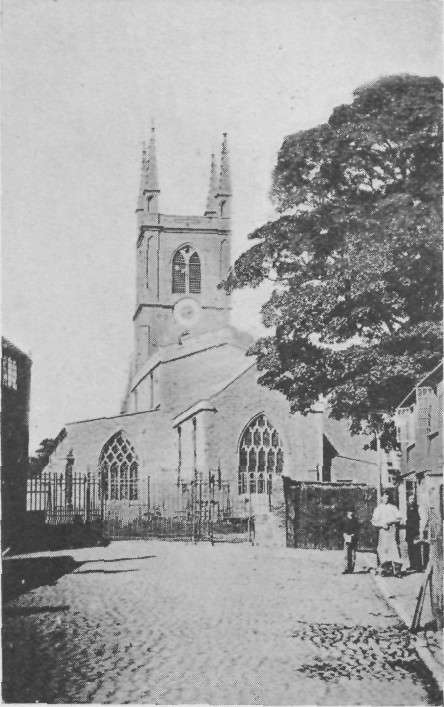
Lutterworth was the property of William the Conqueror in 1086, and it was King Edward III who presented the living to Wiclif, who was not only persecuted by the Pope, but also by the Archbishop of Canterbury and the Bishop of London. On two occasions he had to appear before the Papal Commission, and if he had not been the personal friend of John o’ Gaunt, Duke of Lancaster, the fourth son of the King Edward who had given him the living, and probably the most powerful man in England next to the king, he would inevitably have suffered martyrdom. He was equally fortunate in the following reign, as John o’ Gaunt was uncle to Richard II, the reigning monarch, under whose protection he was spared to finish his great work and to translate the Holy Bible so that it could be read in the English language.
We went to see the bridge which crossed the small stream known as the River Swift, for it was there that Wiclif’s bones were burned and the ashes thrown into the stream. The historian related that they did not remain there, for the waters of the Swift conveyed them to the River Avon, the River Avon to the River Severn, the Severn to the narrow seas, and thence into the wide ocean, thus becoming emblematic of Wiclif’s doctrines, which in later years spread over the wide, wide world.
A well-known writer once humorously observed that the existence of a gallows in any country was one of the signs of civilisation, but although we did not see or hear of any gallows at Lutterworth, there were other articles, named in the old books of the constables, which might have had an equally civilising influence, especially if they had been used as extensively as the stocks and whipping-post as recorded in a list of vagrants who had been taken up and whipped by Constables Cattell and Pope, from October 15th, 1657, to September 30th, 1658. The records of the amounts paid for repairs to the various instruments of torture, which included a lock-up cage for prisoners and a cuck, or ducking-stool, in which the constables ducked scolding wives and other women in a deep hole near the river bridge, led us to conclude that they must have been extensively used.
A curious custom prevailed in Lutterworth in olden times. There were two mills on the River Swift, and the people were compelled to grind all their malt at one mill and all their corn at another, and to bake all their bread in one oven; in those “days of bondage” a person durst not buy a pound of flour from any other miller. These privileges were abused by the millers to make high charges, and it was on record that a person who ventured to bake a cake in his own oven was summoned, but discharged on his begging pardon and paying expenses. This unsatisfactory state of things continued until the year 1758, when a rebellion arose headed by a local patriot named Bickley. This townsman roused his fellow-citizens to resist, and built a malthouse of his own, his example being soon followed by others, who defied the owner of the privileged mill, and entered into a solemn bond to defend any action that might be brought against them. The contest was one of the most interesting and remarkable ever known in the district, and was decided at the Leicester Assizes in July 1758, the verdict being in favour of the parishioners, with costs to the amount of £300. One of the greatest curiosities to be seen in Lutterworth was an old clock which was there in 1798, and still remained in good working order; the description of it reads as follows:
The case is of mahogany; and the face is oval, being nineteen inches by fifteen inches. The upper part exhibits a band of music, consisting of two violins, a violoncello, a German flute, three vocal performers, and a boy and girl; the lower part has the hour and minutes indicated by neat gilt hands; above the centre is a moment hand, which shows the true dead beat. On the right is a hand pointing to—chimes silent—all dormant—quarters silent—all active; to signify that the clock will perform as those words imply. On the left is a hand that points to the days of the week, and goes round in the course of seven days, and shifts the barrel to a fresh time at noon and midnight. The clock strikes the hour, the four quarters, and plays a tune three times over every three hours, either on the bells alone, the lyricord, or on both together. Three figures beat exact time to the music, and three seem to play on their instruments; and the boy and the girl both dance through the whole if permitted. But still, by a touch all are dormant, and by another touch all are in action again. The lyricord will play either low or loud. The machine goes eight days, either as a watch clock, quarter clock, quarter-chime-clock or as a quarter chime lyrical clock. It will go with any or all parts in action, or with any or all parts dormant. It has four chime barrels, and plays sixty-five tunes, many of them in two or three parts, on nineteen musical bells, and on the like number of double musical wires. A child may do everything necessary to show its varied and complicated action.
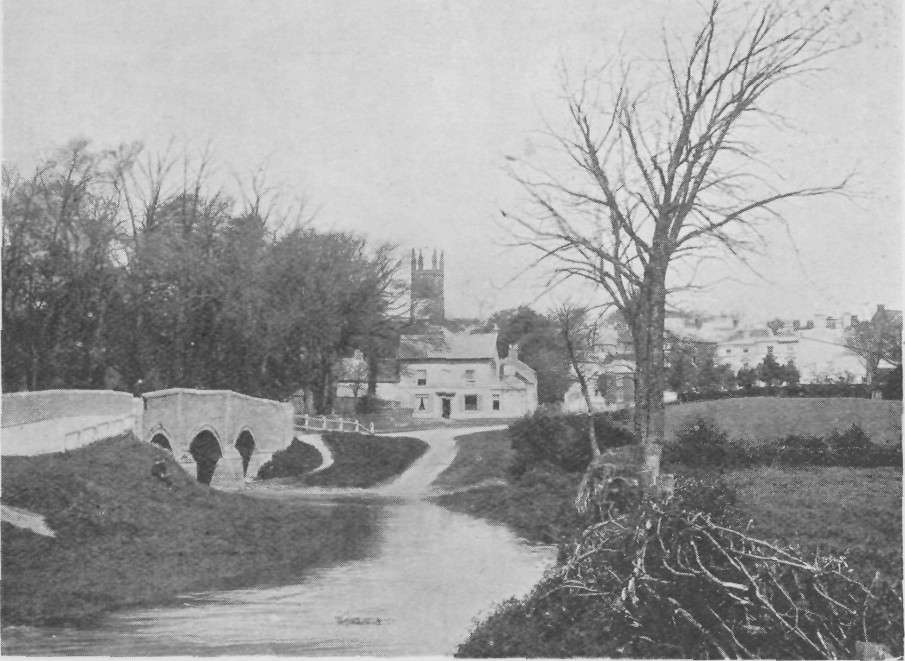
LUTTERWORTH AND THE RIVER SWIFT, WHERE THE ASHES OF WICLIF WERE SCATTERED.
The maker was Mr. Deacon, a Baptist minister of Barton-in-the-Beans, who began life as a farm boy when he was eleven years of age. A gentleman happened to call on the farmer one evening and had some nuts given to him, and as he could not crack them, one of the other servants said to the boy, “Sam, bring the wooden nut-crackers you made!” When the boy brought them, the visitor, after cracking a nut, examined them carefully for some time, and was so struck with the ingenuity displayed in their construction that he took the lad and apprenticed him to a clock-maker in Leicester, where he became one of the cleverest workmen in the kingdom, the most elaborate and curious piece of mechanism he made being this wonderful clock.
We returned from Lutterworth by a different route, for we were now off to see Peeping Tom at Coventry; but our experiments on the roads were not altogether satisfactory, for we got lost in some by-roads where there was no one to inquire from, and eventually reached the snug little village of Monks Kirby. Here, according to the name of the village, we should at one time have found a Danish settlement, and at another a church belonging to the monks; but on this occasion we found a church and a comfortable-looking inn opposite to it, where we called for an early tea. This was quickly served and disposed of, and shortly afterwards we reached, coming from the direction of the High Cross, the Fosse, or Foss-way, one of the four great roads made by the Romans in England, so named by them because there was a fosse, or ditch, on each side of it. We walked along its narrow and straight surface until we came to a road which crossed it, and here, about halfway between Rugby and Coventry, we turned to the right, leaving the “fosse” to continue its course across Dunsmore Heath, where in ancient times Guy, the famous Earl of Warwick, slew the terrible Dun Cow of Dunsmore, “a monstrous wyld and cruell beast.” The village of Brinklow was now before us, presenting a strange appearance as we walked towards it from the brook below, for at the entrance stood a lofty mound formerly a Roman camp, while behind it was a British tumulus. In the Civil War there was much fighting all along the road from here to Coventry, and Cromwell’s soldiers had not left us much to look at in the church, as the windows had all been “blown out” at that time, leaving only some small pieces of stained glass. The church, however, was quite a curiosity, for it sloped with the hill, and was many feet lower at the Tower end than at the east. We walked along a rather steep inclined plane until we came to a flight of four steps which landed us on the chancel floor, where another inclined plane brought us up to the foot of the two steps leading to the altar; we were told that there was only one other church built in such a form “in all England.” We were now well within the borders of the county of Warwickshire, which, with the other two Midland Counties of Worcestershire and Staffordshire, formerly contained more leading Roman Catholic families than any other part of England, so we were not surprised when we heard that we were passing through a country that had been associated with the Gunpowder Plot, and that one incident connected with it had occurred at Combe Abbey, which we would pass a mile or two farther on our way. The originator of the Gunpowder Plot, Catesby, was intimately connected with many of the leading families in these counties, and was lineally descended from the Catesby of King Richard III’s time, whose fame had been handed down in the old rhyme:
The Rat, the Cat, and Lovel the Dog
Rule all England under the Hog.
the rat meaning Ratcliffe, the cat Catesby, and the hog King Richard, whose cognisance was a boar. Robert Catesby, the descendant of the “cat,” was said to be one of the greatest bigots that ever lived; he was the friend of Garnet, the Jesuit, and had been concerned in many plots against Queen Elizabeth; when that queen died and King James, the son of Mary Queen of Scots, ascended the throne, their expectations rose high, for his mother had suffered so much from Queen Elizabeth that they looked upon her as a martyr, and were sure that their form of religion would now be restored. But great was their chagrin when they found that James, probably owing to his early education under John Knox in Scotland, was more ready to put the laws in force against the Papists than to give them greater toleration.

THE OLD MANOR HOUSE, ASHBY ST. LEDGERS.
Catesby and his friends resolved to try to depose James and to place the Princess Elizabeth, daughter of James I, afterwards the beautiful Queen of Bohemia, whom her royal parents had placed under the care of the Earl of Harrington, then the owner of Combe Abbey, about five miles from Coventry, on the throne in his stead. The conspirators assembled at Dunchurch, near Rugby, but held their meetings about six miles away, in a room over the entrance to the old Manor House at Ashby St. Ledgers, the home of Catesby, where it was proposed to settle matters by blowing up the Houses of Parliament. These were to be opened on November 5th, 1605, when the King, Queen, and Prince of Wales, with the Lords and Commons, would all be assembled. In those days the vaults, or cellars, of the Parliament House were let to different merchants for the storage of goods, and one of these immediately under the House of Lords was engaged and filled with some innocent-looking barrels, in reality containing gunpowder, which were covered by faggots of brushwood. All preparations were now completed except to appoint one of their number to apply the torch, an operation which would probably involve certain death. In the meantime Catesby had become acquainted with Guy Fawkes, a member of an old Yorkshire family, and almost as bigoted a Papist as himself, who had joined the conspirators at Dunchurch, the house where he lodged being still known as Guy Fawkes’ House, and when the question came up for decision, he at once volunteered his services, as he was a soldier and a brave man. They were accepted, and Sir Everard Digby was to stay at Dunchurch in order to be ready to seize the young Princess Elizabeth while the others went to London. It so happened that one of the conspirators had a friend, Lord Monteagle, whom he knew would be sure to attend the opening of Parliament, and as he did not want him to be killed he caused an anonymous letter to be written warning him not to attend the opening of Parliament, “for though there be no appearance of any stir, yet I say they shall receive a terrible blow this Parliament, and yet shall not see who hurts them.” The letter was delivered to Monteagle by a man in a long coat, who laid it on his table and disappeared immediately. It was afterwards handed to King James, who, after reading the last paragraph, repeated it aloud, “and yet they shall not see who hurts them,” and said to Cecil, “This smells gunpowder!” Their suspicions were aroused, but they waited until midnight on November 4th, and then sent soldiers well armed to search the vaults, where they found a man with a long sword amongst the barrels. He fought savagely, but was soon overpowered. When the conspirators found that their plot had been discovered, and that Guy Fawkes was in custody, instead of escaping to France as they might easily have done, they hastened down to Dunchurch, “as if struck by infatuation,” in the wild hope of capturing the young Princess and raising a civil war in her name; but by the time they reached Combe Abbey, the Earl of Harrington had removed Elizabeth to Coventry, which at that time was one of the most strongly fortified places in England. They now realised that their game was up, and the gang dispersed to hide themselves; but when the dreadful nature of the plot became known, it created such a profound sensation of horror throughout the country, that every one joined in the search for the conspirators, who in the end were all captured and executed. Great rejoicings were held, bonfires lit, bells rung, and guns fired in almost every village, and thereby the people were taught to—
Remember, remember, the Fifth of November
The Gunpowder, Treason, and Plot.
These celebrations have been continued on each fifth of November for centuries, November 5th becoming known as “Bonfire Day.” And in our Book of Common Prayer there was a special service for the day which was only removed in the time of Queen Victoria. Guy Fawkes was executed on February 6th, 1606.
Fortunately for the Protestants the reign of the queen who was known by them as the “Bloody Queen Mary” was of short duration, for they were then subjected to very great cruelties; on the other hand there was no doubt that during the much longer reign of Queen Elizabeth that followed, the Papists also suffered greatly; still under James they were now bound to suffer more in every way, short of death, for the great mass of their fellow-countrymen had turned against them owing to the murderous character of the Gunpowder Plot, so—
On Bonfire Day, as Britons should,
They heaped up sticks, and turf, and wood;
And lighted Bonfires bright and hot,
In memory of the Popish Plot!
We were ourselves greatly interested in November 5th, which was now due to arrive in three days’ time; not because some of our ancestors had been adherents to the Roman Catholic Faith, nor because of the massacres, for in that respect we thought one side was quite as bad as the other; but because it happened to be my birthday, and some of our earliest and happiest associations were connected with that day. I could remember the time when a candle was placed in every available window-pane at home on November 5th, and when I saw the glare of the big bonfire outside and the pin-wheels, the rip-raps, and small fireworks, and heard the church bells ringing merrily, and the sound of the guns firing, I naturally thought as a child that all these tokens of rejoicing were there because it was my birthday. Then the children from the village came! first one small group and then another; these were the “Soulers,” or “Soul-Cakers,” who ought to have appeared, according to history, on All Souls’ Day; they were generally satisfied with apples or pears, or with coppers. The most mysterious visitor was the horse’s head, or hobby horse, which came without its body or legs, but could make a noise just like the neighing of a horse, and could also open its mouth so wide that a glass filled with beer could pass down its throat. To complete the illusion we could hear its jaws, which were filled with very large teeth, close together with a crack, and although the glass was returned in some way or other, we never saw the beer again. The horse’s head was accompanied by a lot of men known as Mummers, dressed in all sorts of queer clothes, who acted a short play, but the only words I could remember were, “King George, King George, thou hast killed my only son!” and at that point one of the actors fell on the grass as if he were dead. But these were reveries of the past; when the spell broke I found myself walking with my brother in the dark alongside the grounds of Combe Abbey, the only lights we could see being some in the park, which might have been those from the abbey itself. We were expecting to come upon a private menagerie which was supposed to exist somewhere in the park, and we had prepared ourselves for the roars of the lions seeking their prey as they heard our footsteps on the road, or for the horrid groans of other wild animals; but beyond a few minor noises, which we could not recognise, all was quiet, and passing the small village of Binley we soon arrived at Coventry, where we stayed for the night at an ancient hostelry near the centre of the town.
St. George, the Patron Saint of England, who lived in the early part of the fourth century, and was reckoned among the seven champions of Christendom, was said to have been born in Coventry. In olden times a chapel, named after him, existed here, in which King Edward IV, when he kept St. George’s Feast on St. George’s Day, April 23rd, 1474, attended service. Coventry was a much older town than we expected to find it, and, like Lichfield, it was known as the city of the three spires; but here they were on three different churches. We had many arguments on our journey, both between ourselves and with others, as to why churches should have towers in some places and spires in others. One gentleman who had travelled extensively through Britain observed that towers were more numerous along the sea coasts and on the borders of Wales and Scotland, while spires were most in evidence in the low Midland plains where trees abounded. In these districts it was important to have part of the church standing out from the foliage, while on a hill or a bare cliff a short tower was all that was needed. He actually knew more than one case where the squires in recent times had a short spire placed on the top of the church tower, like the extinguisher of an old candlestick, because it was said they needed guide-posts by which to find their way home from hunting!

ST. MICHAEL’S CHURCH SPIRE, COVENTRY.
In olden times, ere the enemy could approach the village, the cattle were able to be driven in the church, while the men kept an easy look-out from the tower, and the loopholes in it served as places where arrows could be shot from safe cover. In some districts we passed through we could easily distinguish the position of the villages by the spires rising above the foliage, and very pretty they appeared, and at times a rivalry seemed to have existed which should possess the loftiest or most highly decorated spire, some of them being of exceptional beauty. The parish churches were almost invariably placed on the highest point in the villages, so that before there were any proper roads the parishioners could find their way to church so long as they could see the tower or spire, and to that position at the present day, it is interesting to note, all roads still converge.
We had no idea that the story of Lady Godiva and Peeping Tom was so ancient, but we found it dated back to the time of Leofric, Earl of Mercia, who in 1043 founded an abbey here which was endowed by his wife, the Lady Godiva. The earl, the owner of Coventry, levied very hard taxes on the inhabitants, and treated their petitions for relief with scorn. Lady Godiva, on the contrary, had moved amongst the people, and knew the great privations they had suffered through having to pay these heavy taxes, and had often pleaded with her husband on their behalf. At last he promised her that he would repeal the taxes if she would ride naked through the town, probably thinking his wife would not undertake such a task. But she had seen so much suffering amongst the poor people that she decided to go through the ordeal for their sakes, and the day was fixed, when she would ride through the town. Orders were given by the people that everybody should darken their windows and retire to the back part of their houses until Lady Godiva had passed. All obeyed except one man, “Tom the Tailor,” afterwards nicknamed “Peeping Tom,” who, as the lady rode by on her palfrey, enveloped in her long tresses of hair, which fell round her as a garment, looked down on her from his window, and of him the historian related that “his eyes chopped out of his head even as he looked.” The ride ended, the taxes were repealed, and ever afterwards the good Lady Godiva was enshrined in the hearts of the people of Coventry. Many years later a beautiful stained-glass window was placed in the Parish Church to commemorate this famous event, and Leofric was portrayed thereon as presenting Godiva with a charter bearing the words:
I Luriche for love of thee
Doe make Coventry toll free.
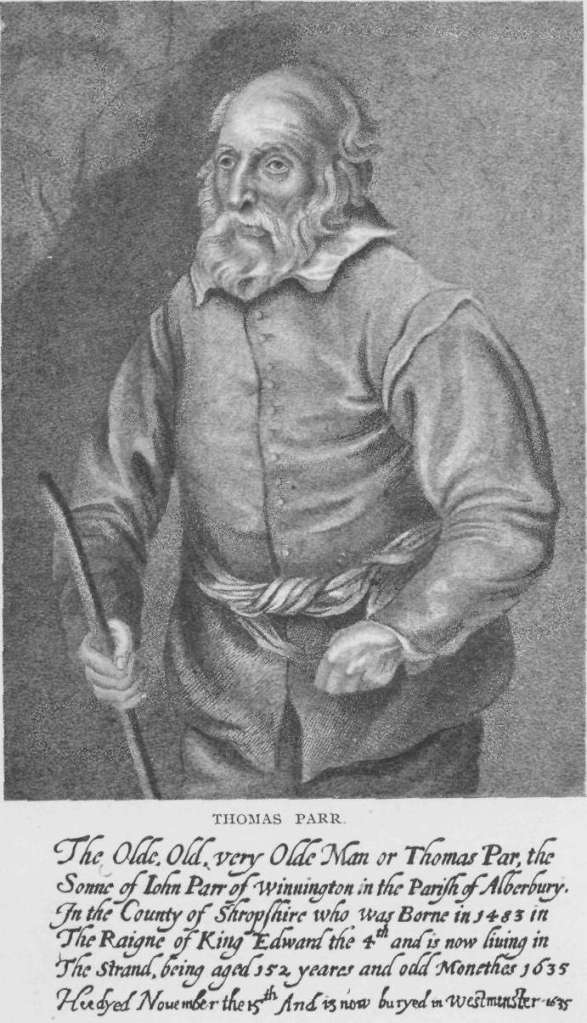
This story Tennyson has immortalised, and its memory is still perpetuated in the pageants which are held from time to time in the city. Coventry was described in 1642 by Jeremiah Wharton, an officer under the Earl of Essex in the Parliamentary Army, as “a City environed with a wall, co-equal with, if not exceeding, that of London, for breadth and height, and with gates and battlements, and magnificent churches and stately streets, and abundant fountains of water, altogether a place very sweetly situated, and where there was no lack of venison.” The walls of Coventry, begun in the year 1355, were very formidable, being six yards high and three yards thick, and having thirty-two towers and twelve principal gates. They defied both Edward IV and Charles I when with their armies they appeared before them and demanded admission, but they were demolished after the Civil War by order of Charles II, because the people of Coventry had refused admission to his father, King Charles I. Coventry possessed a greater number of archives than almost any other town in England, covering eight centuries and numbering over eleven thousand. My brother was delighted to find that one of them related to a very old man named Thomas Parr, recording the fact that he passed through the town on his way to London in 1635, at the age of 152 years. It reminded him of a family medicine known as Old Parr’s Pills, which at one time was highly prized; they had been used by our grandfather, who died in his ninety-seventh year, and he often wondered whether his longevity was in any way due to those pills. They were supposed to have been made from the same kind of herbs as old Parr was known to have used in his efforts to keep himself alive, and during supper my brother talked about nothing else but that old man; if he was an authority on anything, it was certainly on old Thomas Parr. This man was born on the Montgomery border of Shropshire, where a tablet to his memory in Great Wollaston Church bore the following inscription:
The old, old, very old man
THOMAS PARR
was born at Wynn in the Township of Winnington
within the Chapelry of Great Wollaston, and Parish of
Alberbury, in the County of Salop, in the year of our
Lord 1483. He lived in the reigns of 10 Kings and
Queens of England, King Edward IV. and V. Richard III.
Henry VII. VIII. Edward VI. Queen Mary, Queen Elizabeth.
King James I. King Charles I.
He died the thirteenth and was buried at
Westminster Abbey on the fifteenth November 1635
Age 152 years and 9 months.
John Taylor, known as the Water Poet because he was a Thames waterman, who was born in 1580, and died in 1656, was a contemporary of Parr, and wrote a book in 1635, the same year that old Parr died, entitled The Olde, Olde, very Olde Man, in which he described Thomas Parr as an early riser, sober, and industrious:
Though old age his face with wrinkles fill.
He hath been handsome and is comely still;
Well-faced, and though his Beard not oft corrected
Yet neate it grows, not like a Beard neglected.
Earl Arundel told King Charles I about this very old man, and he expressed a desire to see him; so the earl arranged to have him carried to London. When the men reached old Parr’s cottage, which is still standing, they found an old man sitting under a tree, apparently quite done. Feeling sure that he was the man they wanted, they roused him up, and one said, “We have come for you to take you to the King!” The old man looked up at the person who spoke to him, and replied, “Hey, mon! it’s not me ye want! it’s me feyther!” “Your father!” they said, in astonishment; “where is he?” “Oh, he’s cuttin’ th’ hedges!” So they went as directed, and found a still older man cutting away at a hedge in the small field adjoining the cottage, and him they took, together with his daughter, for whom the earl had provided a horse. Musicians also went with him, and it was supposed that he was exhibited at the different towns they called at on their way to London, and such was the crush to see him in Coventry that the old man narrowly escaped being killed. When he was taken into the presence of King Charles, the king said, “Well, Parr, you’ve lived a long time,” and Parr answered, “Yes I have, your Majesty.” “What do you consider the principal event in your long life?” asked the king, to which Parr replied that he hardly knew, but mentioned some offence which he had committed when he was a hundred years old, and for which he had to do penance in Alberbury Church, with the young woman sitting beside him barefooted, and dressed in white clothing! Whereupon King Charles said, “Oh, fie, fie, Parr, telling us of your faults and not your virtues!”

Parr was fêted in London to such an extent that he died of surfeit, and was buried in the Poets’ Corner in Westminster Abbey, where his tombstone still exists, and is inscribed:
Thomas Parr of Y’E County of
Sallop Borne in A’P 1483. He lived
in Y’E Reignes of Ten Princes VIZ:—
K. Edw. 4. K. Edw. 5. K. Rich. 3.
K. Hen. 7. K. Hen. 8. K. Edw. 6.
Q. Ma. Q. Eliz. K. Ja. & K. Charles
Aged 152 Years
& was buried Here
Novemb. 15. 1635.
His portrait was painted by Van Dyck, who at that time was the Court painter of King Charles I, and there were other oil paintings of him in various places in England and abroad.
(Distance walked thirty-one miles.)
Friday, November 3rd.
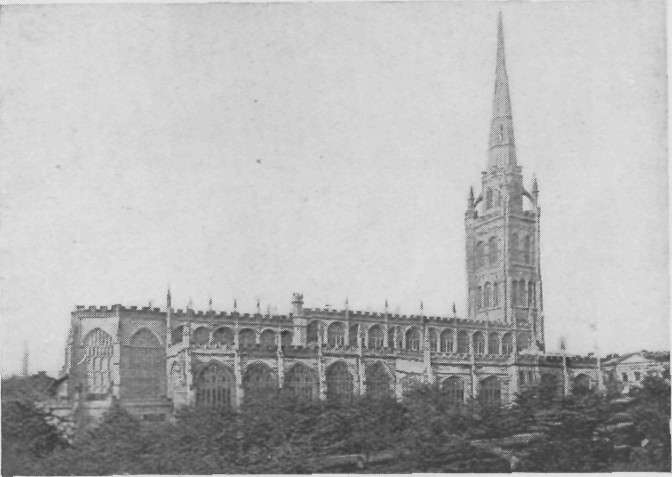
ST. MICHAEL’S CHURCH, COVENTRY.
Our hotel was quite near the Coventry Parish Church dedicated to St. Michael, which was said to be the largest parish church in England, so we went out early this morning to visit it. We found it to be a very fine church, and in it we saw some workmen erecting a beautiful stained-glass window in which they had already placed the likeness of two saints, one of whom was St. Ambrose. We wondered why they should be putting such images in what we supposed to be the Reformed Church of England. The men told us we should find a very fine stained-glass window across the way in St. Mary’s Hall, which had been erected in the time of Henry VI, and was originally the work of John Thornton of Coventry, who also had charge of the erection of the famous east window we had already seen in York Minster. We only saw the exterior of the windows in St. Mary’s Hall, as we could not find any door that was open, so we hurried away to form the acquaintance of “Peeping Tom,” whose image we had come so many miles to see. We found him high up on a corner of a street as if looking down on the passers-by below. The building in which he appeared was doing duty as a public-house, so we went in and saw the landlord, to whom we explained the nature of our visit and journey, and he kindly conducted us up the steps to the small room at the top of the house where Peeping Tom was to be seen. He was a repulsive-looking image of humanity, made of wood, without arms, and with a hideous face; how long he had occupied his present position no one knew, but as we had seen images of wood made hundreds of years ago, we were willing to suppose that he was a relic of antiquity. Photography at the time of our visit was only in its infancy, but small cards, 4 inches long by 2-1/2 inches wide, with photographic views on them, were beginning to make their appearance—picture postcards being then unknown. On our tour we collected a number of these small cards, which were only to be found in the more populous places. In our case we were able to get one at Coventry of Peeping Tom, a facsimile of which we here produce. We did not stay long in his company, for we looked upon him as an ugly and disreputable character, but hurried back to our hotel for a good breakfast before starting on our walk to the country of Shakespeare.
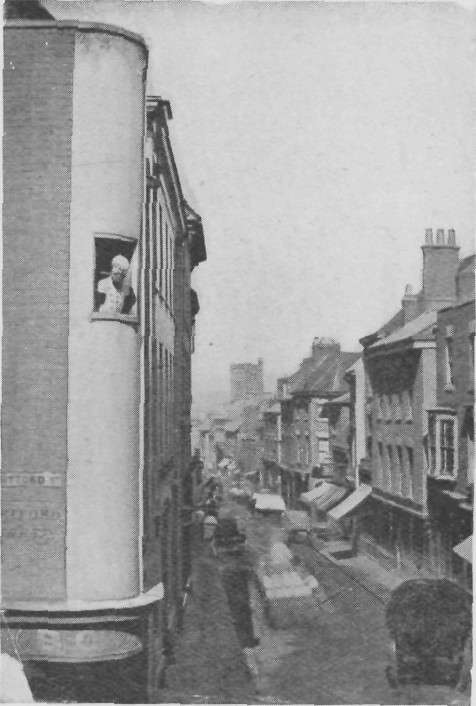
The dull days of November were now upon us, which might account to some extent for the sleepy appearance of the old town of Coventry; but it appeared that underlying all this was a feeling of great depression caused by the declining state of its two staple industries—watches and silk. The manufacture of watches had been established here for many years, for as early as 1727 the archives recorded that a watch-maker had been appointed Mayor of Coventry, and for anything we knew the manufacture of silk might have been quite as old an industry there; but the competition of American and Swiss watches was making itself seriously felt, and the Treaty with France which admitted French silks into England, duty free, was still more disastrous, causing much apprehension for the future prosperity of the “good old town.”
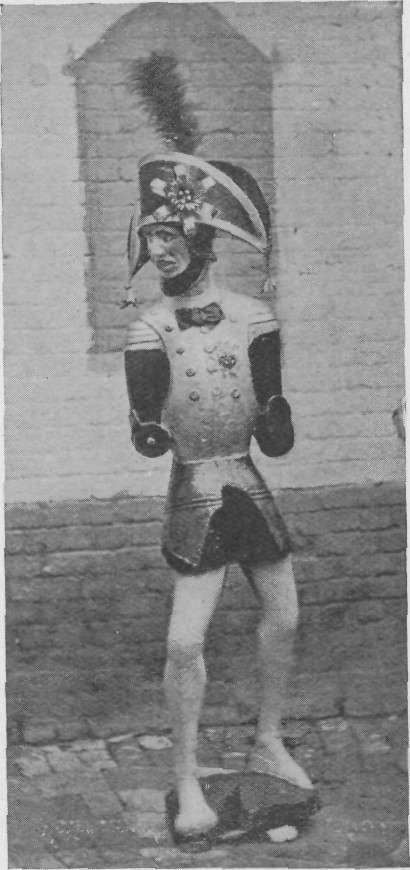
We lost a little time before starting, as my brother had seen something in a shop window that he wanted to buy, but having forgotten the exact position of the shop, we had to search diligently until we found it. It was quite an artistic bookmarker made of white silk, with ornamental bordering in colours which blended sweetly, enclosing a scroll, or unfolding banner, which only displayed one word at each fold:
The Lord is my Shepherd; I shall not want.
I never knew what became of that book-mark until years later, after he was married, when I saw it in his family Bible, and then I could guess where it had been in the interval. I noticed also that he began to quicken his speed considerably, and to be inclined to walk farther each day, his explanation being that we were obliged to make up for lost time. I also noticed that he wrote more notes in his diary in shorthand, his knowledge of which I envied. He said that before he started on the journey he imagined he knew the history of England, but had now become convinced that he had it all to learn, and he thought the best way to learn it thoroughly was by walking from John o’ Groat’s to Land’s End.

KENILWORTH CASTLE FROM THE BRIDGE.
A story was once told of two commercial travellers who had travelled extensively, and were asked to write down the prettiest road in all England, and one of them wrote “from Kenilworth to Coventry” and the other wrote “from Coventry to Kenilworth”! This was the road on which we had now to walk to reach what was known as “Shakespeare’s country.” There were many pretty roads in England, and although this road was very fine, being wide and straight and passing through a richly wooded country, we had seen many prettier roads as regarded scenery. We soon arrived at the historical Castle of Kenilworth, which, judging from the extent of its ruins and lofty towers, must at one time have been a magnificent place. According to local history the castle was originally built in the reign of Henry I, and at one time it was in the possession of Simon de Montfort, Earl of Leicester, who was born in 1206, and who has been described as the “Father of English Parliaments.” Henry belonged to the Plantagenet family, the reigning house from Henry II in 1154 to Richard III, who was killed at the Battle of Bosworth Field in 1485. The strangest history in that family appeared to be that of Eleanor Plantagenet, the daughter of Henry II, who caused her to be married when only four years old to the great Earl of Pembroke, who was then forty, and who took her as a bride to his home when she was only fourteen years old, leaving her a widow at sixteen. She was thrown into such an agony of grief that she took a solemn vow in the presence of the Archbishop of Canterbury never to marry again, but to become a bride of Christ. Seven years afterwards, however, she returned to the Court of her brother, who was then Henry III, and, meeting Simon de Montfort, Earl of Leicester, the king’s favourite, one of the most handsome and accomplished of courtiers, to whom he had given Kenilworth Castle, the widowed countess forgot her vow, and though solemnly warned by the Archbishop of the peril of breaking her oath, Montfort easily persuaded Henry to give him his sister in marriage. The king knew that both the Church and the barons would be violently opposed to the match, and that they could only be married secretly; so on one cold January morning in 1238 they were married in the king’s private chapel at Windsor; but the secret soon became known to the priests and the peers, and almost provoked a civil war. The Princess Eleanor was not happy, as her husband, who had lost the favour of her brother the king, was ultimately killed in the cause of freedom, along with her eldest son, at the Battle of Evesham. He was the first to create a Parliament.
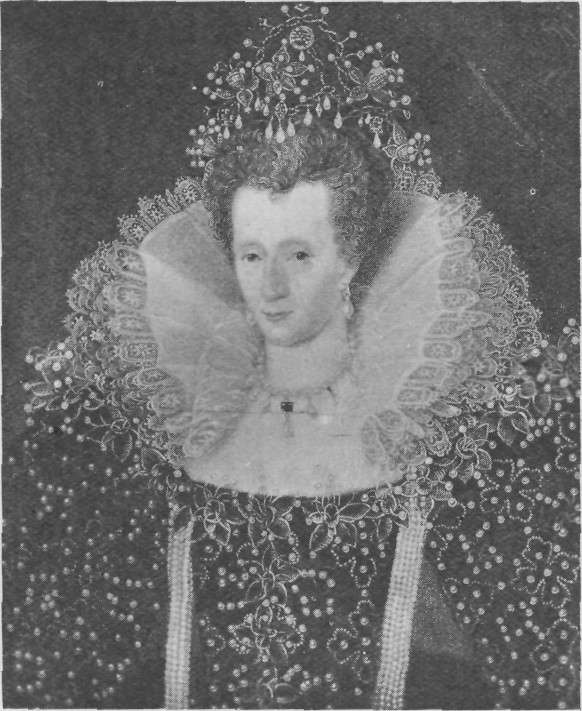
In the year 1206 a festival was held at Kenilworth, attended by one hundred knights of distinction, and the same number of ladies, at which silks were worn for the first time in England, and in 1327 Edward II was there compelled to sign his abdication in favour of his son. Kenilworth Castle probably attained the zenith of its prosperity in the time of Queen Elizabeth, who in 1563 conferred it upon her favourite, Robert Dudley, Earl of Leicester, who entertained her there with great magnificence on four different occasions, 1566, 1568, 1572, and 1575. But the former glory of Kenilworth Castle had departed, and we only saw it in the deplorable condition in which it had been left by Cromwell’s soldiers. They had dismantled the lofty towers, drained the lake, destroyed the park, and divided the land into farms, and we looked upon the ruins of the towers, staircases, doorways, and dungeons with a feeling of sorrow and dismay. We could distinguish the great hall, with its chimney-pieces built in the walls; but even this was without either floor or roof, and the rest appeared to us as an unintelligible mass of decaying stonework. And yet, about half a century before we made our appearance at the ruins, a visitor arrived who could see through them almost at a glance, and restored them in imagination to their former magnificence, as they appeared in the time of Queen Elizabeth. He has described the preparations for the great feast given in her honour in 1575 by the Earl of Leicester, and resuscitated the chief actors in that memorable and magnificent scene. He was described as “a tall gentleman who leaned rather heavily on his walking-stick,” and although little notice was taken of him at the time, was none other than the great Sir Walter Scott, whose novel Kenilworth attracted to the neighbourhood crowds of visitors who might never have heard of it otherwise.
We had begun to look upon Sir Walter in the light of an old acquaintance, once formed never to be forgotten, and admired his description of Kenilworth Castle:
The outer wall of this splendid and gigantic structure inclosed seven acres, a part of which was occupied by extensive stables, and by a pleasure garden, with its trim arbours and parterres, and the rest formed a large base-court, or outer yard, of the noble Castle. The Lordly structure itself, which rose near the centre of this spacious enclosure was composed of a huge pile of magnificent castellated buildings, apparently of different ages, surrounding an inner court, and bearing in the names of each portion attached to the magnificent mass, and in the armorial bearings which were there blazoned, the emblems of mighty chiefs who had long passed away, and whose history, could Ambition have lent ear to it, might have read a lesson to the haughty favourite who had now acquired and was augmenting the fair domain. A large and massive Keep, which formed the Citadel of the Castle, was of uncertain, though great antiquity. It bore the name of Cæsar, perhaps from its resemblance to that in the Tower of London so called. The external wall of this Royal Castle was on the south and west sides adorned and defended by a Lake, partly artificial, across which Leicester had constructed a stately bridge, that Elizabeth might enter the Castle by a path hitherto untrodden. Beyond the Lake lay an extensive Chase, full of red deer, fallow deer, roes, and every species of game, and abounding with lofty trees, from amongst which the extended front and massive towers of the Castle were seen to rise in majesty and beauty.
The great feast provided by the Earl of Leicester in honour of the visit of Queen Elizabeth to Kenilworth Castle in 1575 was of a degree of magnificence rarely equalled either before or since, extending continuously over the seventeen days of the queen’s stay, beginning at two o’clock, at which time the great clock at the castle was stopped and stood at that hour until the Princess departed. The cost of these ceremonies was enormous, the quantity of beer alone consumed being recorded as 320 hogsheads.
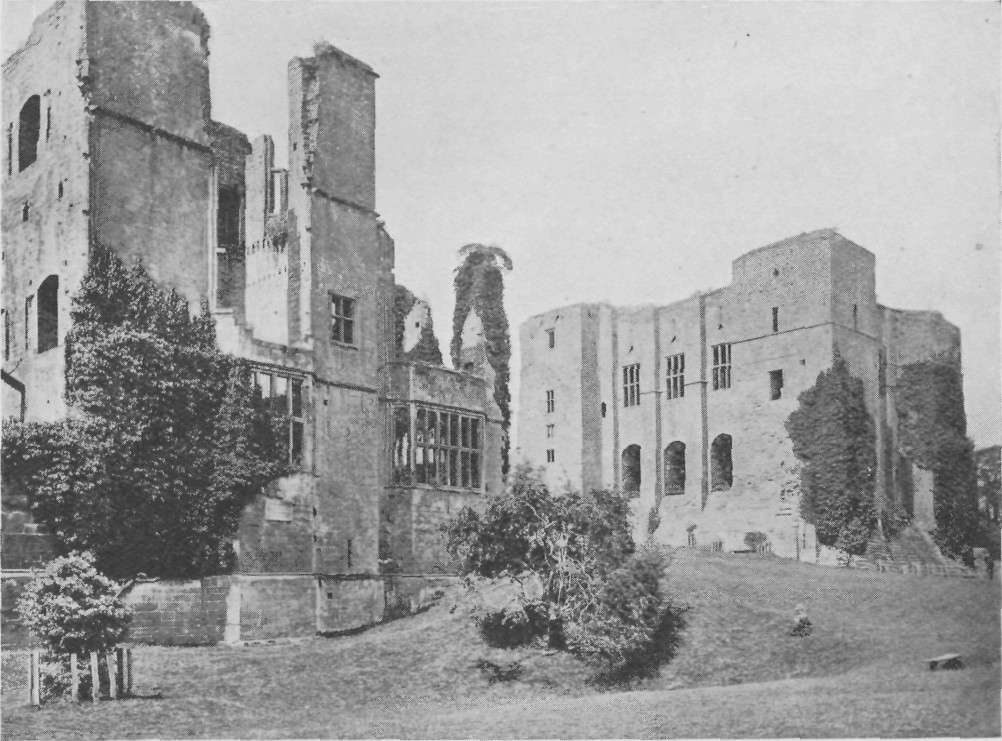
KENILWORTH CASTLE, LEICESTER BUILDINGS AND CÆSAR’S TOWER.
Sir Walter describes the preparations for the feast and the heterogeneous nature of the crowd of people who attended it. The resources of the country for miles round were taxed to their utmost, for not only the queen’s purveyors, but the Earl of Leicester’s household officers had been scouring it in all directions to provide the necessary viands and provisions. The services in this respect of all the leading families had been requisitioned, and—
They took this opportunity of ingratiating themselves by sending large quantities of provisions and delicacies of all kinds, with game in huge quantities, and whole tuns of the best liquors, foreign and domestic. Thus the high-roads were filled with droves of bullocks, sheep, calves and hogs, and choked with loaded wains, whose axle-trees creaked under their burdens of wine-casks and hogsheads of ale, and huge hampers of grocery goods, and slaughtered game, and salted provisions, and sacks of flour. Perpetual stoppages took place as these wains became entangled; and their rude drivers, swearing and brawling till their wild passions were fully raised, began to debate precedence with their wagon-whips and quarter-staves, which occasional riots were usually quieted by a purveyor, deputy-marshal’s man, or some other person in authority breaking the heads of both parties. Here were, besides, players and mummers, jugglers and showmen, of every description, traversing in joyous bands the paths which led to the Palace of Princely Pleasure; for so the travelling minstrels had termed Kenilworth in the songs which already had come forth in anticipation of the revels, which were there expected. In the midst of this motley show, mendicants were exhibiting their real or pretended miseries, forming a strange though common contrast betwixt the vanities and the sorrows of human existence. All these floated along with the immense tide of population, whom mere curiosity had drawn together; and where the mechanic, in his leathern apron, elbowed the dink and dainty dame, his city mistress; where clowns with hobnailed shoes were treading on the kibes of substantial burghers and gentlemen of worship; and where Joan of the dairy, with robust pace and red sturdy arms, rowed her way onwards, amongst those prim and pretty moppets, whose sires were knights and squires. The throng and confusion was, however, of a gay and cheerful character. All came forth to see and to enjoy, and all laughed at the trifling inconveniences which at another time might have chafed their temper. Excepting the occasional brawls we have mentioned among that irritable race the Carmen, the mingled sounds which arose from the multitude were those of light-hearted mirth and tiptoe jollity. The musicians preluded on their instruments—the minstrels hummed their songs—the licensed jester whooped betwixt mirth and madness, as he brandished his bauble—the morrice-dancers jangled their bells—the rustics hallow’d and whistled—men laughed loud, and maidens giggled shrill; while many a broad jest flew like a shuttle-cock from one party to be caught in the air, and returned from the opposite side of the road by another, at which it was aimed.
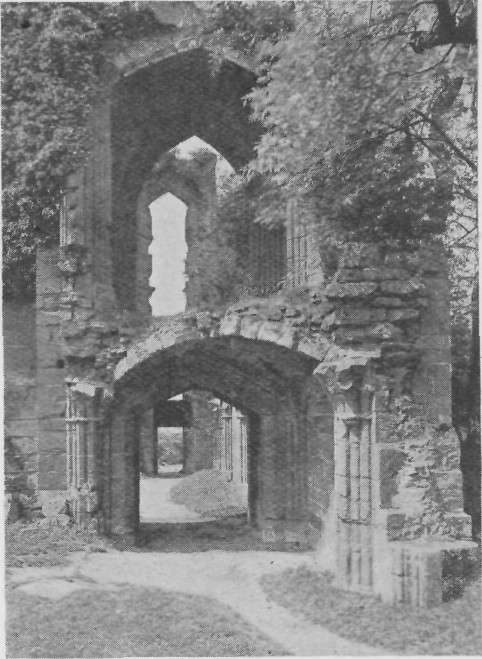
ENTRANCE TO THE GREAT HALL, KENILWORTH.
The arrival of the Queen, who had journeyed from Warwick Castle, had been somewhat delayed, and the Guards had some difficulty in keeping the course clear until she appeared with the lords and ladies who accompanied her. It was dark when she approached the Castle, and immediately there arose from the multitude a shout of applause, so tremendously vociferous that the country echoed for miles around. The Guards, thickly stationed upon the road by which the Queen was to advance, caught up the acclamation, which ran like wildfire to the castle, and announced to all within that Queen Elizabeth had entered the Royal Castle of Kenilworth. The whole music of the castle sounded at once, and a round of artillery, with a salvo of small arms, was discharged from the battlements; but the noise of drums and trumpets, and even of the cannon themselves, was but faintly heard amidst the roaring and reiterated welcome of the multitude. As the noise began to abate, a broad glare of light was seen to appear from the gate of the park, and, broadening and brightening as it came nearer, advance along the open and fair avenue that led towards the Gallery Tower, lined on either hand by the retainers of the Earl of Leicester. The word was passed along the lines, “The Queen! The Queen! Silence, and stand fast!” Onward came the cavalcade, illuminated by 200 thick waxen torches, in the hands of as many horsemen, which cast a light like that of broad day all around the procession, but especially on the principal group, of which the Queen herself, arrayed in the most splendid manner, and blazing with jewels, formed the central figure. She was mounted on a milk-white horse, which, she reined with peculiar grace and dignity, and in the whole of her stately and noble carriage you saw the daughter of a hundred kings.
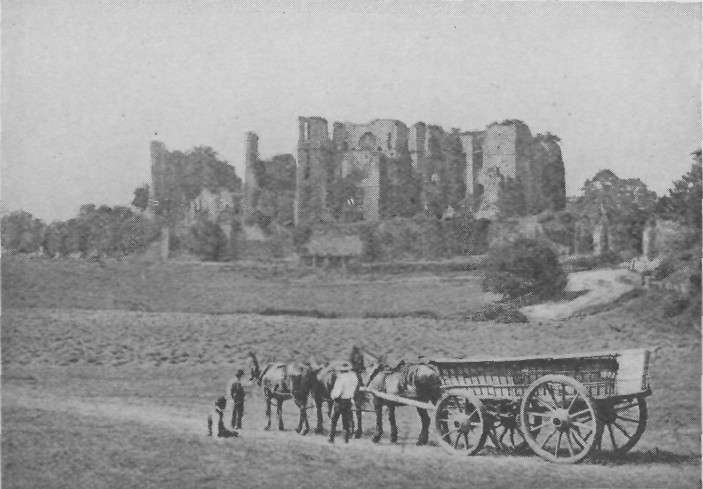
Leicester, who glittered like a golden image with jewels and cloth of gold, rode on her Majesty’s right hand, as well in quality as her Host as of her Master of the Horse. The black steed which he mounted had not a single white hair on his body, and was one of the most renowned chargers in Europe, having been purchased by the earl at large expense for this royal occasion. As the noble steed chafed at the slow speed of the procession, and, arching his stately neck, champed on the silver bits which restrained him, the foam flew from his mouth and speckled his well-formed limbs as if with spots of snow. The rider well became the high place which he held and the proud animal which he bestrode, for no man in England, or perhaps in Europe, was more perfect than Dudley in horsemanship and all other exercises belonging to his rank. He was bareheaded, as were all the courtiers in the train, and the red torchlight shone upon his long curled tresses of dark hair and on his noble features, to the beauty of which even the severest criticism could only object the lordly fault, as it may be termed, of a forehead somewhat too high. On that proud evening he wore all the graceful solicitude of a subject, to show himself sensible of the high honour which the Queen was conferring on him, and all the pride and satisfaction which became so glorious a moment. The train, male and female, who attended immediately upon the Queen’s person, were of course of the bravest and the fairest—the highest born nobles and the wisest councellors of that distinguished reign, and were followed by a crowd of knights and gentlemen. It was now the part of the huge porter, a man of immense size, to deliver an address and drop his club and resign his keys to give open way to the Goddess of the Night and all her magnificent train, but as he was so overwhelmed with confusion of spirit—the contents of one immense black jack of double ale—Sir Walter only records the substance of what the gigantic warder ought to have said in his address:
What stir, what turmoil, have we for the nones?
Stand back, my masters, or beware your bones!
Sirs, I’m a warder, and no man of straw,
My voice keeps order, and my club gives law.
Yet soft,—nay stay—what vision have we here?
What dainty darling this—what peerless peer?
What loveliest face, that loving ranks enfold.
Like brightest diamond chased in purest gold?
Dazzled and blind, mine office I forsake,
My club, my Key, my knee, my homage take.
Bright paragon, pass on in joy and bliss;—
Beshrew the gate that opes not wide at such a sight as this!
Elizabeth received most graciously the homage of the herculean porter and then passed through the guarded tower amidst the sounds of trumpets and other instruments stationed on the tower and in various parts of the castle, and dismounted near Mortimer’s Tower, which was as light as day as she walked across the long bridge built especially for her and lit with torches on either side. She had no sooner stepped upon the bridge than a new spectacle was provided, for as soon as the music gave signal that she was so far advanced, a raft on the lake, disposed as to resemble a small floating island, illuminated by a great variety of torches, and surrounded by floating pageants formed to represent sea-horses, on which sat Tritons, Nereids, and other fabulous deities of the seas and rivers, made its appearance upon the lake, and, issuing from behind a small heronry where it had been concealed, floated gently towards the farther end of the bridge. On the islet appeared a beautiful woman, clad in a watchet-coloured silken mantle, bound with a broad girdle, inscribed with characters like the phylacteries of the Hebrews. Her feet and arms were bare, but her wrists and ankles were adorned with gold bracelets of uncommon size. Amidst her long silky black hair she wore a crown or chaplet of artificial mistletoe, and bore in her hand a rod of ebony tipped with silver. Two nymphs attended on her, dressed in the same antique and mystical guise. The pageant was so well managed that the Lady of the Floating Island, having performed her voyage with much picturesque effect, landed at Mortimer’s Tower with her two attendants, just as Elizabeth presented herself before that outwork. The stranger then in a well-penned speech announced herself as that famous Lady of the Lake renowned in the stories of King Arthur, who had nursed the youth of the redoubted Sir Lancelot, and whose beauty had proved too powerful both for the wisdom and the spells of the mighty Merlin. Since that period she had remained possessed of her crystal dominions, she said, despite the various men of fame and might by whom Kenilworth had been successively tenanted. The Saxons, the Danes, the Normans, the Saintlowes, the Clintons, the Montforts, the Mortimers, the Plantagenets, great though they were in arms and magnificence, had never, she said, caused her to raise her head from the waters which hid her crystal palace. But a greater than all these great names had now appeared, and she came in homage and duty to welcome the peerless Elizabeth to all sport which the castle and its environs, which lake or land, could afford! The queen received the address with great courtesy and the Lady of the Lake vanished, and Arion, who was amongst the maritime deities, appeared upon his dolphin in her place. But amidst all this pageantry Sir Walter throws a side-light on Mervyn’s Tower, where we see a prisoner, a pale, attenuated, half dead, yet still lovely lady, Amy Robsart, the neglected wife of Leicester, incarcerated there while her husband is flirting with the queen in the gay rooms above. Her features are worn with agony and suspense as she looks through the narrow window of her prison on the fireworks and coloured fires outside, wondering perhaps whether these were emblems of her own miserable life, “a single spark, which is instantaneously swallowed up by the surrounding darkness—a precarious glow, which rises but for a brief space into the air, that its fall may be lower.”
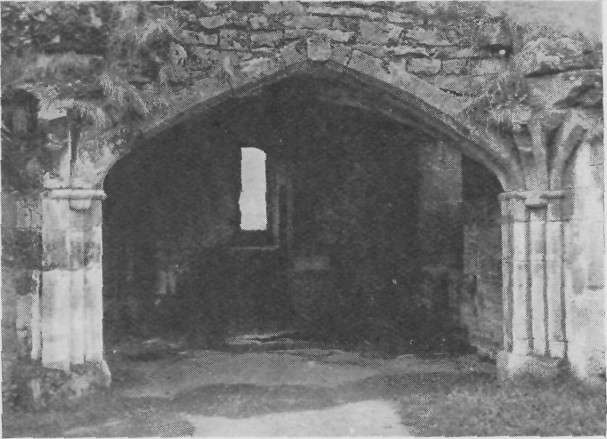
MERVYN’S TOWER, KENILWORTH CASTLE.
Sir Walter Scott described Kenilworth as “a place to impress on the musing visitor the transitory value of human possessions, and the happiness of those who enjoy a humble lot in virtuous contentment,” and it was with some such thoughts as these in our own minds that we hurried away across fields and along lovely by-lanes towards Leamington, our object in going there by the way we did being to get a view of the great mansion of Stoneleigh, the residence of Lord Leigh, who was also a landowner in our native County of Chester. It seemed a very fine place as we passed through the well-wooded park surrounding it, and presently reached his lordship’s village of Ashow, where the old church, standing on a small knoll at the end of the village, looked down upon the River Avon below, which was here only a small stream. The roofs of many of the cottages were thatched with straw, and although more liable to be set on fire than those covered with the red tiles so common in the County of Warwick, they looked very picturesque and had the advantage of not being affected so much by extremes of temperature, being warmer in winter and cooler in summer for those who had the good fortune to live under them. We noticed several alms houses in the village, and near the smithy had a talk with an old man who was interested to know that we came from Cheshire, as he knew his lordship had some property there. He told us that when a former Lord Leigh had died, there was a dispute amongst the Leigh family as to who was the next owner of the estate, and about fifty men came up from Cheshire and took possession of the abbey; but as the verdict went against them they had to go back again, and had to pay dearly for their trespass. He did not know where the Leighs came from originally, but thought “they might have come from Cheshire,” so we told him that the first time they were heard of in that county was when the Devil brought a load of them in his cart from Lancashire. He crossed the River Mersey, which divided the two counties, at a ford near Warrington, and travelled along the Knutsford road, throwing one of them out occasionally with his pikel, first on one side of the road and then on the other, until he had only a few left at the bottom of his cart, and as he did not think these worth taking any farther, he “keck’d” his cart up and left them on the road, so there were persons named Lee, Legh, or Leigh living on each side of that road to the present day. The old man seemed pleased with our story and grinned considerably, and no doubt it would be repeated in the village of Ashow after we had left, and might probably reach the ears of his lordship himself.
Two of the Lees that the Devil left on the road when he upset his cart took possession of the country on either side, which at that time was covered with a dense forest, and selected large oak trees to mark their boundaries, that remained long after the other trees had disappeared. But in course of time it became necessary to make some other distinction between the two estates, so it was arranged that one landlord should spell his name Legh and the other Leigh, and that their tenants should spell the name of the place High Legh in one case and High Leigh in the other, so that when name-plates appeared on carts, each landlord was able to tell to which estate they belonged. There were many antiquities in the country associated with his Satanic Majesty, simply because their origin was unknown, such as the Devil’s Bridge over which we had passed at Kirkby Lonsdale, and the Devil’s Arrows at Aldborough, and it was quite possible that the remote antiquity of the Legh family might account for the legend connected with them. There were several facts connected with the Cheshire estate of the Leghs which interested us, the first being that my grandfather was formerly a tenant on the estate, and the squire had in his possession the rent rolls for every year since about 1289. A fact that might interest ladies who are on the lookout for a Mr. Wright is, that out of a hundred tenants on that estate at the present day, twenty-seven householders bear the name of Wright.
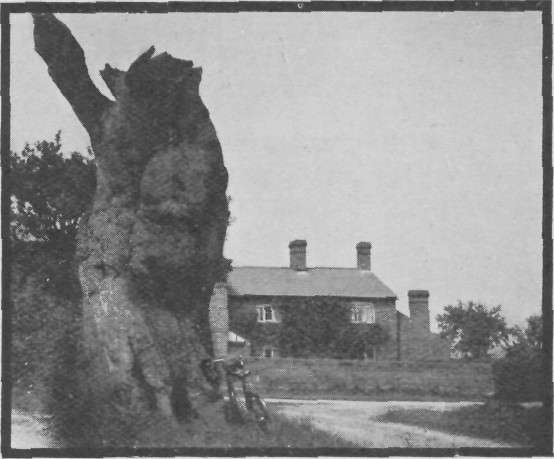
REMAINS OF THE BROAD OAK, HIGH LEGH.
But the strangest incident connected with High Legh was the case of a young man who came from Scotland to work in the squire’s gardens there. He had attended Warrington Market, and was returning over the river bridge when he stopped to look at a placard announcing a missionary meeting to be held in the town that night. He decided to stay, although he had quite seven miles to walk on his way home, and was so impressed by what he heard that he decided to become a missionary himself, and became one of the most famous missionaries of the nineteenth century. His name was Robert Moffat, and he laboured hard in South Africa, where his son-in-law, David Livingstone, following his example, also became a renowned explorer and missionary in the “Dark Continent.”
Accept me for Thy service, Lord,
And train me for Thy will,
For even I in fields so broad
Some duties may fulfil;
And I will ask for no reward
Except to serve Thee still.
MOFFAT.
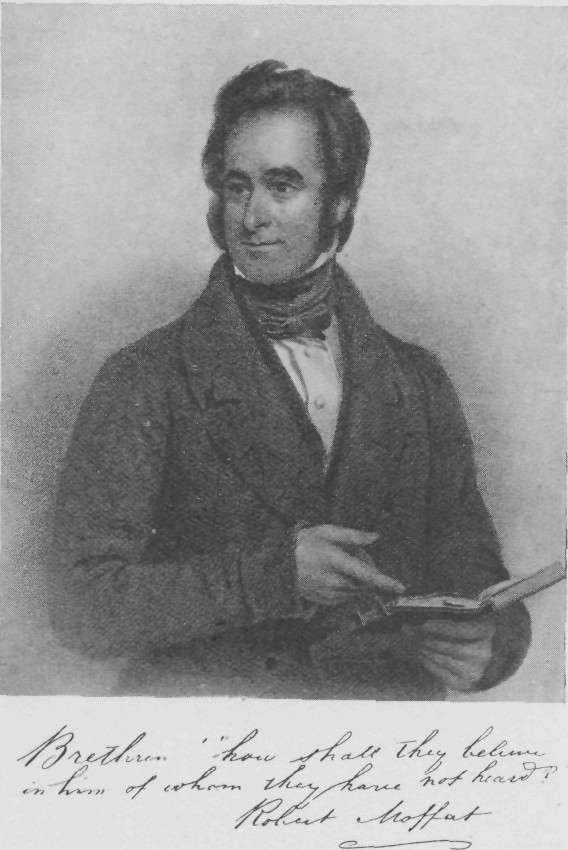
We soon arrived at Leamington, which was quite an aristocratic town, and different from any other we had seen on our journey, for it consisted chiefly of modern houses of a light stone colour, which contrasted finely with the trees with which the houses were interspersed and surrounded, and which must have appeared very beautiful in the spring time.
The chief object of interest there was the Spa, which although known to travellers in the seventeenth century, had only come into prominence during recent times, or since the local poets had sung its praises. In the introduction to a curious book, published in 1809 by James Bissett, who described himself as “Medallist to his Majesty King George the Third, proprietor of the Picture Gallery, public, news-room, and the museum at Leamington,” there appeared the following lines:
Nay! Foreigners of rank who this look o’er
To try the Wells may quit their native shore;
For when they learn the virtues of the Spaw
Twice tens of thousands to the spot will draw,
As when its wondrous powers are pointed out
And men found cap’ring who have had the gout;
When pallid cheeks regain their roseate blush
And vigorous health expels the hectic flush
When those once hypp’d cast the crutch away;
Sure when the pride of British Spas they see
They’ll own the humble instrument in me!
The Spa, it appeared, had been patronised by royalty on several occasions, and Queen Victoria in 1838 acceded to the request that the inhabitants might henceforth style the town the “Royal Leamington Spa.” Benjamin Satchwell claimed to have discovered the principal well there in 1784, and on his tombstone in the churchyard appeared the following:
Hail the unassuming tomb
Of him who told where health and beauty bloom,
Of him whose lengthened life improving ran—
A blameless, useful, venerable man.
We only stayed a short time here, and then walked quickly through a fine country to the ancient town of Warwick, with Guy’s Cliffe and Blacklow Hill to our right, the monument on the hill being to Piers Gaveston, Earl of Cornwall, the hated favourite of Edward II. Gaveston was beheaded on the hill on July 1st, 1312, and the modern inscription reads:
In the hollow of this rock was beheaded, on the first day of July 1312, by barons, lawless as himself, Piers Gaveston, Earl of Cornwall, the minion of a hateful King, in life and death a memorable instance of misrule.

Gaveston surrendered to the insurgent barons at Scarborough, on condition that his life should be spared; but he had offended the Earl of Warwick by calling him the “Black Hound of Arden,” and the earl caused him to be conveyed to Warwick Castle. When brought before Warwick there, the Earl muttered, “Now you shall feel the Hound’s teeth,” and after a mock trial by torchlight he was led out of the castle and beheaded on the hill. Every one of the barons concerned in this rather diabolical action died by violence during the next few years.
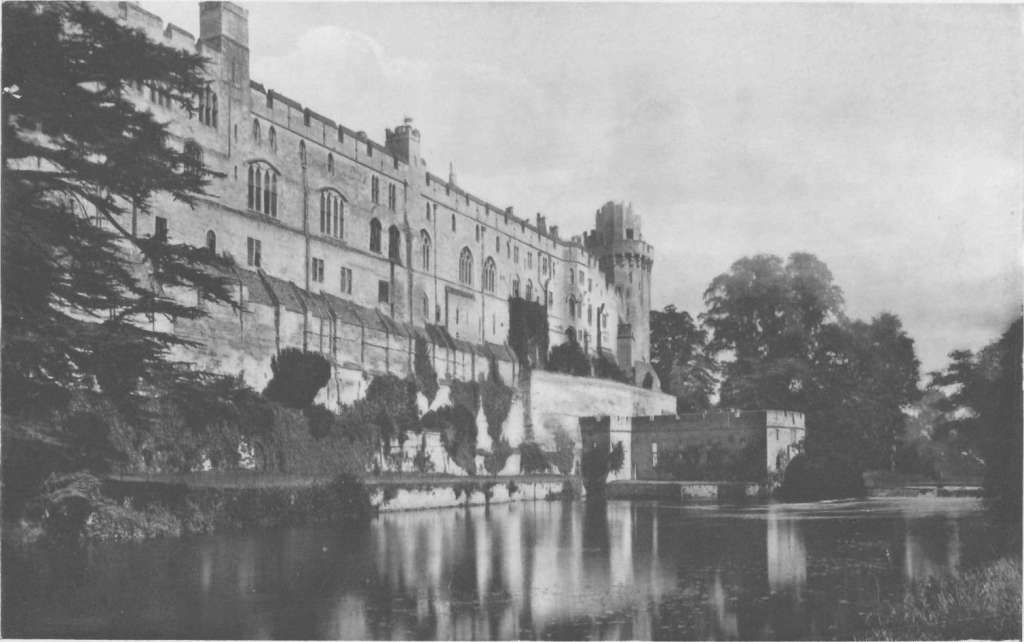
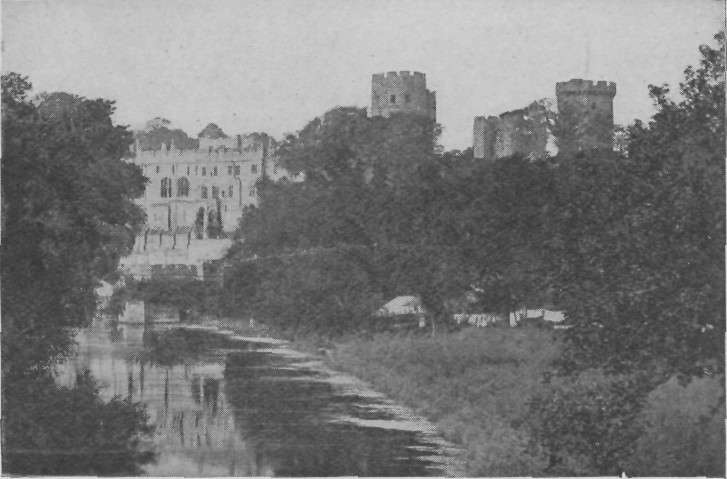
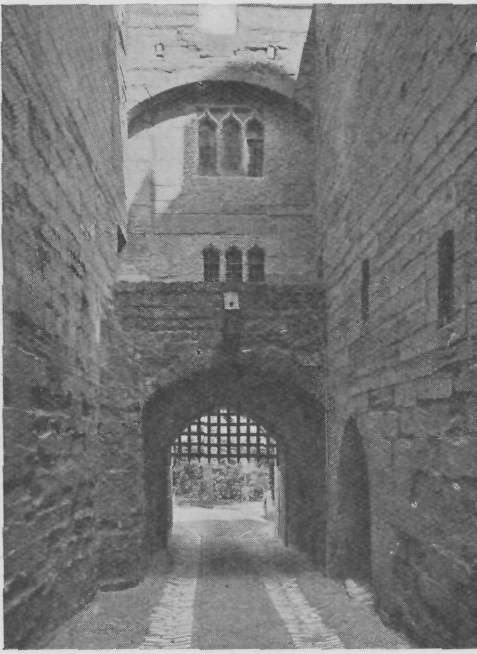
THE PORTCULLIS, WARWICK CASTLE
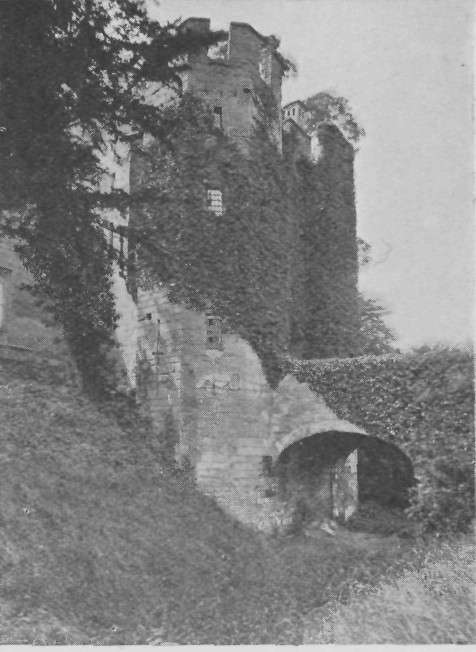
ENTRANCE TOWERS, WARWICK CASTLE
As we crossed the bridge leading over the River Avon we had a splendid view of Warwick Castle, which had the reputation of being the finest example of a fortified castle in England, Sir Walter Scott describing it as “the fairest monument of ancient and chivalrous splendour which yet remain uninjured by time.” It could boast of a continuous history from the time of Ethelfreda, the daughter of the Saxon King, Alfred the Great, and its towers rose to a considerable height, Cæsar’s tower reaching an elevation of 174 feet. Here could be seen the famous and exquisite Vase of Warwick, in white marble, of unknown age and of fabulous value, said to have been found at the bottom of a lake near Hadrian’s Villa, at Tivoli, in Italy. There were an immense number of curios in the castle, some of which were connected with that famous character Guy, Earl of Warwick, including his shield, sword, and helmet, and his kettle of bell-metal, twenty-six feet wide and capable of holding 120 gallons of water. We had no time to visit the interior of the castle, but it was interesting to read, in one of his letters, what Dr. Adam Clark saw there in 1797: “I was almost absolutely a prey to astonishment and rapture while I contemplated the painting of the wife of Schneider by Rubens, such a speaking canvas I never beheld.” He saw the large Etruscan vases collected by Sir William Hamilton, some bronze cups dug out of the ruins of Herculaneum, and the bed in which Queen Anne slept and which, according to report, she wrought with her own hands. In the Armoury he was permitted to fit on some of the armour, and attempted also to wield the sword of Guy, Earl of Warwick, which weighed seventy pounds. He also examined the rest of Guy’s gigantic equipments, not omitting his porridge-pot, which held no gallons and was filled every time an Earl of Warwick came of age. This Guy was not the famous King Maker, but the original Guy, who lived at a time when England was covered with thick forests in which savage beasts, now unknown, roamed at large, causing great havoc amongst the early settlers, both to their persons and their cattle. Of gigantic stature, he was renowned for his courage and prowess, and, being in love with the fair Felice at Warwick Castle, for her sake he performed prodigious feats of valour, both at home and abroad. Amongst other monsters which preyed upon and terrified human beings he killed the wild and fierce Dun Cow which infested Dun’s Moor, a place we had passed by the previous day; and we were reminded of his prowess when we saw the sign of the “Dun Cow” displayed on inns in the country, including that on the hotel at Dunchurch. He went on a pilgrimage to the Holy Land, where he killed many Saracens, and when on his return he landed at Portsmouth, King Athelstane, ignorant of his name, asked him if he would become his champion in a contest on which the fate of England depended. The king told him that the Danes had with them a champion named Colbran, a gigantic Saracen, and that they had offered to stake their fortunes on a duel between him and an English champion, not yet found, on condition that if Colbran won, England must be given up to Anlaf, King of Denmark, and Govelaph, King of Norway. Guy undertook the fight willingly, and defeated and killed the gigantic Saracen, after which he privately informed the king that he was the Earl of Warwick. He secured the hand and affections of the fair Felice, but when the thoughts of all the people he had killed began to haunt him, he left her, giving himself up to a life of devotion and charity, while he disappeared and led the life of a hermit. She thought he had gone into foreign lands, and mourned his loss for many years; but he was quite near the castle all the time, living beside the River Avon in a cave in a rock, which is still called Guys Cliffe, and where he died. Huge bones were found and kept in the castle, including one rib bone, which measured nine inches in girth at its smallest part and was six and a half feet long; but this was probably a bone belonging to one of the great wild beasts slain by the redoubtable Guy. We were sorry we could not explore the castle, but we wanted particularly to visit the magnificent Beauchamp Chapel in St. Mary’s Church at Warwick. We found this one of those places almost impossible to describe, and could endorse the opinion of others, that it was “an architectural gem of the first water and one of the finest pieces of architectural work in the kingdom.” It occupied twenty-one years in building, and contains the tomb of Richard Beauchamp, under whose will the chapel was begun in 1443; Robert Dudley, Earl of Leicester, the haughty favourite of Queen Elizabeth, was also entombed here. We had too much to do to-day to stay very long in any place we visited, but we were interested in the remains of a ducking-stool in the crypt of the church, although it was far from being complete, the only perfect one of which we knew being that in the Priory Church of Leominster, which reposed in a disused aisle of the church, the property of the Corporation of that town. It was described as “an engine of universal punishment for common scolds, and for butchers, bakers, brewers, apothecaries, and all who give short measure, or vended adulterated articles of food,” and was last used in 1809, when a scolding wife named Jenny Pipes was ducked in a deep place in one of the small rivers which flowed through that town. The following lines, printed on a large card, appeared hanging from one of the pillars in the aisle near the stool:
There stands, my friend, in yonder pool,
An engine called a Ducking Stool;
By legal power commanded down,
The joy, and terror of the town.
If jarring females kindle strife,
Give language foul, or lug the coif:
If noisy dames should once begin
To drive the house with horrid din,
Away! you cry, you’ll grace the stool
We’ll teach you how your tongue to rule.
Down in the deep the stool descends,
But here, at first, we miss our ends,
She mounts again, and rages more
Than ever vixen did before.
If so, my friend, pray let her take
A second turn into the lake;
And rather than your patience lose
Thrice and again, repeat the dose,
No brawling wives, no furious wenches
No fire so hot, but water quenches.
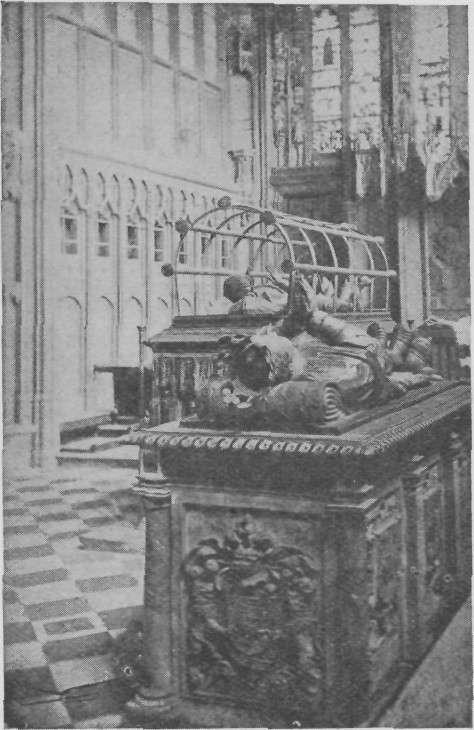
TOMBS IN THE BEAUCHAMP CHAPEL.
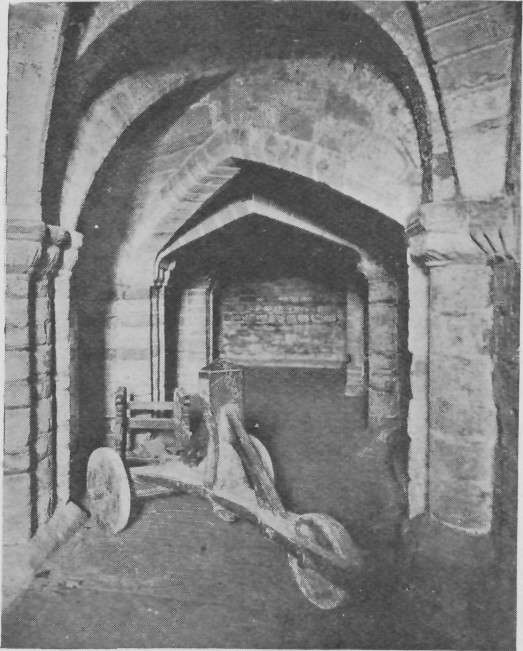
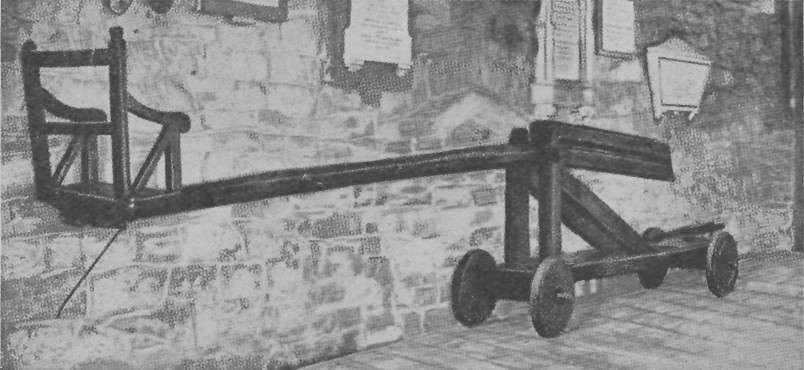
The stool was exactly like a chair without legs, fastened on one end of a long pole, in the centre of which was a framework with solid wooden wheels. The culprit was fastened in the chair with her face towards the men, who were at the other end of the pole, and who had to push and guide the machine through the narrow streets of the town until they reached the “deep hole,” where the unfortunate woman had to be ducked overhead in the river. Her feet were securely tied to the top of the pole to prevent them from being hurt when passing through the town, and to hinder her from using them to keep her head above the water. The poet describes the “engine called a ducking-stool” as the “joy and terror of the town,” but the “joy” could only have been that of the men, women, and children who could be spared to see the show, and knew the woman’s scolding propensities. If she continued scolding after the first “duck,” down she went again, and again, until, as we imagined, half filled with water, she was unable to scold further, and so the water triumphed in the end:
No brawling wives, no furious wenches
No fire so hot, but water quenches.
The tower of St. Mary’s Church was built on four lofty arches, one of which formed the entrance to the church while the other three formed entrances to the street, the footpath passing through two of them.
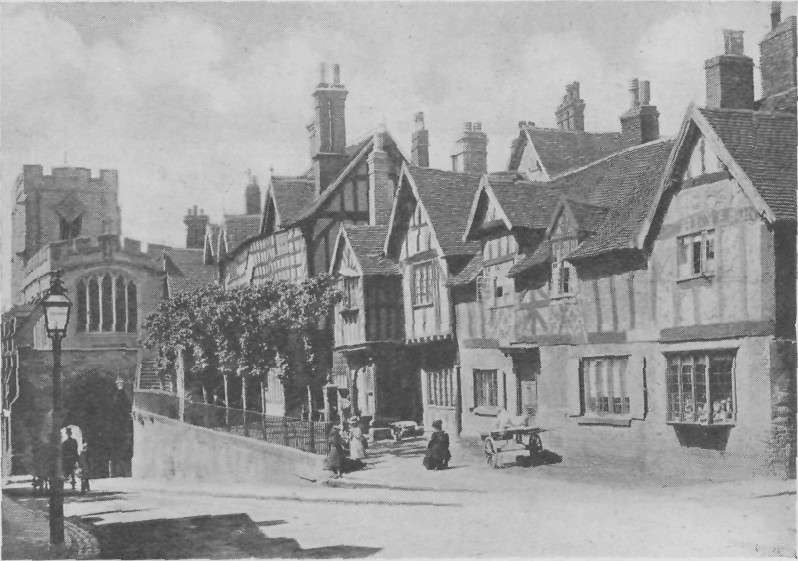
LORD LEICESTER’S HOSPITAL AND GATE.
We passed alongside the ancient and picturesque half-timbered building known as Lord Leicester’s Hospital, which was one of the few buildings in the town that escaped the fire in 1694. It had been built by Robert Dudley, Earl of Leicester, the favourite of Queen Elizabeth and of Kenilworth fame, to accommodate twelve poor men or brethren besides the master, who, according to Dugdale the famous antiquary, “were to be clothed in blew cloth, with a ragged staff embroydered on the left sleeve,” and not to go into the town without them. The hospital dated from 1571, but what was formerly the banqueting-hall belonged to an earlier period, and owed its preservation largely to the fact that the timber of which the roof had been constructed was Spanish chestnut, a timber which grew luxuriantly in the forests of England, and resembled English oak. It was largely used by the monks in the building of their refectories, as no worm or moth would go near it and no spider’s web was ever woven there, the wood being poisonous to insects. It is lighter in colour than oak, and, seeing the beams so clean-looking, with the appearance of having been erected in modern times, it is difficult for the visitor to realise that they have been in their present position perhaps for five or six centuries. Over one of the arched doorways in the old hospital appeared the insignia of the bear and the ragged staff, which was also the sign of public houses, notably that at Cumnor, the village of Amy Robsart. This we discovered to be the arms of the Earls of Warwick, originating during the time of the first two earls: the first being Arth or Arthgal of the Round Table—Arth meaning bear—and the second Morvid, who in single combat overcame a mighty giant who came against him with a club—a tree pulled up by the roots and stripped of its branches; and in remembrance of his victory over the giant the “ragged staff” ever afterwards appeared on the coat of arms of the Earls of Warwick.
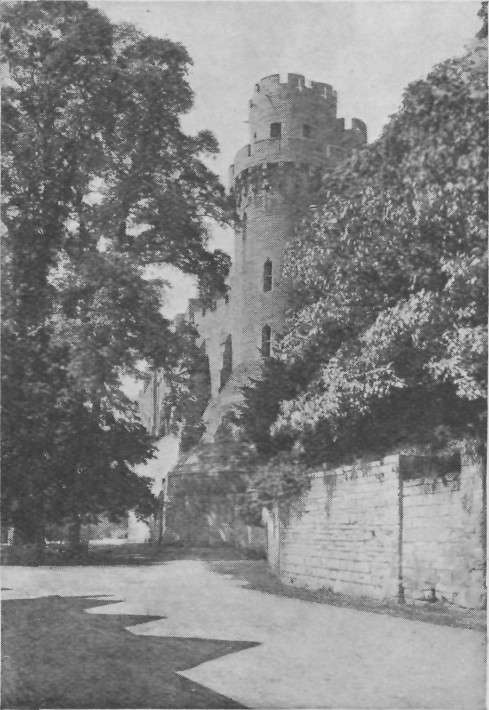
CÆSAR’S TOWER, WARWICK CASTLE.
At the end of the hospital stood St. James’s Chapel, built over the West Gate of the town, which we left by the footpath leading both under the church and its tower, on our way to Stratford-on-Avon.

SHAKESPEARE’S HOUSE (Before Restoration).
We walked the eight miles which separated the two towns at a quick speed, and, leaving our luggage at the “Golden Lion Inn” at the entrance to Stratford, we went to explore that town, and soon arrived at the birthplace of Shakespeare, one of the few houses in England where no fire is ever lit or candle lighted. It was a very old-fashioned house built with strong oak beams, the ceiling of the room in which Shakespeare was born in 1564 being so low that visitors could easily reach it, and they had written their names both on it and the walls until there was scarcely an available space left. Written with lead pencil, some of the autographs were those of men distinguished in every rank of life both past and present, and would doubtless have become very valuable if they had been written in a book, but we supposed Visitors’ Books had not been thought of in those days. We wondered if the walls would ever be whitewashed again, and this thought might have occurred to Sir Walter Scott when he scratched his name with a diamond on one of the window panes. It was at another house in the town that Shakespeare wrote his plays and planted a mulberry-tree in the garden. This mulberry-tree used to be one of the objects of interest at Stratford, nearly every pilgrim who arrived there going to see it. There came a time when the house and garden changed hands, and were sold to a clergyman named Gastrell, who we were sorry to learn was a countryman of ours, as he belonged to Cheshire. He had married a “lady of means,” who resided at Lichfield, and they bought this house and garden, we supposed, so that they might “live happily ever afterwards”; but the parson, who must have had a very bad temper, was so annoyed at people continually calling to see the mulberry-tree that he cut it down. It was probably owing to this circumstance that he had a furious quarrel with the Corporation of Stratford because they raised the rates on his property. When he complained that they were excessive and the surveyor insisted on their being paid, Gastrell ended the matter by pulling the house down to the ground, and leaving the neighbourhood, so we supposed it was then a case of—
Where he’s gone and how he fares
Nobody knows and nobody cares.
Eventually the site became a public garden, where a slip of the mulberry-tree may still be seen.
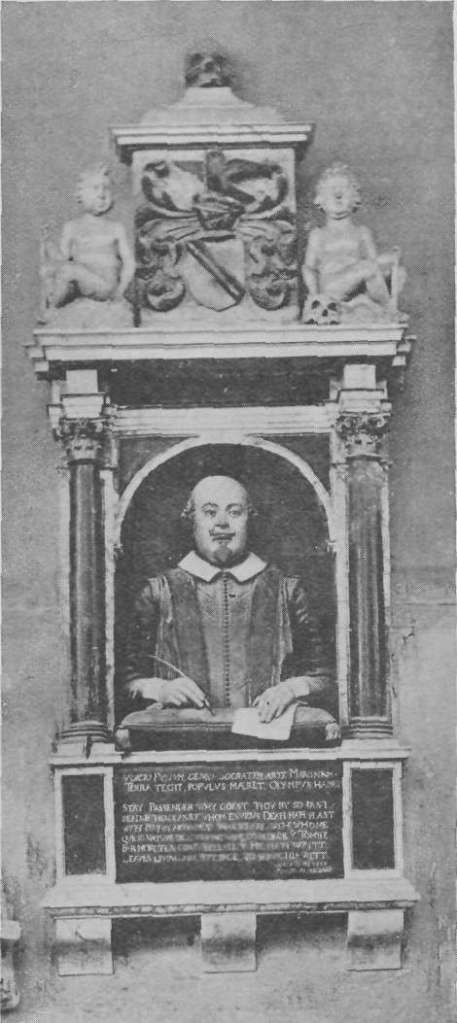
SHAKESPEARE’S TOMB, STRATFORD-ON-AVON.
Shakespeare died in 1616, and was buried in the church at Stratford, where on the ancient stone that covered his remains were inscribed in old English characters the well-known words:
Good friend, for Jesus’ sake forbear
To dig the dust enclosed here,
Blest be the man that spares these stones,
And curst be he that moves my bones.
Shakespeare’s threatened curse was doubtless one reason why his bones had remained undisturbed, for it was no uncommon occurrence in his time for the bones of the dead to be removed from a tomb and to be replaced or mingled with those of a stranger, for even the tomb of his daughter, who died in 1649, shared that fate, her epitaph being effaced and replaced by another of a person in no way related to the Shakespeare family, but who was buried in the same grave.
In one corner of the church was a tomb bearing the effigy of John O’Combe, who we thought might have hailed from the neighbourhood of the old abbey of that name which we passed the night before. In spite of his benefactions recorded in the church, he was looked upon as a usurer, because he charged 10 per cent, for his money. He was at one time a friend of Shakespeare, and often asked the poet, who was no doubt acquainted with his rate of interest, to write him an epitaph. When at length he acceded to his request he greatly offended Combe by writing:
“Ten in the hundred” lies here en-graved,
‘Tis a hundred to ten if his soul be saved.
If any one asks who lies in his tomb—
“Oho” quoth the devil “’tis my John O’Combe.”
Shakespeare bought the house in which he wrote his plays from the Clopton family, calling it “New Place,” and a sorrowful story was connected with the Clopton vault in Stratford Church. Sir Hugh Clopton, who was buried there, was Lord Mayor of London in 1492, and had a very beautiful young daughter named Charlotte, who, according to her portrait, which was still in existence, had light blue eyes and pale golden hair. In the time when a plague was raging in Stratford she was said to have been found sitting in a chair in the garden apparently dead, and was at once carried to the vault to be buried. A few days afterwards another member of the family died of the plague, and was also taken to the vault; but when the torch-bearers descended the steps leading into the vault, the light from their torches revealed the form of Charlotte Clopton leaning against the side of the tomb. They were stricken with horror, but had arrived too late to save her, as she was now quite dead. The poor girl must have been in a trance when they carried her to the vault, and in her agony of hunger had bitten a piece of flesh from her own shoulder!
We found the “Golden Lion” quite a comfortable hotel, and had a first-class tea there in the company of an actor from London, who, like ourselves, was exploring the country hereabouts, though perhaps from a different point of view, and who had a lot to tell us about Shakespeare and his plays. He had been to a village named Bidford a few miles away where there was an old-fashioned inn, in the courtyard of which Shakespeare and his friends had acted his Midsummer’s Night Dream long before it appeared in London. It was at that inn that Shakespeare on one occasion had too much to drink, and when on his way home to Stratford he lay down under a thorn tree to sleep off the effects; the tree was fenced round later on in memory of that rather inglorious event. Although we were temperance men, we had to admit that the old inns where the stage-coaches stopped to exchange passengers and horses had a great attraction for us, and it was not without a feeling of regret that we found them being gradually closed throughout the country we passed through. They had mostly been built after the same model, the gateway or door at the entrance being arched over and placed in the centre of the front of the hotel. Through this archway the coaches, with passengers and luggage, could pass in and out, a door on each side of the entrance leading into different sections of the inn. The yards of the inns were in the form of an oblong, generally roofed over, and along each side were the out-offices, storerooms, and stables, with a flat roof overhead, extending backwards as far as the bedroom doors, and forming a convenient platform for passengers’ luggage as it was handed on and off the roof of the coach. The outside edge of the platform was sometimes ornamented with a low palisade, which gave the interior of the covered yard quite a pleasant and ornamental appearance.

Such was the character of the inns that existed in the time of Shakespeare, and although sanitary regulations in later times required the horses to be provided for in stable-yards farther in the rear, very little structural alteration in the form of the inns had taken place.
The actor told us that in Shakespeare’s time nearly all the acting outside London and much within was done in the courtyards of these inns. The actors travelled in two covered wagons or coaches, and when they arrived at the inn they were drawn into the inn yard, while two members of the party went out into the town or village vigorously beating a drum to announce the arrival of the actors, almost the entire resident population, men, women, and children, following them to the inn yard to listen to the play, which custom, he said, was referred to by Shakespeare in one of his plays in the passage:
The Actors have come and the rout are following!
The covers were then taken off the top of the wagons and placed round the sides of the wheels, to act as screens while the actors changed their dresses, which had to be done underneath the coaches. Meanwhile boards, kept at the inns specially for that purpose, were fastened over the tops of the wagons, and on these the actors performed their plays. The squire, or lord of the manor, had the right to see the plays free of charge, and when he came, a bar of wood was placed across the entrance to one of the horse-boxes to keep off the spectators who thronged the inn yard. From these people the actors collected what money they could, while those who were better able to pay were accommodated on the platform above the stables, which commanded a better view of the play.
When theatres were built, he informed us, they were modelled in the same shape as the yards of these inns, their arrangement being also the same: the stage represented the boards on the wagons and the actors dressed underneath it, the pit corresponded to the inn yard, the gallery to the platform over the stables, the boxes to the place railed off for the squire. The actor was not sure about the stalls, and thought these were instituted at a later period; but we reminded him that stalls were a necessary adjunct to stables.
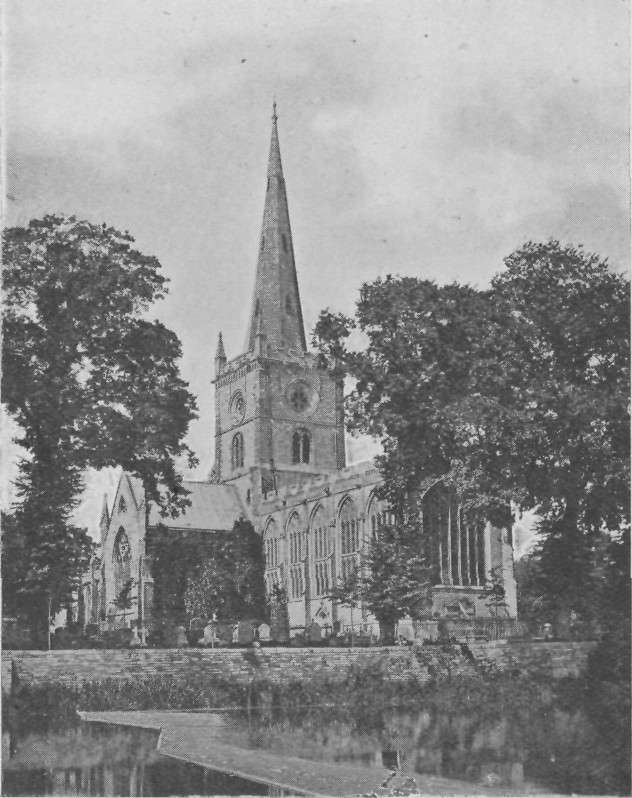
He also told us that the actors had a language peculiar to their profession, which also dated from the time when they acted in the country inn yards, for even when they travelled by train they were always “on the road,” and when acting in the theatre they were still “on the boards.”
We asked him if he knew about Shakespeare’s stealing the deer from Charlecote Park, Sir Thomas Lucy’s property, and he said he did; but the report was not quite correct, for at that time the park was surrounded by Common Land, and it was there that Shakespeare shot the deer, which only went into the park to die. Shakespeare followed it, and as he was removing the carcase he was caught and summoned; the case hinged on whether he had his weapon with him or not. As that could not be proved against him, the case was dismissed. It appears that the Law of England is the same on that point to-day as in the time of Shakespeare, for if a man shoots a hare on his own land, and it dies on adjoining land belonging to some one else, he has a perfect right to remove it, providing he does not take his gun with him, which would constitute a punishable offence. We were sorry to leave the hotel, as we should have been very comfortable there, and the actor, who wanted to hear of our adventures, did his best to persuade us to stay; but our average must be made up, and I particularly wanted to celebrate my birthday on the following Sunday at Oxford.
It was quite dark as we crossed the river bridge on our way to Kineton, ten miles distant, and we soon lost sight of the lights of Stratford; as we left we could see the church being lit up for evening service. A man on the bridge in directing us the way to Kineton told us we should pass the park where “old Shakespeare stole the deer,” and he seemed to think he was a regular poacher there. We could not see the deer, but we heard them as we passed alongside the park, the noise resembling that of a pig, but not nearly so loud. We soon afterwards arrived at a fair-sized village about half-way between Stratford and Kineton, where we recrossed the river and, turning towards the right, walked along a lonely road for an hour or two, until we reached Kineton, where we intended to stay the night. We were, however, doomed to disappointment, for, as the railway was being cut through there, the whole place was completely filled with engineers and navvies, who had taken up all the accommodation. There was not even a chair “to be let,” so we were obliged to move on in the hope that we might come to some house or village on the road where we could obtain lodgings for the night. We had already walked thirty miles and were sleepy and tired and could not walk quickly enough to keep ourselves warm, for the night was damp with fog and very cold, and our quick walk had caused us to perspire, so that we were now in what might be termed a cold sweat, a danger to which we were often exposed during these later stages of our long journey. Fortunately for us, however, the cuttings from the sides of the hedges and ditches, which extended for miles, had been tied in neat little bundles, possibly for sale, and deposited on the sides of the road, and every now and then we set fire to one of these and stayed a few minutes to warm ourselves, expecting every moment to attract the attention of a policeman, and get ourselves into trouble, but none appeared. The last quarter of the moon was now due, and although we could not see it through the misty clouds overhead, it lighted up the air considerably when it rose, so that we could then see the fields on either side of the road, especially when we came to an upward gradient. We gradually became conscious of what appeared to be a great black cloud in front of us as we climbed up the road, and were astonished when we perceived that instead of a cloud it was a tremendous hill, towards which our road was leading us. We had been walking for days through a level country, and did not expect to come to a hill like this, and this strange and sudden development sharpened us up a little, for we had only been walking at about the rate, including stoppages, of one mile per hour, so we walked steadily up the hill, and presently came in sight of some large trees, from which we knew that we were approaching civilisation; we had not seen a single habitation or a living being of any kind since leaving Kineton. On the other side of a field to the left of our road we could see a rustic-looking shed which we resolved to visit, so, climbing over the fence, we walked cautiously towards it, and found it was an ancient store-shed for hay and straw. We listened attentively for a few moments and, as there was no wind, we could have heard the breathing of a man or of any large animal that might have been sleeping there; but as all appeared quiet, we sat down on the dry straw thankful to be able to rest our weary limbs if only for a short time.
We had some difficulty in keeping ourselves awake, but we durst not go to sleep as the night was so very cold, and there was a rough floor immediately above us which had caused us some uneasiness. When we heard the footsteps of some small animal creeping stealthily amongst the straw over our heads, as if preparing to make a spring, we decided to evacuate our rather eerie position. It might have been a rat or more likely a cat, but as we did not care for the company of either of these animals, we lost no time in regaining the road.
As we approached the top of the hill we came to some quaint-looking houses, which appeared much too large for their occupiers to take in visitors at that early hour of the morning, especially two tramps like ourselves. We were almost sure that one of the houses was an inn, as it had a sign on the wall, though too high up for us to read in the dark. Presently we passed what appeared to be an old castle.
We could now only walk very slowly, or at a speed that my musical brother described as about equivalent to the “Dead March in Saul,” and at seven o’clock in the morning reached the entrance to the town of Banbury, exciting considerable curiosity among the men we met on the way to their work in the country.
We called at the first respectable-looking inn that we came to, where the mistress informed us we could not have two beds, “as the other people hadn’t got up yet,” but a gentleman who had to leave early was just getting up now, and we “could have his bed if we liked.” We were glad to accept the offer lest in going farther we might fare worse. We could hear the gentleman’s heavy footsteps on the floor above our heads, and as soon as the room was prepared we got into the bed he had vacated, which was still quite warm, extremely thankful to get in anywhere, and in spite of the noises usual in inns on Saturday morning we “slept like bricks” until eleven o’clock, the hour arranged for our “call.”
(Distance walked forty-two and a half miles.)
Saturday, November 4th.

We were quite surprised to find that the night before we had been walking along the site of one of the most famous battles—because it was the first—in the Great Civil War of the seventeenth century, named after the strange hill we had walked over, and known to history as the “Battle of Edge Hill.” We learned that had we crossed it on a fine clear day instead of in the dark we should have obtained a splendid view over the shires of Warwick, Gloucester, and Worcester, and portions of other counties besides. The hill itself stood in Warwickshire, but we had crossed the boundary into Oxfordshire on our way to Banbury some time in the early hours of the morning. The Royalist Army, under King Charles I, had encamped a few miles from Banbury, when Prince Rupert sent the king word that the army of the Parliament, under the command of the Earl of Essex, had arrived at Kineton. The king’s army had left Shrewsbury two days before Essex’s army departed from Worcester, and, strange as it might appear, although they were only about twenty miles away from each other at the start, they travelled almost side by side for ten days without either army knowing the whereabouts of the other. The distance between them was only six miles when the news reached the king, who, although the day was then far advanced, resolved to give battle at once. The Earl of Lindsey, who had acquired his military experience fighting in the Low Countries, was General of the king’s army, while the king’s nephew, Prince Rupert, the finest cavalry officer of his day, commanded the Horse, Sir Jacob Astley the Foot, Sir Arthur Aston the Dragoons, Sir John Heyden the Artillery, and Lord Bernard a troop of Guards. The estates and revenues of this single troop were estimated to be at least equal to those of all the members who, at the commencement of the war, voted in both Houses of Parliament; so if money could have won the battle, the king’s army ought to have been victorious; the king, moreover, had the advantage of a strong position, as his army was well placed under the summit of the hill. The battle was fought on Sunday, October 23rd, 1643, and resulted in a draw, and, though the armies stood facing each other the next day, neither of them had the heart to take the initiative or to fight again, for, as usual in such warfare, brother had been fighting against brother and father against son; so Essex retired to Warwick and the king to Oxford, the only town on whose loyalty he could depend. But to return to the battle! The prayer of Sir Jacob Astley, the Commander of the king’s foot soldiers, has been recorded as if it were one of the chief incidents on that unhappy day, and it was certainly admirable and remarkable, for he said, “O Lord! Thou knowest how busy I must be this day. If I forget Thee, do not Thou forget me!” and then in place of the usual “Amen” he called out “March on, boys!” Prince Rupert, with his dashing and furious charge, soon put Essex’s cavalry to flight, pursuing them for miles, while the right wing was also driven back; but when the king’s reserve, commanded by Sir John Byron, saw the flight of both wings of Essex’s army, they made sure that the battle was won, and, becoming anxious for some share in the victory, joined the others in their chase. Sir William Balfour, however, who commanded Essex’s reserve, seeing the advantage this afforded him, wheeled about upon the Royal Infantry, now left without horse, and dashed in amongst them, slaying right and left. Lindsay fell mortally wounded, and was taken prisoner, and his son in trying to save him shared the same fate, while the Royal Standard Bearer, Sir Edmund Verney, was slain and the standard taken; but this was afterwards recovered. When Rupert returned from his reckless chase, it looked more like a defeat than a victory. Both armies had suffered severely, and when Mr. Fisher, the Vicar of Kineton, was commissioned by Lord Essex to number those killed on the side of the Parliament, he estimated them at a little over 1,300 men, all of whom were buried in two large pits on land belonging to what was afterwards known as Battle Farm, the burial-places being known as the Grave Fields. As these were about half-way between Radway and Kineton, we were quite near them when we were lighting the fires on the sides of the road the night before, and this may have accounted for the dreary loneliness of the road, as no one would be likely to live on or near the fields of the dead if he could find any more desirable place. It was at the village of Radway where tradition stated the king and his sons breakfasted at a cottage in which for many years afterwards the old table was shown to visitors on which their breakfast stood, and it was on the hill near there where the boy-princes, Charles and James, narrowly escaped being captured as they were watching the battle that was being fought on the fields below.
We were in no hurry to leave Banbury, for we had not recovered from the effects of our long walk of the previous day and night, and were more inclined to saunter about the town than to push on. It is astonishing how early remembrances cling to us in after life: we verily believed we had come to Banbury purposely to visit its famous Cross, immortalised in the nursery rhyme:
Ride a cock-horse to Banbury Cross,
To see a fine lady get on a white horse;
She’s rings on her fingers and bells on her toes.
And she shall have music wherever she goes.
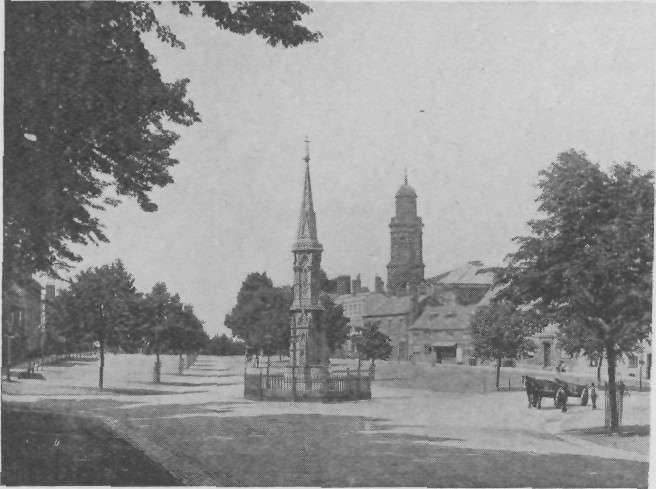
The rhyme must, like many others, have been of great antiquity, for the old Cross of Banbury had been removed by the Puritans in the year 1602, and its place taken by a much finer one, recently erected to commemorate the marriage of the Emperor Frederick of Germany to the Princess Royal of England. The fine lady and the white horse were also not to be found, but we heard that the former was supposed to have been a witch, known as the Witch of Banbury, while the white horse might have been an emblem of the Saxons or have had some connection with the great white horse whose gigantic figure we afterwards saw cut out in the green turf that covered the white chalk cliffs of the Berkshire Downs. The nursery rhyme incidentally recorded the fact that the steps at the base of the Cross at Banbury were formerly used as a convenience to people in mounting on the backs of their horses, and reminded us of the many isolated flights of three or four stone steps we had seen on our travels, chiefly near churches and public-houses and corners of streets, which had been used for the same purpose, and pointed back to those remote times when people rode on horseback across fields and swampy moors and along the pack-horse roads so common in the country long before wheeled vehicles came into common use.
We had eaten Eccles cakes in Lancashire, and Shrewsbury cakes in Shropshire, and had walked through Scotland, which Robbie Burns had described as—
The Land o’ Cakes and brither Scots,
but we had never heard of Banbury cakes until we walked through the streets of that town, and found that the making of these cakes formed one of its leading industries. The cakes in Scotland were of a sterner, plainer character than those farther south, the cakes at Banbury being described as a mixture between a tart and a mince-pie. We purchased some, and found them uncommonly good, so we stowed a few in our bags for use on our way towards Oxford. This industry in Banbury is a very old one, for the cakes are known to have been made there as far back as 1602, when the old Cross was pulled down, and are mentioned by Ben Jonson, a great dramatist, and the friend of Shakespeare. He was Poet Laureate from 1619, and had the honour of being buried in Westminster Abbey. In his comedy Bartholomew Fair, published in 1614, he mentions that a Banbury baker, whom he facetiously named Mr. “Zeal-of-the-Lord Busy,” had given up the making of these cakes “because they were served at bridals and other profane feasts.” This baker, we imagined, must have been a Puritan, for from the reign of Queen Elizabeth to that of Charles II Banbury had been noted for the large number of Puritans who lived there, and for their religious zeal; they had even been accused of altering the names of the staple industries of the town from “Cakes and Ale” to “Cakes and Zeal,” and were unpopular in some quarters, for Braithwaite in his Drunken Barnaby cuts at them rather savagely:
To Banbury came I, O profane one:
Where I saw a Puritane one
Hanging of his cat on Monday
For killing of a mouse on Sunday.
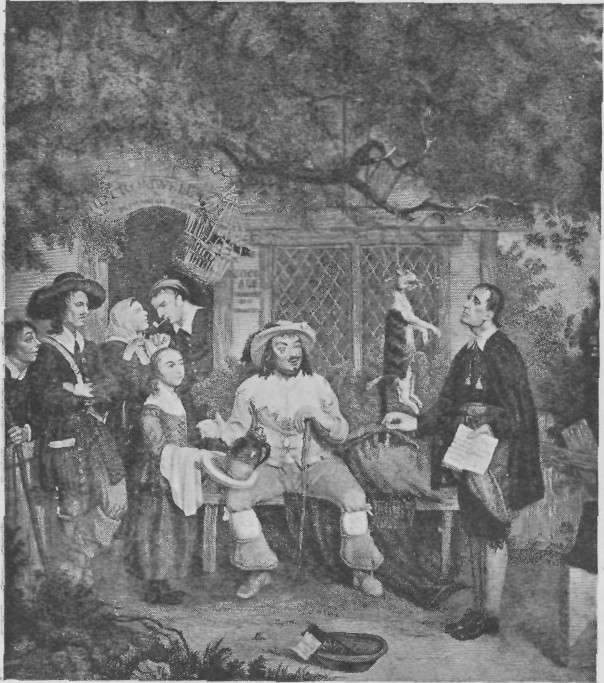
The Academy at Banbury was famous as the place where Dean Swift began to write his famous satire entitled Travels of Lemuel Gulliver, the reading of which had been one of the pleasures of our schoolboy days. He was said to have copied the name from a tombstone in the churchyard.
There were several charming old gabled houses in the town, and in “Ye Olde Reindeere Inn” was a beautiful room called the “Globe,” a name given it from a globular chandelier which once stood near the entrance. This room was panelled in oak now black with age, and lighted by a lofty mullioned window extending right across the front, while the plastered ceiling was considered to be one of the finest in the county of Oxford. In the High Street stood a very fine old house with, three gables erected about the year 1600, on which was placed an old sun-dial that immediately attracted our attention, for inscribed on it appeared the Latin words, “Aspice et abi” (“Look and Go”), which we considered as a hint to ourselves, and as the Old Castle had been utterly demolished after the Civil War, and the fine old Parish Church, “more like a cathedral than a church,” blown up with gunpowder in 1740 “to save the expense of restoring it,” we had no excuse for staying here any longer, and quickly left the town on our way to Oxford.
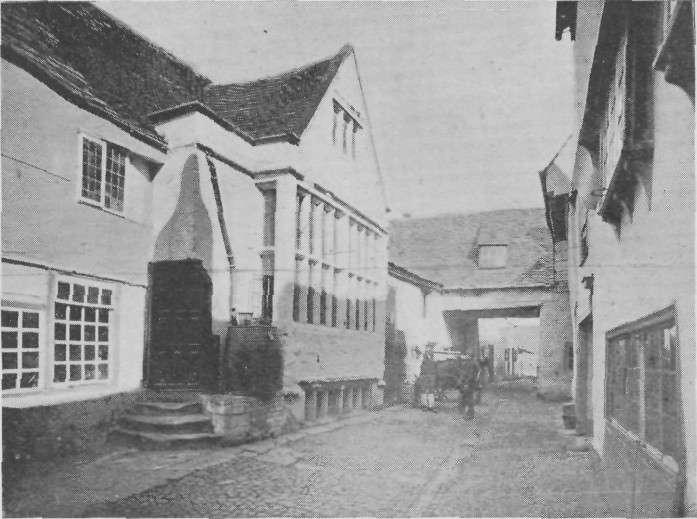
THE REINDEER INN, BANBURY.
(Outside the Globe Room.)
The Latin motto “Look and Go” reminded my brother of an old timber-built mansion in Staffordshire which, as it stood near a road, everybody stayed to admire, its architectural proportions being so beautiful. It was said that when the fugitive King Charles was in hiding there he was greatly alarmed at seeing a man on the road staring stedfastly at the house, and as he remained thus for a considerable period, the king at last exclaimed impatiently, “Go, knave, what lookest at!” Long after the king had departed the owner of the house caused his words to be carved in large characters along a great beam extending in front of the mansion, which travellers in the present day still stay to admire, though many take the words as being meant for themselves, and move on as we did at Banbury, but perhaps more slowly and reluctantly.
We had the valley of the River Cherwell to our left, and at Deddington we saw the site of the old castle from which Piers Gaveston, the unlucky favourite of Edward II, was taken by the Earl of Warwick. He had surrendered to “Joseph the Jew,” the Earl of Pembroke, at Scarborough on condition that the barons spared his life, but Warwick said he never agreed to that, and as Gaveston had greatly offended him by nicknaming him the “Black Hound” or the “Black Dog,” he took him to Warwick Castle and wreaked his venegance upon him by cutting off his head.
By what we called a “forced march” we arrived at the grounds of the famous Palace of Woodstock, and were lucky in meeting with a woodman who took us across the park, where we had a fine view of the monument, the lake, and the magnificent Palace of Blenheim.
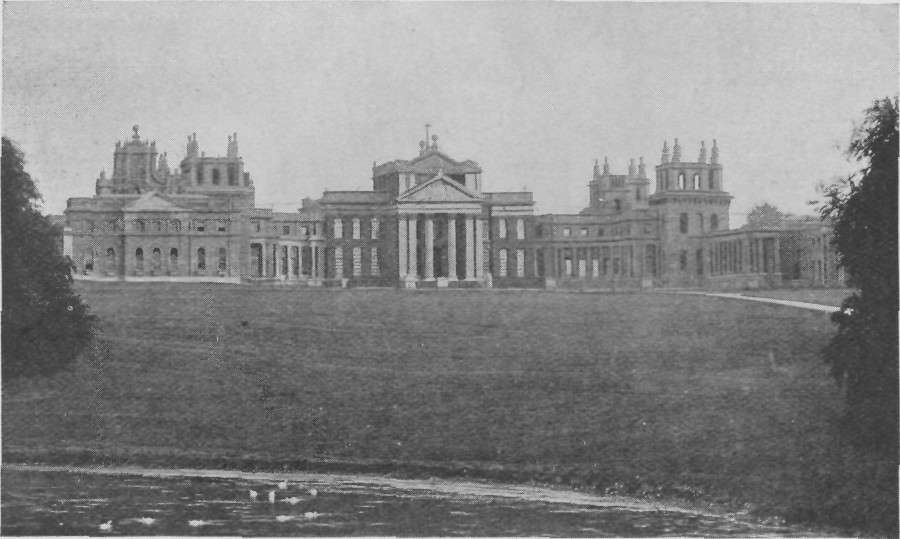
Woodstock is a place full of history and in a delightful position, with woods still surrounding it as in the days of yore, when it was the abode of kings and a royal residence. A witenagemot, or supreme council, was held here by King Ethelred in the year 866, and Alfred the Great pursued his literary work here by translating the Consolations of Boethius, and in the grounds he had a deer-fold. In Domesday Book it is described as a royal forest, and Henry I had an enclosure made in the park for lions and other wild beasts, which he surrounded by a very high wall, in which menagerie he placed the first porcupine ever seen in England, presented to him by William de Montpellier. The country people at that time imagined that the quills of the porcupine were weapons which the animal could shoot at those who hunted it. Henry II resided at the palace with the lady of his love, the Fair Rosamond. She was the second daughter of Walter, Lord de Clifford, who built his castle on a cliff overlooking a ford on the River Wye at Clifford in Herefordshire, and his daughter Rosa-mundi (the rose of the world) was born there. She had a local lover whom she discarded when Prince Henry appeared on the scene, and finally Henry took her away to Woodstock, where he built magnificent apartments for her and her children, the entrance to which was through an intricate maze in the castle grounds. The rear of the buildings adjoined the park, so that Rosamond and her children could pass out at the back into the park and woods without being perceived from the castle. Queen Eleanor was naturally jealous when she heard that she had been superseded in the king’s affections, and it was said she tried all available means to discover the whereabouts of the Fair Rosamond, but without success, until she contrived to fasten a thread of silk to one of the king’s spurs, which she afterwards followed in the maze in the castle grounds to the point where it had broken off at the secret entrance. She waited for her opportunity, and when the king was away she had the trap-door forced open, and, taking a large bowl of poison in one hand and a sharp dagger in the other, found Rosamond near a well in the park and commanded her to end her life either with one or the other. Rosamond took the poison, “and soe shee dyed,” and the well ever since has been known as Fair Rosamond’s Well; we afterwards found another well of the same name in Shropshire. She had two sons, one of whom became the Earl of Salisbury and the other Archbishop of York; an old ballad runs:—
But nothing could this furious queen
Therewith appeased bee:
The cup of deadlye poyson strong.
As she knelt on her knee,
She gave this comlye dame to drink,
Who took it in her hand;
And from her bended knee arose
And on her feet did stand.
And casting up her eyes to heaven,
She did for mercy calle;
And drinking up the poyson strong.
Her life she lost with-alle.
Edward III and his Queen Phillipa resided at Woodstock in the fourteenth century, and it was here that the Black Prince, who figured so largely in English history, was born. A nice little love story was connected with their court. The king had a page and the queen had a damsel, who fell deeply in love with each other, and whenever they got a chance walked out in the beautiful park and woods which surrounded the castle, where the young man made some poetry about the “Cuckoo and Nightingale,” whose notes they so often heard amongst the sylvan beauties of Woodstock. The king was pleased with the poetry, and the young page became quite a favourite with him. He afterwards became known as the “Father of English Poetry.” His name was Chaucer, and he achieved immortality by his “Canterbury Tales.” He was not only successful in his own love affairs, but assisted John o’ Gaunt with his, and was instrumental in obtaining for him the hand of Blanche of Lancaster, who had inherited from her father, the Duke of Lancaster, an enormous fortune, of which Kenilworth formed a part. Chaucer wrote an allegorical history of that love story in his poem entitled “Chaucer’s Dream,” and John o’ Gaunt being a true friend, as was shown by his protection of his friend John Wiclif, the great reformer, Chaucer had no reason to regret the services he had rendered, for his fortunes rose with those of John o’ Gaunt, whose great power and wealth dated from the marriage. Chaucer described Woodstock Park as being walled round with green stone, and it was said to have been the first walled park in England. Richard III held a tournament in it at Christmas 1389, at which the young Earl of Pembroke was accidentally killed. Henry VII made additions to the palace, and built the front gate-house in which his granddaughter Elizabeth, afterwards Queen of England, was imprisoned by command of her sister Mary, when she wrote with charcoal on one of the window shutters:
Oh, Fortune, how thy restless wavering state,
Hath fraught with cares my troubled witt.
Witness this present prysoner, whither Fate
Could bear me, and the joys I quitt;
Thou causeth the guiltie to be loosed
From bonds wherein an innocent’s inclosed,
Causing the guiltless to be straite reserved,
And freeing those that Death hath well deserved;
But by her malice can be nothing wroughte,
So God send to my foes all they have thought.
A.D. 1555—Elizabeth, “Prisoner.”
In Cromwell’s time Woodstock suffered severely, and the castle was defended for the king by a great warrior, Captain Samuel Fawcett, who would have been buried beneath the ruins rather than surrender had not the king ordered him to hand it over to the Parliament.
The manor and park continued to be vested in the Crown until the time of Queen Anne, who bestowed it on her famous general, the Duke of Marlborough, as a reward for his numerous victories abroad, so that he might have a home worthy of him. The nation voted the successful soldier half a million of money wherewith to build a magnificent palace to be named after one of his greatest victories, and Blenheim was the result.
We were astonished at the enormous size of the mansion, in which, we heard, many art treasures were stored, and the woodman told us that the wall that enclosed the mansion and the park was more than eleven miles long. A lofty column, with a statue of the great duke on the top, in the garb of a Roman warrior, had been erected in the park, the base of which monument was covered with inscriptions containing thousands of words, including more names of battles won than we had seen on any monument previously. The Battle of Blenheim was fought in 1704, and forms the subject of Southey’s well-known poem in which he describes old Kaspar sitting before his cottage door on a summer evening after his day’s work was done, while his grandchildren, little Wilhelmine and her brother Peterkin, were playing on the green before him. The children had found something in the stream hard by, and had brought it to Kaspar to explain to them what it was that they had found “that was so large and smooth and round.” We could almost imagine we could see old Kaspar taking it up in his hand and explaining to the children that it was the skull of some poor fellow amongst the thousands who had been slain in that great battle, and describing the misery that followed it, to teach them, and all mankind, the curse of war.

MONUMENT TO THE DUKE OF MARLBOROUGH.
Then followed the questions of the little children, often difficult to answer as everybody knows, and which even puzzled, old Kaspar himself:
“Now tell us all about the war,
And what they killed each other for.”
“It was the English,” Kaspar cried,
“Who put the French to rout;
But what they killed each other for
I could not well make out.
But everybody said,” quoth he,
“That ’twas a famous victory.”
“And everybody praised the Duke
Who this great fight did win.”
“But what good came of it at last?”
Quoth little Peterkin:—
“Why, that I cannot tell,” said he,
“But ’twas a famous victory.”
We found a very comfortable hotel at Woodstock where we got a splendid tea, and stayed some time, with an inward desire to stay longer; but we wanted to reach Oxford that night, and so walked on in the dark and arrived at the Temperance Hotel there at ten o’clock p.m.
We had seen a few bonfires on our way, but when November 5th happened to fall on a Sunday, causing the ceremonies of the “glorious fifth” to be celebrated either a day sooner or a day later, the proceedings invariably fell flat and lost their éclat; but Oxford was notorious on Gunpowder Day for a faction fight known as the Gown and the Town fight, which generally began in front of the church dedicated to St. Mary the Virgin, and on that day more heads were damaged in the city than on any other day in the year, the fight always ending in a number of both parties being taken care of for the night. But the custom was now dying out, and as our entry into the city was on November 4th, probably these festivities had not taken place or we had arrived too late to witness them.
(Distance walked twenty miles.)
Sunday, November 5th.
I was roused in good time this morning by my brother knocking at my door and wishing me many happy returns of my birthday, consequently we were able to go out in the town before breakfast and see how Oxford looked in the daylight. As we walked through the principal streets we were astonished at the number of towers and spires on the churches and colleges, which appeared in every direction, and the number of trees and gardens which surrounded them. We saw the Martyrs’ Memorial, which we must have passed as we entered the city the previous night, an elaborate and ornate structure, fully seventy feet high, with a cross at the summit. The monument had been erected at a cost of £5,000, to the memory of Bishops Ridley and Latimer, who were burnt to death near the spot, October 16th, 1555, and of Archbishop Cranmer, who followed them on March 21st, 1556; their statues in Caen stone filled three of the niches. The memorial was decorated after the manner of the Eleanor Crosses erected by King Edward I in memory of his wife, the Queen Eleanor, and the inscription on the base was as follows:
To the Glory of God and in grateful commemoration of His servants—Thomas Cranmer, Nicholas Ridley, Hugh Latimer, prelates of the Church of England; who near this spot yielded their bodies to be burned, bearing witness to the sacred truths which they had affirmed and maintained against the errors of the Church of Rome, and rejoicing that to them it was given not only to believe in Christ, but also to suffer for His sake. This monument was erected by public subscription in the year of our Lord God MDCCCXLI.

Ridley and Latimer were burned together on the slope of the city near Balliol College, where stakes had been placed to receive them. On the day of their execution they were brought from their prison and compelled to listen to a sermon full of reproaches and uncharitable insinuations from the preacher, Dr. Smith, who took his text from the thirteenth chapter of St. Paul’s first Epistle to the Corinthians: “If I give my body to be burned, and have not charity, it availeth me nothing.”
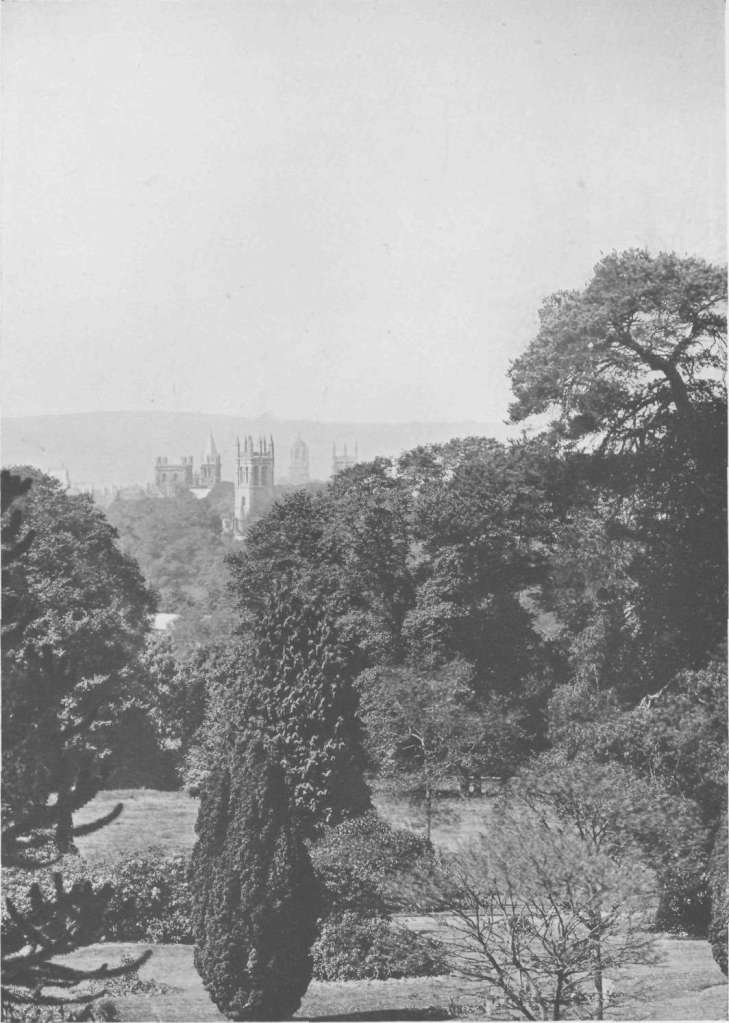
Each of the bishops expressed a desire to reply to the sermon, but neither of them was allowed to do so, and they were led to the place of execution. Ridley was told that if he would recant, his life would be spared, but he replied, “So long as the breath is in my body I will never deny my Lord Christ and His known truth. God’s will be done in me.”
His companion, Latimer, before he removed his prison dress, looked like a withered and bent old man, but afterwards appeared quite changed, and stood upright, “as comely a father as one might lightly behold.” He distributed several small articles he had about him amongst his friends who stood near him, and said, “Well, there is nothing hid but it shall be opened”—a remark he had often made before—and then he prayed aloud to the Almighty, concluding with the words, “I beseech Thee, Lord God, take mercy on this realm of England, and deliver the same from all her enemies.”
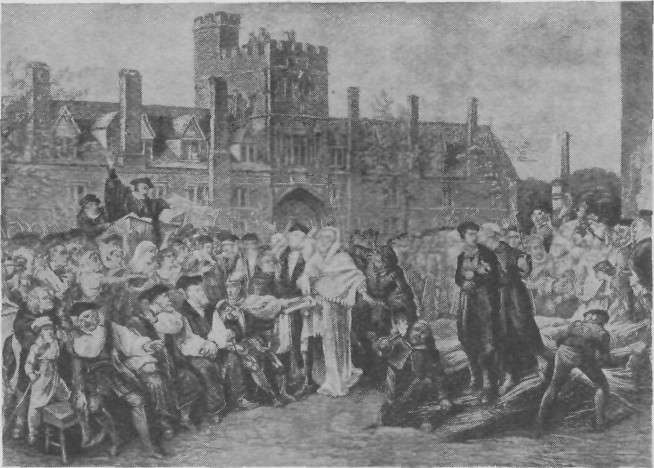
THE BURNING OF RIDLEY AND LATIMER
After embracing each other they were chained to the stakes, and the faggots of wood piled around them, while a brother-in-law tied a bag of gunpowder round Ridley’s neck. As the fires were being lighted, the brave old Latimer uttered these memorable words:
“Be of good comfort, Master Ridley, and play the man! We shall this day light such a candle in England as I trust shall never be put out!”
He then received the flame in his hands, as if embracing it, and, stroking his face with it, died apparently without pain.
Ridley lived longer, but when the powder exploded, he fell dead at Latimer’s feet. Latimer had often prayed during his imprisonment that he might shed his heart’s blood for the truth, and that God would restore His gospel to England, and preserve the Lady Elizabeth. As his body was consumed, the bystanders were astonished at the quantity of blood that gushed from his heart. His words proved to be prophetic, for the fires of the martyrs restored the light to their country, and spread like wildfire throughout the land, carrying all before them. How strong must have been their belief when, with the offer of life held out to them, they elected to die for the faith “which is in Christ Jesus.”
Cranmer had signed a recantation and was brought to St. Mary’s Church to proclaim his adhesion to the Roman faith, but instead of doing so, he created a great sensation by boldly repudiating all he had said in favour of Romish assumption. He said it was contrary to the truth; and “as for the Pope,” he continued. “I refuse him as anti-Christ.” A great uproar followed. The preacher shouted, “Stop the heretic’s mouth!” and Cranmer was immediately led out to be burnt, suffering death on that same day, March 21, 1556. A portion of the stake to which he was fastened and the band of iron which was placed round his waist were still preserved at Oxford.
Mary, who was Queen of England at that time, was a zealous Roman Catholic, and the Reformers were looked upon as heretics, and punished accordingly. So many of them were executed during her reign, that she became known to history as “Bloody Mary.” Her sister Elizabeth was known to favour the Protestants, and as she would follow as Queen of England, her life was often in danger. It was for her preservation that Latimer so often prayed. Mary’s reign was a short one, but Elizabeth was spared to reign over England for the long period of forty-four years. Foxe’s Book of Martyrs describes the horrible sufferings of many of these martyrs, and, though an awful book to read, was one of the few books extensively published in our early days, chained copies being placed in many churches, some of which we saw on our journey.
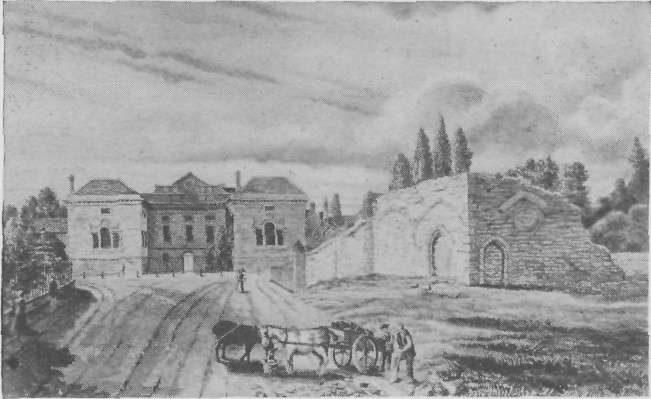
BEAUMONT PALACE IN 1832: THE BIRTHPLACE OF RICHARD I.
A small group of excited people were standing near the Martyrs’ Memorial, and we passed several others in the city. On inquiry we were informed that the body of a murdered woman had been found during the night, on the Banbury road. On hearing this news I must confess to feeling some slight apprehension when I considered the strong prima facie case that could have been made against us: our travel-stained appearance, faces bronzed almost to the colour of the red soil we had walked over, beards untrimmed and grown as nature intended them, clothes showing signs of wear and tear, our heavy oaken sticks with worn ferrules, and our suspicious and seedy-looking bags; our late arrival last night, and, above all, the fact that we had entered the town by the very road on which the murder had been committed! What if we were arrested on suspicion! I had been practically arrested under far less suspicious circumstances the previous year, when we were walking home from London.

“THE HIGH,” WITH QUEEN’S COLLEGE.
Just before reaching Nottingham we saw a large concourse of people in an open space some distance away from our road; out of curiosity we went to see what was going on, and found it to be a cricket match just finishing. Two men in the crowd to whom we spoke told us that great interest was being taken in the match, as a man named Grace was taking part in the game. We waited till the end, and came along with the two men towards the town. We had to cross the bridge over the River Trent, and my brother had already crossed when he found I was not following. So he turned back, and saw me talking to a policeman in the centre of the bridge. “What’s the matter?” he shouted, and I replied, “He wants to look in my bag.” My brother made use of some expression quite unusual to him, and a regular war of words ensued between him and the officer; as we declined to open the bag, he requested us to follow him to a small temporary police office that had been built on the side of the bridge. Meantime a crowd of men had collected and followed us to the station; every pane of glass in the office windows was occupied by the faces of curious observers. The officer quite lost his temper, saying that he had had men like us there before. We asked him to break the bag open, but he declined to do so, and made himself very disagreeable, which caused my brother to remark afterwards that we ought to have thrown him over the parapet of the bridge into the river below, if only to cool his temper. It would have pleased us to stay and fight the matter out, but we had a friend meeting us at Buxton to accompany us on the last day’s march home, and were obliged to give in on that account; so we opened the bag, and it was amusing to see the crestfallen appearance of the officer when he saw the contents, and his fiery temperature almost fell below zero when we told him we should report the matter to his chief. We heard in the town that some of the squires on that side of Nottingham had been troubled with poachers on their estates, and the police had orders to examine all persons with suspicious-looking parcels coming into the town by that road, whether by vehicles or on foot. About a fortnight before our adventure the same policeman had stopped a man who was carrying a similar bag to mine, and found in it a complete set of housebreaker’s tools. He had been complimented by the magistrates for his smart capture, so possibly our reluctance to open the bag, and its similarity to that carried by the housebreaker, had confirmed him in his opinion that he was about to make a similar capture. Another thought, however, that occurred to me was that the man I was walking with might be “known to the police,” as I noticed he disappeared in the crowd immediately the officer approached. But be that as it may, we wrote to the Chief Constable of Police at Nottingham soon after we reached home, who replied very civilly, and said he hoped we would not proceed with the case further, as just then the police in that neighbourhood had very difficult duties to perform, and so the matter ended.
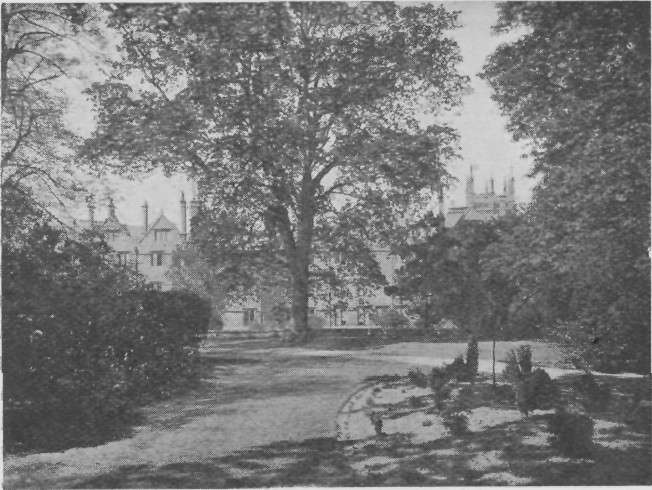
But to return to Oxford. My brother only smiled at my fears, and remarked that being apprehended by the police would only be a small matter compared with being taken to prison and put on the treadmill, a position in which he boasted of having once been placed. When he happened to mention this to a tramp on the road, I was greatly amused to hear the tramp in a significant and confidential tone of voice quietly ask, “What was you in for?”
He was only a small boy at the time, and had gone with our father, who was on the jury, to the county prison. Part of the jury’s business in the interval was to inspect the arrangements there, which of course were found in applepie order. My brother was greatly impressed by his own importance when the man in livery at the head of the procession repeatedly called to the crowd, “Make way for the Grand Jury!” He saw the prisoners picking “oakum,” or untwisting old ropes that had been used in boats, tearing the strands into loose hemp to be afterwards used in caulking the seams between the wood planks on the decks and sides of ships, so as to make them water-tight; and as it was near the prisoners’ dinner-time, he saw the food that had been prepared for their dinner in a great number of small tin cans with handles attached, each containing two or three small pieces of cooked meat, which he said smelled very savoury.
Finally they came to the treadmill, and as no prisoners were on it, some of the jury expressed a wish to try it; one of the jurymen seeing my brother, who was the only child present, kindly took him on and held him by the hand. When all were in position the wheel was started slowly, and as one step went down they mounted the next, and so on up the stairs, but they never got to the top! The steps creaked under them as the wheel turned slowly round, and a prison officer stood behind them with a big stick, which he was careful not to use on any of the jurymen, though my brother heard him say he had to use it sometimes on the prisoners. As the wheel turned round it moved some kind of machinery which they could not see.

But to return to Oxford again. We were not suspected of being concerned in the murder, nor did we venture to inquire whether the culprit had been found, for fear that we might be suspected of being concerned in the case; but if a police raid had been made on the Oxford Temperance Hotel—most unlikely thing to happen—we should have been able to produce a good record for that day, at any rate, for we attended four different services in four different places of worship. The first was at Christ Church, whither we had been advised to go to listen to the choir, whose singing at that time was considered to be the best in Oxford. Certainly the musical part of the service was all that could be desired. There were more than twenty colleges at Oxford, and we had a busy day, for between the services we looked through the “Quads,” with their fine gardens and beautiful lawns, hundreds of years old. In the services, every phase of religious thought in the Church of England seemed to be represented—the High Church, the Low Church, and the Broad Church; and many men in all vocations and professions in life had passed through the colleges, while valuable possessions had been bequeathed to them from time to time, until Oxford had become a veritable storehouse of valuable books, pictures, and relics of all kinds, and much of the history of the British Empire seemed to have been made by men who had been educated there. It would have taken us quite a week to see Oxford as it ought to be seen, but we had only this one day, and that a Sunday.
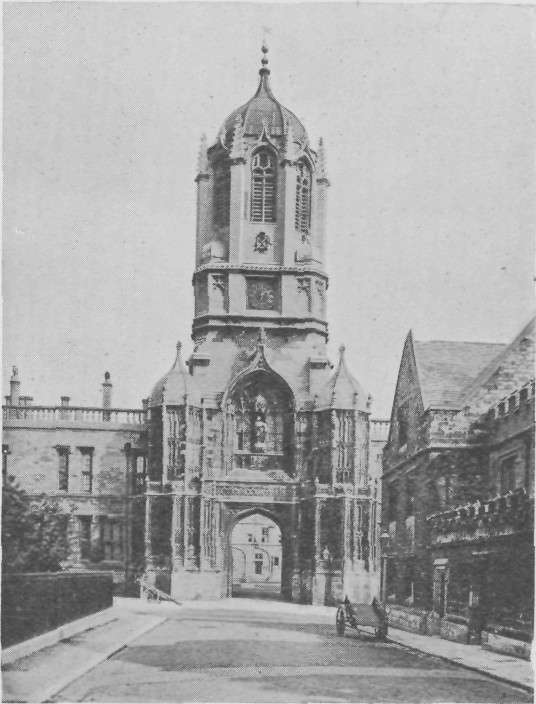
TOM TOWER, WITH WOLSEY STATUE.
Christ Church, where we went to our first service, one of the finest buildings in Oxford, was founded by the great Wolsey in the reign of Henry VIII. It contains the statue and portrait of the Cardinal, and in the Library his Cardinal’s Hat, also his Prayer Book—one of its most valued possessions, beautifully illuminated and bound in crimson velvet set with pearls and dated 1599. The famous bell of Christ Church, known as the “Great Tom,” weighing about 17,000 lbs., is tolled every night at five minutes past nine o’clock—101 times, that being the original number of the students at the college—and at its solemn sound most of the colleges and halls closed their gates. The students were formerly all supposed to be housed at that hour, but the custom is not now observed—in fact, there was some doubt about it even in the time of Dean Aldrich, the author of the well-known catch, “Hark! the bonny Christ Church bells,” published in 1673:
Hark the bonny Christ Church Bells
1 2 3 4 5 6—
They sound so wondrous great, so woundy sweet
As they trowl so merrily, merrily.
Oh! the first and second bell.
That every day at four and ten, cry,
“Come, come, come, come to prayers!”
And the verger troops before the Dean.
Tinkle, tinkle, ting, goes the small bell at nine.
To call the bearers home;
But the devil a man
Will leave his can
Till he hears the mighty Tom.
The great bell originally belonged to Oseney Abbey, and hung in the fine cupola over the entrance gate, named after it the “Great Tom Gate,” and had been tolled every night with one exception since May 29, 1684.
The statue of Wolsey, which now stood over the gateway, was carved by an Oxford man named Bird in the year 1719, at the expense of Trelawny, Bishop of Winchester, one of the seven bishops and hero of the famous ballad—
And shall Trelawny die?
At the time of the Restoration Dr. John Fell was appointed Vice-Chancellor, and he not only made the examinations very severe, but he made the examiners keep up to his standard, and was cordially hated by some of the students on that account. An epigram made about him at that time has been handed down to posterity:
I do not like thee, Dr. Fell;
The reason why I cannot tell;
But this I know, and know full well,
I do not like thee, Dr. Fell.
William Penn, the Quaker, the famous founder of the Colony of Pennsylvania, “came up” to Christ Church in 1660, but was “sent down” in 1660 for nonconformity.
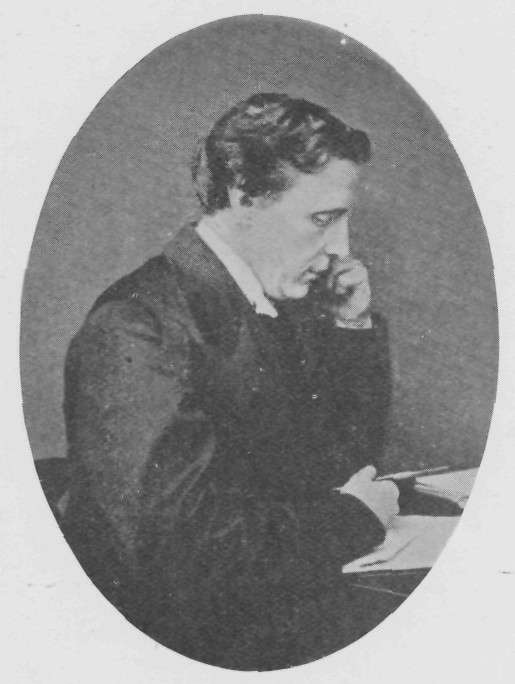
But we were more interested in a modern student there, C.L. Dodgson, who was born in 1832 at Daresbury in Cheshire, where his father was rector, and quite near where we were born. There was a wood near his father’s rectory where he, the future “Lewis Carroll,” rambled when a child, along with other children, and where it was thought he got the first inspirations that matured in his famous book The Adventures of Alice in Wonderland, which was published in 1865—one of the most delightful books for children ever written. We were acquainted with a clergyman who told us that it was the greatest pleasure of his life to have known “Lewis Carroll” at Oxford, and that Queen Victoria was so delighted with Dodgson’s book Alice in Wonderland, that she commanded him if ever he wrote another book to dedicate it to her. Lewis Carroll was at that time engaged on a rather abstruse work on Conic Sections, which, when completed and published, duly appeared as “Dedicated by express command to Her Most Gracious Majesty Queen Victoria.” The appearance of this book caused some surprise and amusement, as it was not known that the Queen was particularly interested in Conic Sections. No doubt Her Majesty anticipated, when she gave him the command personally, that his next book would be a companion to the immortal Alice.
Our friend the vicar, who told us this story, rather surprised us when he said that Lewis Carroll did not like the sea, and had written a “Sea Dirge,” which, when recited at parochial entertainments, generally brought “down the house” at the conclusion of the ninth verse:
A SEA DIRGE
There are some things like a spider, a ghost.
The income tax, the gout, an umbrella for three.
That I hate, but the thing I hate the most,
Is a thing they call the sea.
Pour some salt water over the floor.
Ugly I’m sure you’ll allow that to be,
Suppose it extended a mile or more,
That would be like the sea.
Beat a dog till it howls outright—
Cruel, but all very well for a spree;
Suppose it did so day and night,
That would be like the sea.
I had a vision of nursery maids,
Tens of thousands passed by me,
Each carrying children with wooden spades,
And that was by the sea.
Who could have invented those spades of wood?
Who was it that cut them out of the tree?
None, I think, but an idiot could—
Or one who loved the sea.
It is pleasant and dreamy, no doubt to float
With thoughts as boundless and souls as free,
But suppose you are very unwell in the boat—
Then how do you like the sea?
Would you like coffee with sand for dregs?
A decided hint of salt in your tea?
And a fishy taste in the very eggs?
Then by all means choose the sea.
And if with such dainties to drink and eat
You prefer not a vestige of grass or a tree,
And a chronic condition of wet in your feet,
Then—I recommend the sea.
There is an animal people avoid.
Whence is derived the verb to flee,
Where have you been by it most annoyed?
In lodgings by the sea.
Once I met with a friend in the street,
With wife and nurse and children three;
Never again such a sight may I meet,
As that party from the sea.
Their looks were sullen, their steps were slow,
Convicted felons they seemed to be,—
“Are you going to prison, dear friend?”—”Oh no;
We’re returning from the sea!”

Every college had some legend or story connected with it, and University College claimed to have been founded by King Alfred the Great, but this is considered a myth; King Alfred’s jewel, however, a fine specimen of Saxon work in gold and crystal, found in the Isle of Athelney, was still preserved in Oxford. Guy Fawkes’s lantern and the sword given to Henry VIII as Defender of the Faith were amongst the curios in the Bodleian Library, but afterwards transferred to the Ashmolean Museum, which claimed to be the earliest public collection of curiosities in England, the first contributions made to it having been given in 1682 by Elias Ashmole, of whom we had heard when passing through Lichfield. In the eighteenth century there was a tutor named Scott who delivered a series of lectures on Ancient History, which were considered to be the finest ever known, but he could never be induced to publish them. In one of his lectures he wished to explain that the Greeks had no chimneys to their houses, and created much amusement by explaining it in his scholarly and roundabout fashion: “The Greeks had no convenience by which the volatile parts of fire could be conveyed into the open air.” This tutor was a friend of the great Dr. Johnson, and seemed to have been quite an original character, for when his brother, John Scott, who was one of his own pupils, came up for examination for his degree in Hebrew and History, the only questions he put to him were, “What is the Hebrew for skull?” to which John promptly replied “Golgotha,” and “Who founded University College?” to which his reply was “King Alfred!” Both the brothers were very clever men, and the tutor developed into Lord Stowell, while the pupil was created Lord Eldon.

THE QUADRANGLE, JESUS COLLEGE.
Jesus, the Welsh College, possessed an enormous silver punch-bowl, 5 feet 2 inches in girth, which was presented in 1732 by the great Sir Watkin Williams-Wynn, who was known as the King in Wales. Over his great kitchen mantelpiece there he had the words “Waste not, want not,” a motto which did not appear to apply to the punchbowl, for the conditions attached to it were that it was to become the property of him who could span it with his arms and then drain the bowl empty after it had been filled with strong punch. The first condition had been complied with, and the second no doubt had been often attempted, but no one had yet appeared who had a head strong enough to drain the bowl without assistance, so it still remained the property of the College!
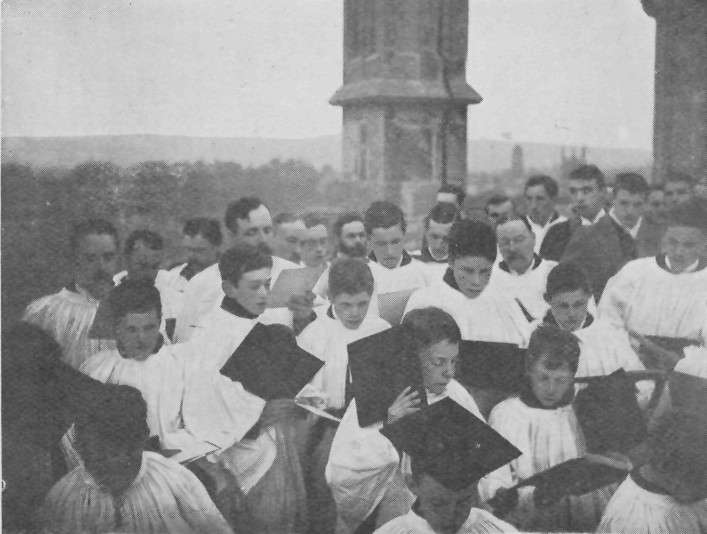
“MAY MORNING”: THE CHOIR ON THE TOWER.
Magdalen College—or Maudlen, as they pronounced it at Oxford—as easily distinguished from the others by its fine tower, rising to the height of 145 feet, the building of which dates from the end of the fifteenth century. We took a greater interest in that college because the rector of Grappenhall in Cheshire, where we were born, had been educated there. An ancient May-day custom is still observed by the college, called the “Magdalen Grace” or the “May Morning Hymn,” this very old custom having been retained at Magdalen long after others disappeared. On May-day morning the choristers ascend to the top of the great tower and enter the portion railed off for them and other men who join in the singing, while the remainder of the space is reserved for members of the University, and other privileged persons admitted by ticket. They wait until the bell has sounded the last stroke of five o’clock, and then sing in Latin that fine old hymn to the Trinity, beginning with the words:
Te Deum patrem colimus.
My brother, however, was sure our rector could never have sung that hymn, since in cases of emergency he always appealed to him to start the singing in the Sunday school—for although a very worthy man in other respects, he was decidedly not musical.
Among the great Magdalen men of the past are the names of Cardinal Wolsey, Cardinal Reginald Pole, Addison, Gibbon, Collins, Wilson, John Hampden, and John Foxe, author of the Book of Martyrs. The ecclesiastical students included two cardinals, four archbishops, and about forty bishops; and my brother would have added to the Roll of Honour the name of our rector, the Rev. Thomas Greenall, as that of a man who conscientiously tried to do his duty and whom he held in lasting remembrance.
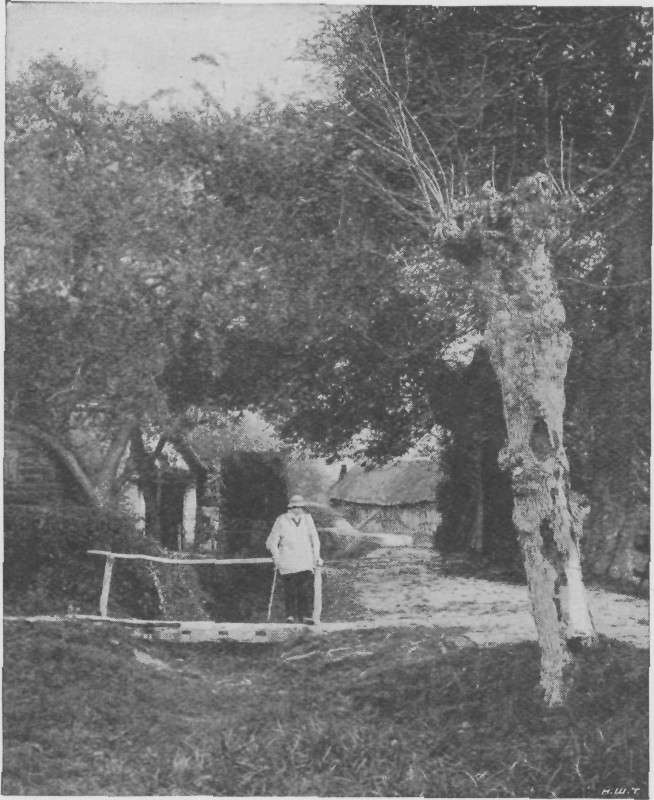
There was a kind of haze hanging over Oxford, which gave me the impression that the atmosphere of the neighbourhood was rather damp, though my brother tried to persuade me it was the mist of antiquity; but when I found the rivers Thames (or Isis) and the Cherwell encircled the city on three sides, and that its name was derived from a passage over which oxen could cross the water, and when I saw the stiff clay of the brickfields, I was confirmed in my opinion.

As early as the year 726 a prince named Didan settled at Oxford, and his wife Saxfrida built a nunnery there for her daughter Frideswyde, so that she could “take the veil” in her own church. As she was considered the “flower of all these parts,” we could not understand why this was necessary, especially as she was sought in marriage by Algar, King of Leicester, described as “a young and spritely prince,” and who was so persistent that he would not accept her refusal, actually sending “ambassadors” to carry her away. These men, however, when they approached her were smitten with blindness; and when Frideswyde saw that she would not be safe in “her own church” nor able to remain in peace there, she fled into the woods and hid herself in a place that had been made as a shelter for the swine. King Algar was greatly enraged, and, breathing out fire and sword, set out for Oxford. As he still pursued her, he too was smitten with blindness; and she then returned, but did not live long, as she died in 739. St. Frideswide’s Chapel was said to have been built over her shrine, around which Oxford, the “City of the Spires,” had extended to its present proportions.
Oxford is also mentioned in A.D. 912 in the Saxon Chronicle, and Richard Coeur de Lion, the great Crusader, was born there in 1156, and often made it his home. The city was besieged on three different occasions—by Sweyne, the King of Denmark, in 1013, by William the Conqueror in 1067, and by Fairfax in 1646—for it was one of the King’s great strongholds.
READ ALL CHAPTERS HERE – FROM JOHN O’ GROAT’S TO LAND’S END (OR 1372 MILES ON FOOT)
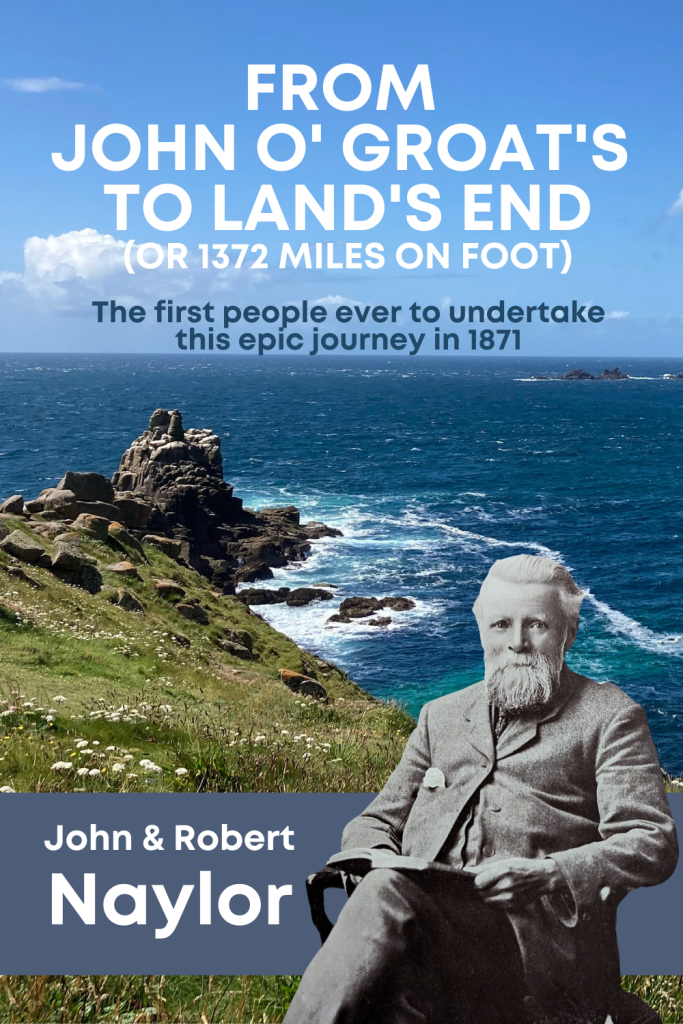
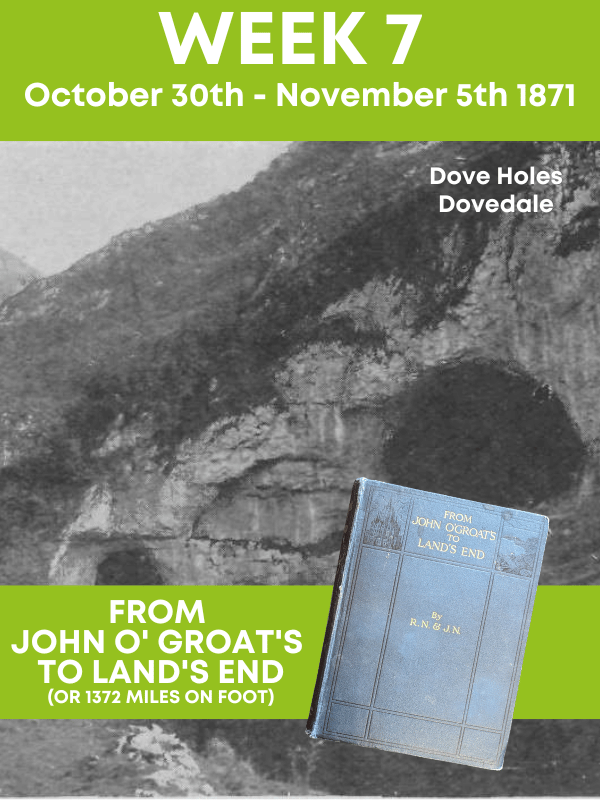
Leave a comment